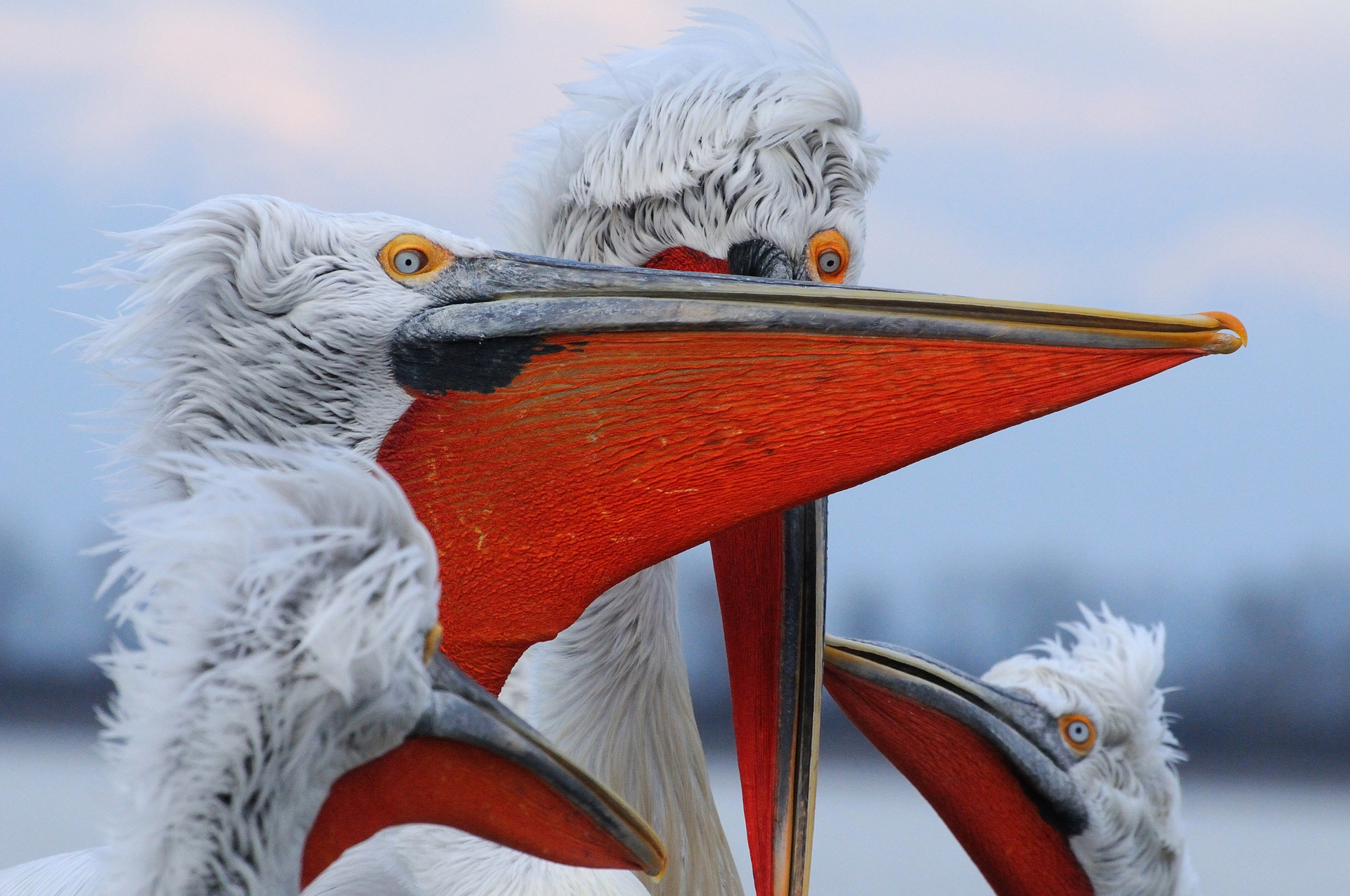DAY 1
Finally it’s time to turn back to northeastern Greece on one of our favorite wildlife expeditions, together with the one in Andalusia.
The group begins to meet at Fiumicino airport first, and then at Thessaloniki airport. We pick up Antonio in the city and drive the short route that will lead us to Lake Kerkini. In the late afternoon light, between the city center and the outskirts of Thessaloniki, even from the car, we make the first interesting observations: the alien Monk Parakeets (Myiopsitta monachus) and, above all, many Rooks (Corvus frugilegus).
The journey proceeds serenely, we aim to arrive on the shores of the lake, for a first welcome view, with the light of sunset. Fortunately something doesn’t make us respect the roadmap.
Rook. Photo by Valerio Russo.
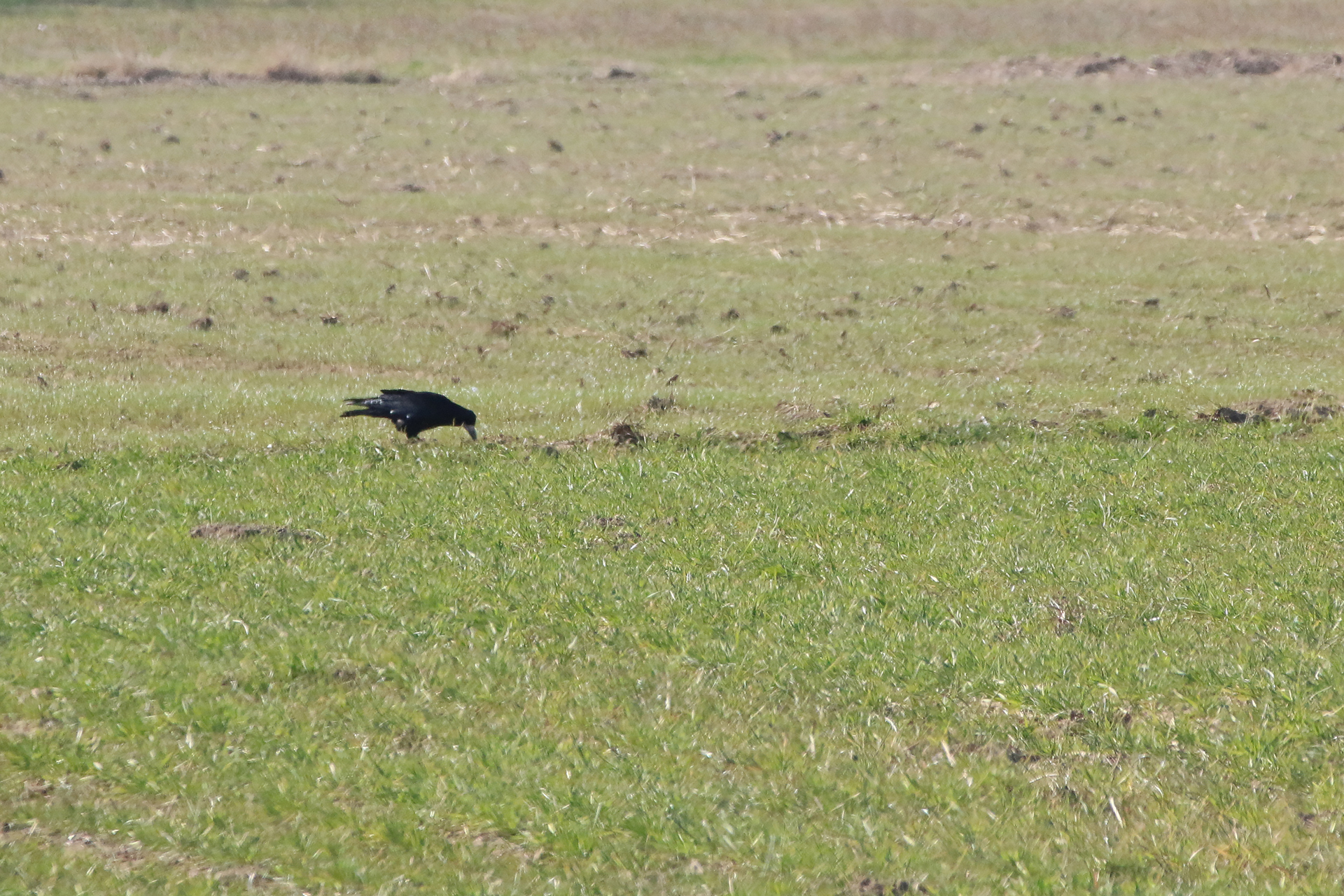
Just a few kilometers away from the destination when Valerio and Tommaso see a animal that, in the dim light of the beginning of the evening, crosses the road very imprudently, right between a truck and two cars. Jackal! This is our first thought, partly because we were talking to the participants about this species, partly because we were probably influenced by the story of Goldie, the road accident victim jackal that we had helped to save in one of the previous tours.
However, as we get closer, we notice that it is a very different species. We recognize the shape of a cat. This remains on the roadside. We pass slowly because we hope to detect some diagnostic character. Valerio doesn’t have too many doubts: it is a Wildcat (Felis silvestris)!!
It is a species that we had already had the good fortune to observe on the roadside in one of the previous editions. Even then we thought that we had witnessed an extraordinary scene and that we had been very lucky …. but twice: wow!
Participants have the opportunity to get out of the car and observe the animal which, for a few seconds, remains staring at us. Antonio even manages to take a quick photo.
European Wildcat. Photo by Antonio Bonini.
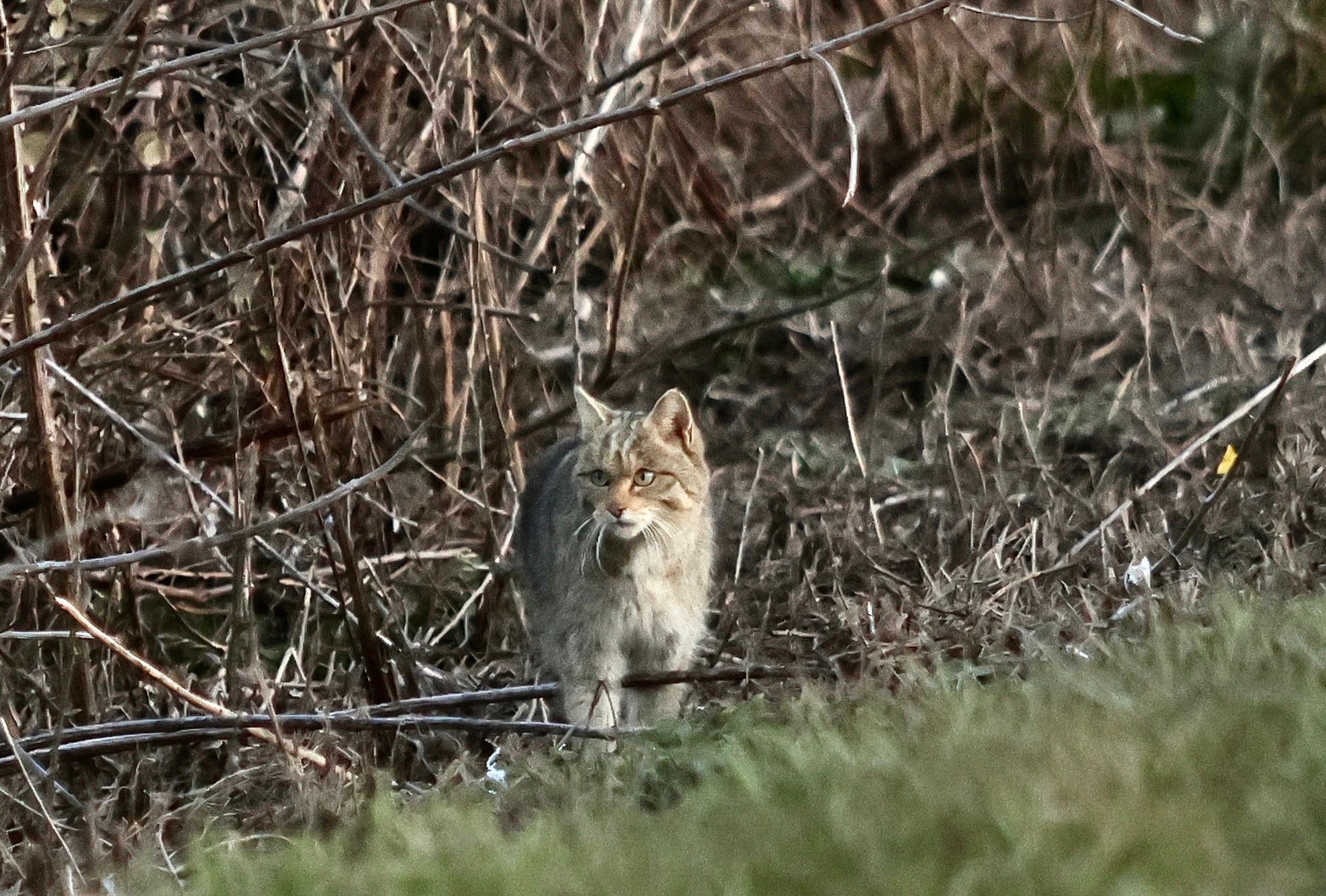
Great, we couldn’t have started better. “It will be difficult to maintain such a level for the entire duration of the expedition”, we comment jokingly (but perhaps not too much) during dinner.
A Fox (Vulpes vulpes) peeps out in the parking lot of the restaurant, it’s time to go back to the cozy guest house that hosts us to fill up on warmth and energy. The following day, an icy adventure awaits us that will begin even before dawn.
DAY 2
It’s still pitch dark when we get into the cars to head to the harbour. Car windshields are frozen and the thermometer does not exceed -4 C degrees. Vasilis the Pelican Man as they call him at Kerkini awaits us at the boat.
We leave towards the center of the lake and the first Dalmatian Pelicans (Pelecanus crispus) are already approaching and, hoping to beg for some fish, they begin to escort the boat. Some even climb into the boat and parasol. They don’t know that “unfortunately for them” we do not feed the animals on our tours
In the silence of the dawn that begins to appear, you can hear the noise of hundreds of shots, with all due respect to the frozen fingers. All participants manage to get magnificent shots while Captain Vasilis shares with us all his deep knowledge about these birds.
Dalmatian Pelican. Photo by Valerio Russo.
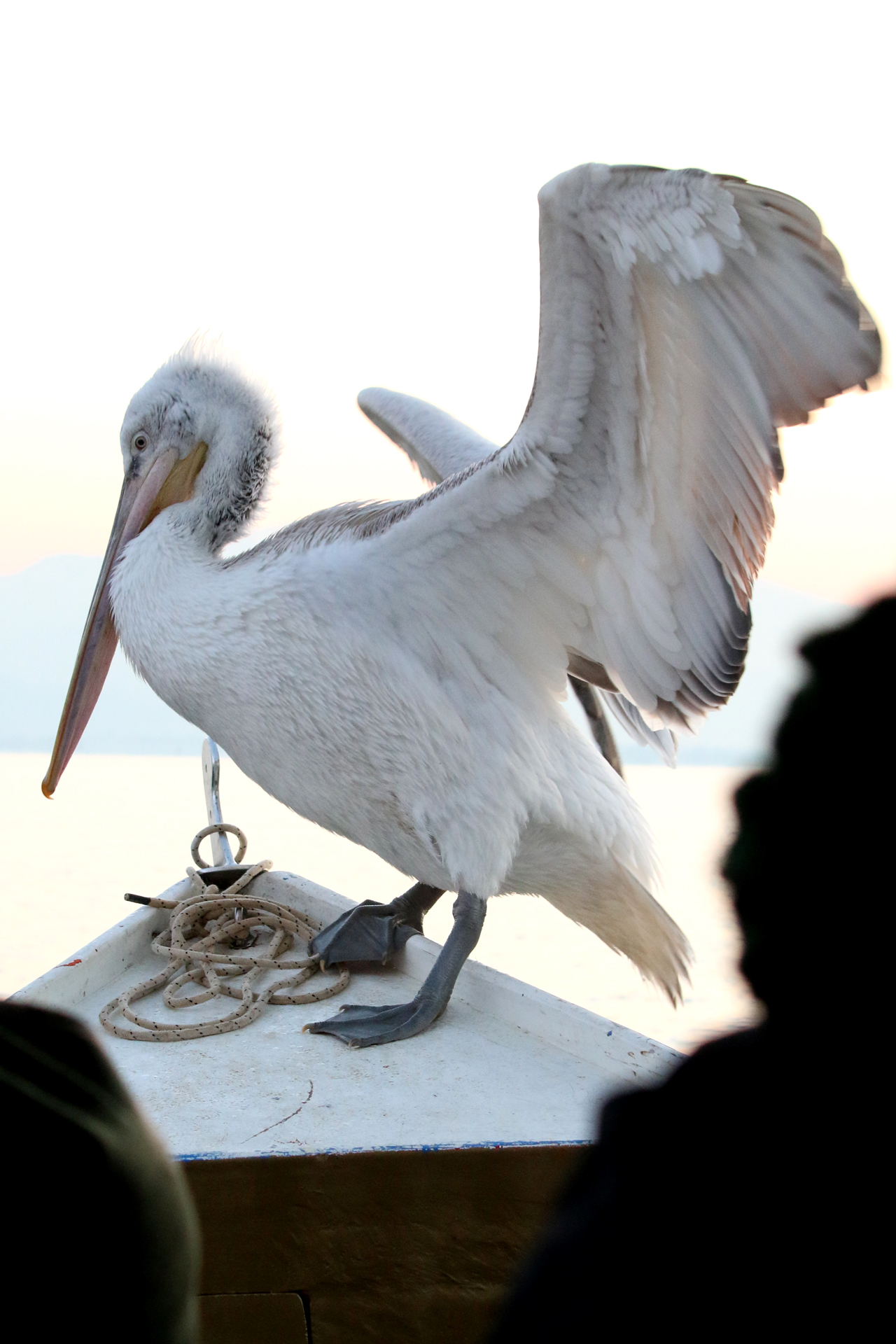
Dalmatian Pelican. Photo by Valerio Russo.
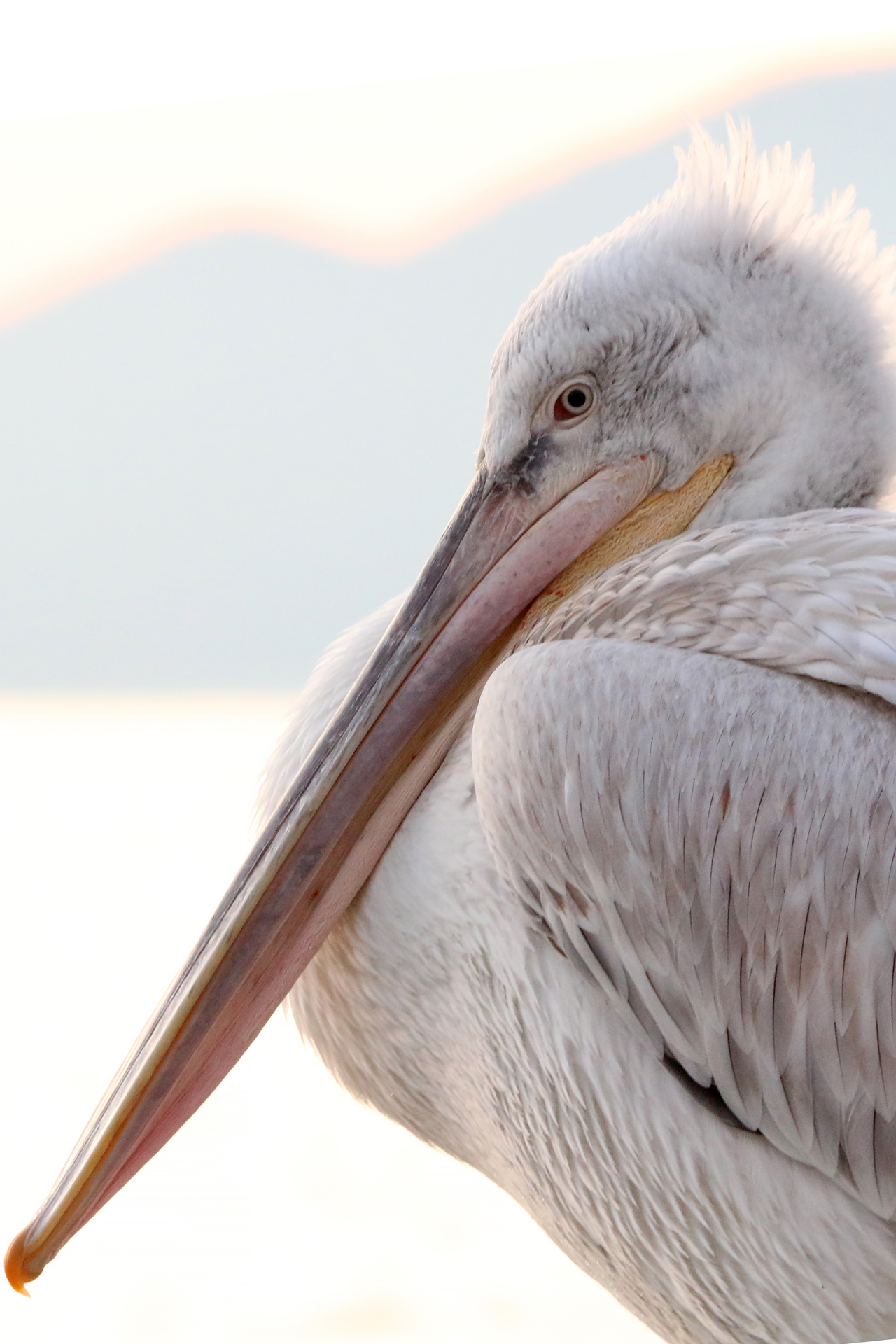
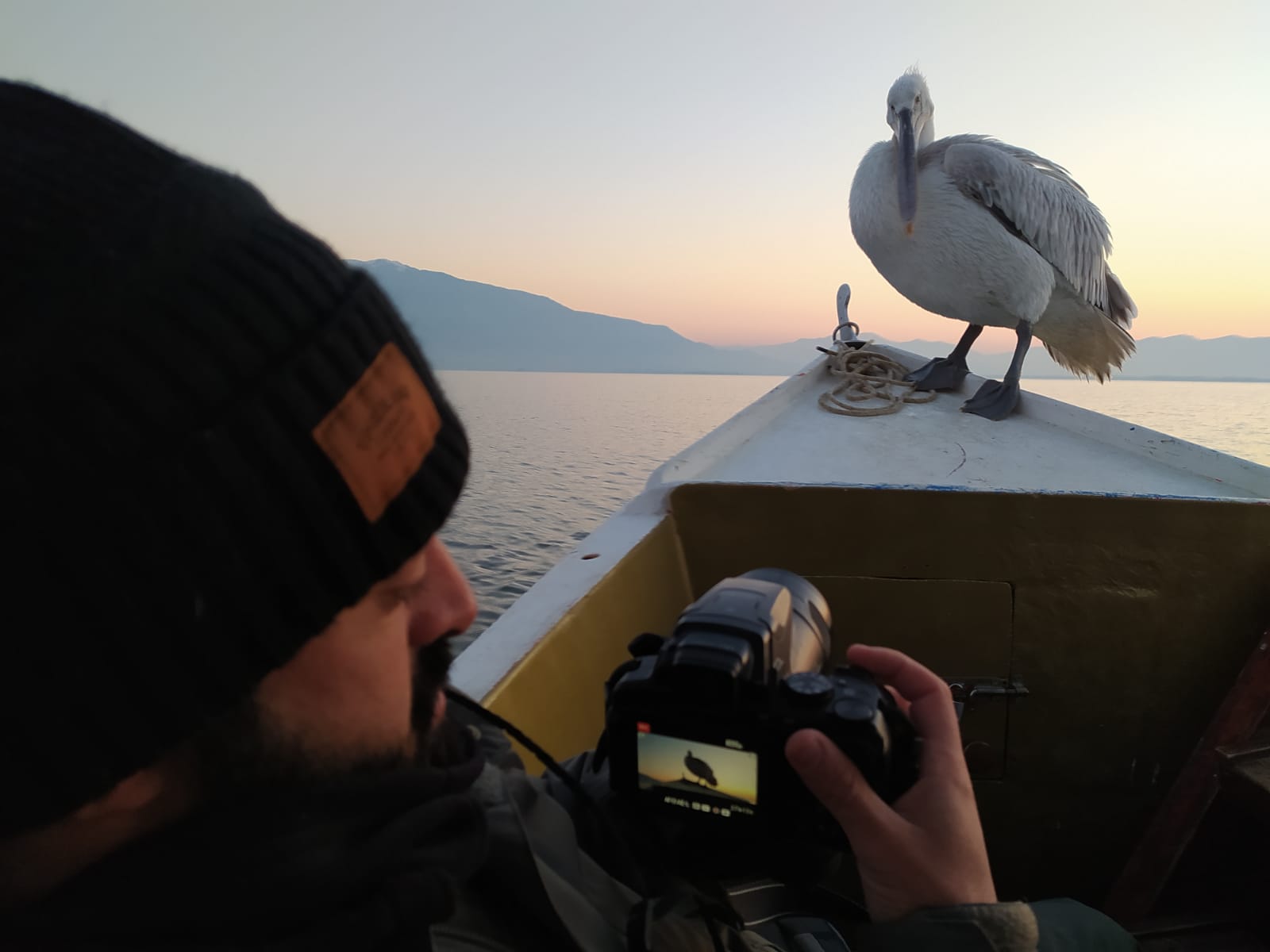
Dalmatian Pelican. Photo by Doriano Spinelli.
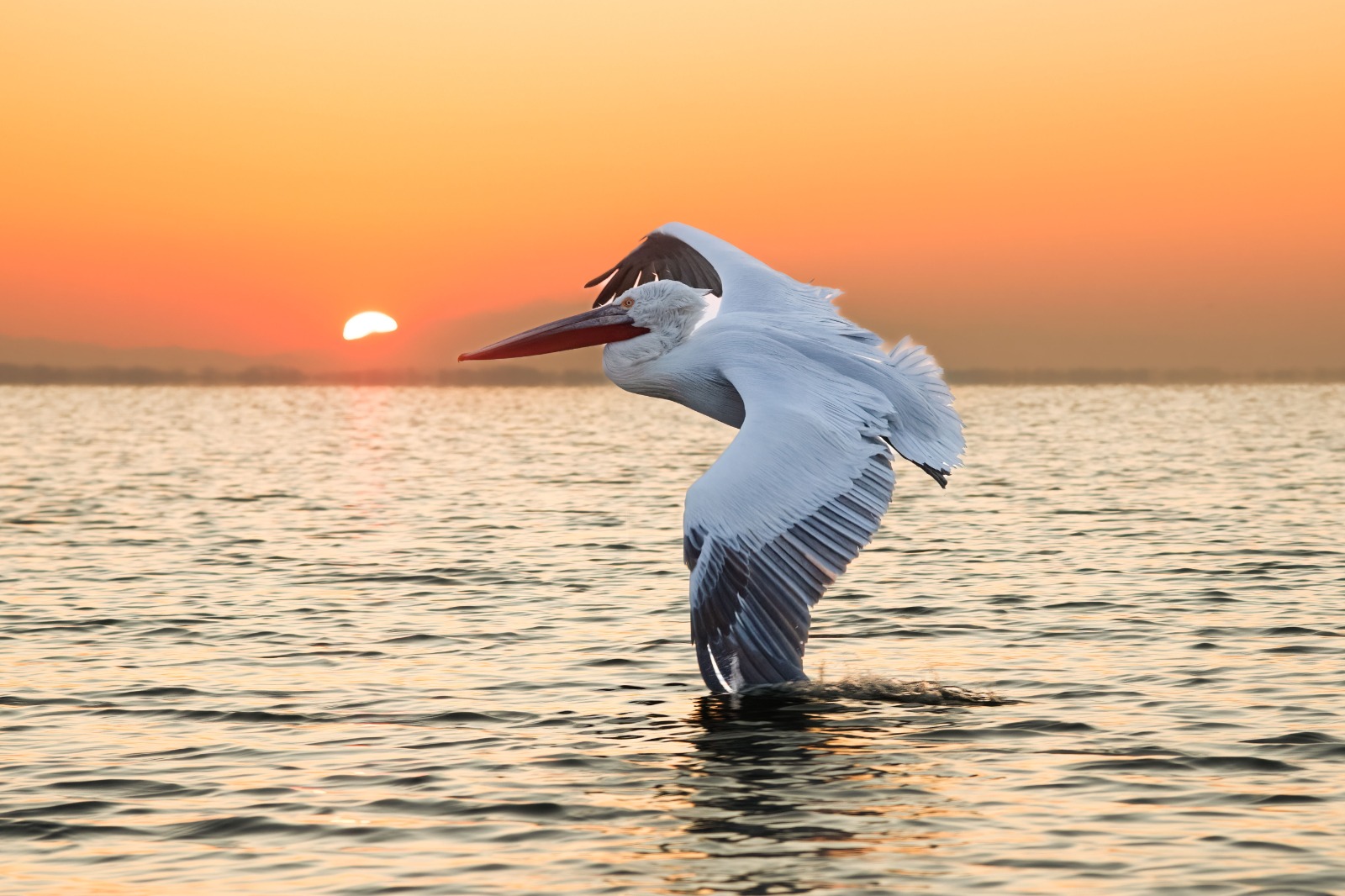
For example, he tells us about the banded specimens and the functioning of the new GPS devices, which he helped to apply on the wings of some birds, as part of the “Pelican way of LIFE” project, the main conservation action for the species in Europe and on a global scale connecting as many as 27 sites across Romania, Bulgaria, Greece and Ukraine, as well as supporting research in Turkey, Albania, Montenegro and North Macedonia.
Satellite telemetry and marking the Dalmatian Pelicans with color rings and wing tags help to collect information about movements, dispersal, and home range of the birds, as well as to monitor species survival rates, identify mortality factors, and more. For this purpose juvenile and adult individuals are trapped at roosting and feeding sites in Bulgaria, Romania, and Greece, including Lake Kerkini.
Tagged Pelican. Photo by Andrea Senese.
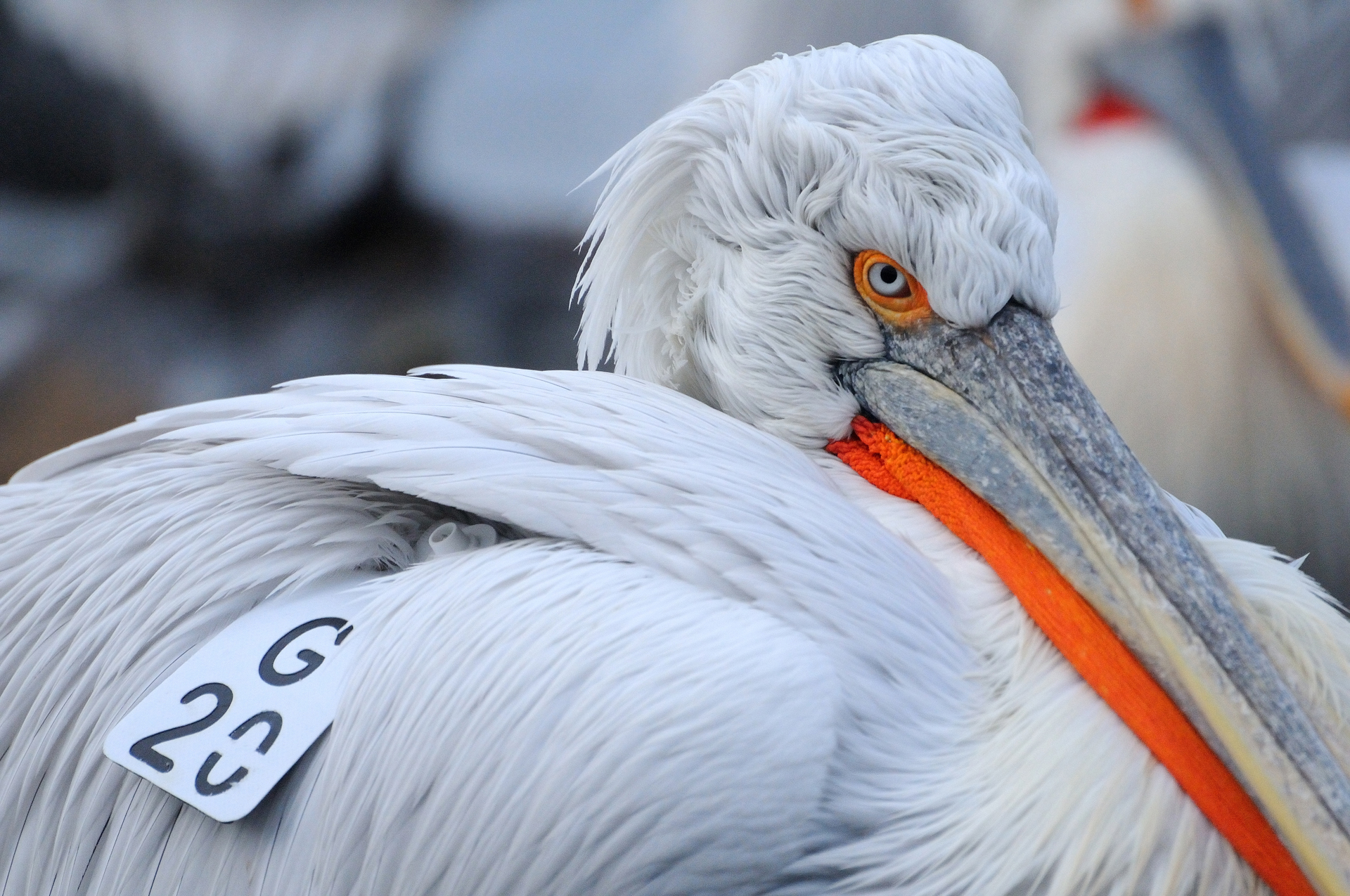
Dalmatian Pelican. Photo by Andrea Senese.
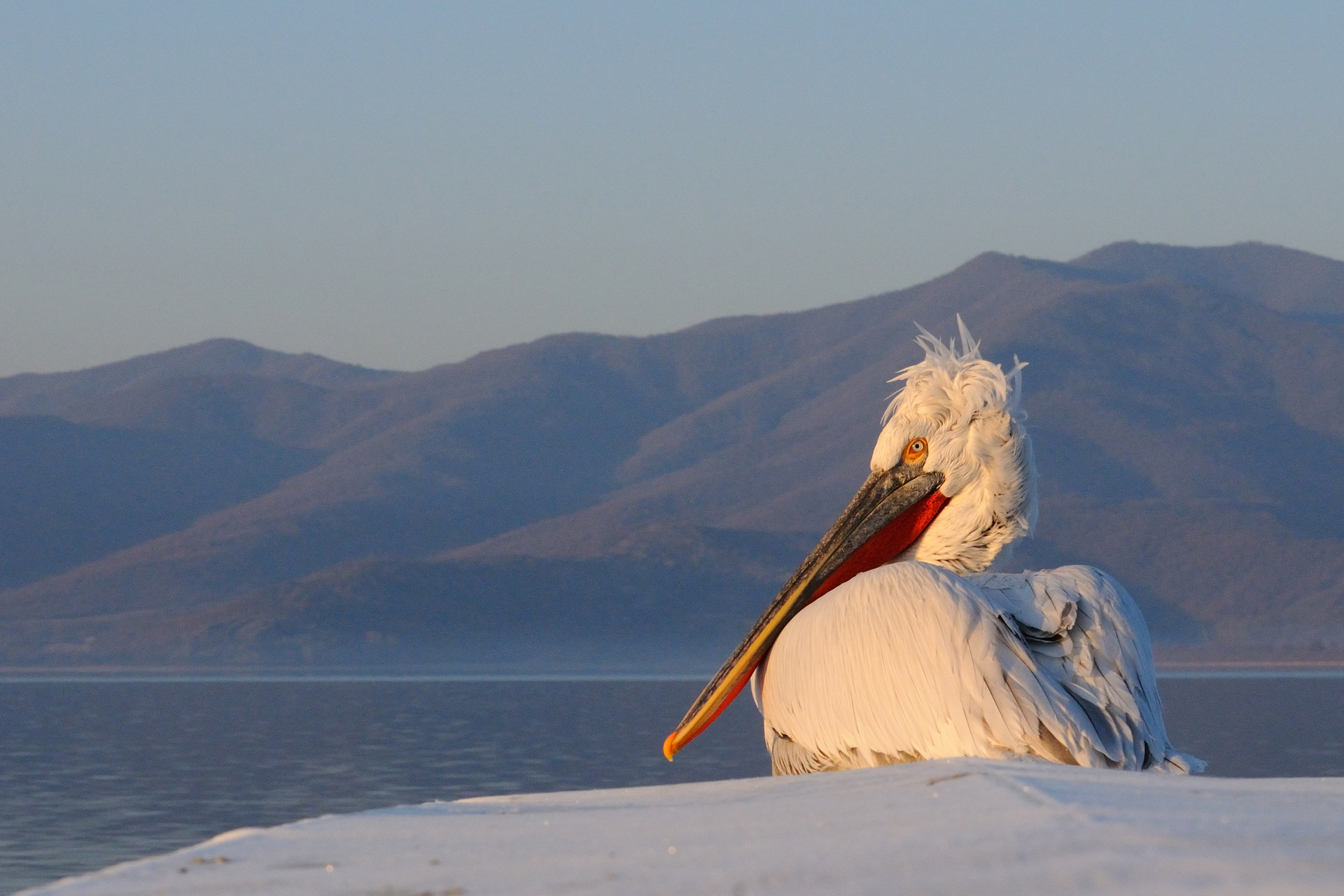
Dalmatian Pelicans aren’t the only target on this morning’s boat ride. In fact, we head towards the areas with shallower water where hundreds of Greater Flamingos (Phoenicopterus roseus) are intent on foraging. Over the years, Vasilis tells us, the number of individuals reaching the lake has continuously increased.
We don’t get too close so as not to disturbe these awesome birds from the breakfast in progress, but thanks to the skilful maneuvers of our boat we manage to get interesting photos from different angles.
Greater Flamingos. Photo by Valerio Russo.
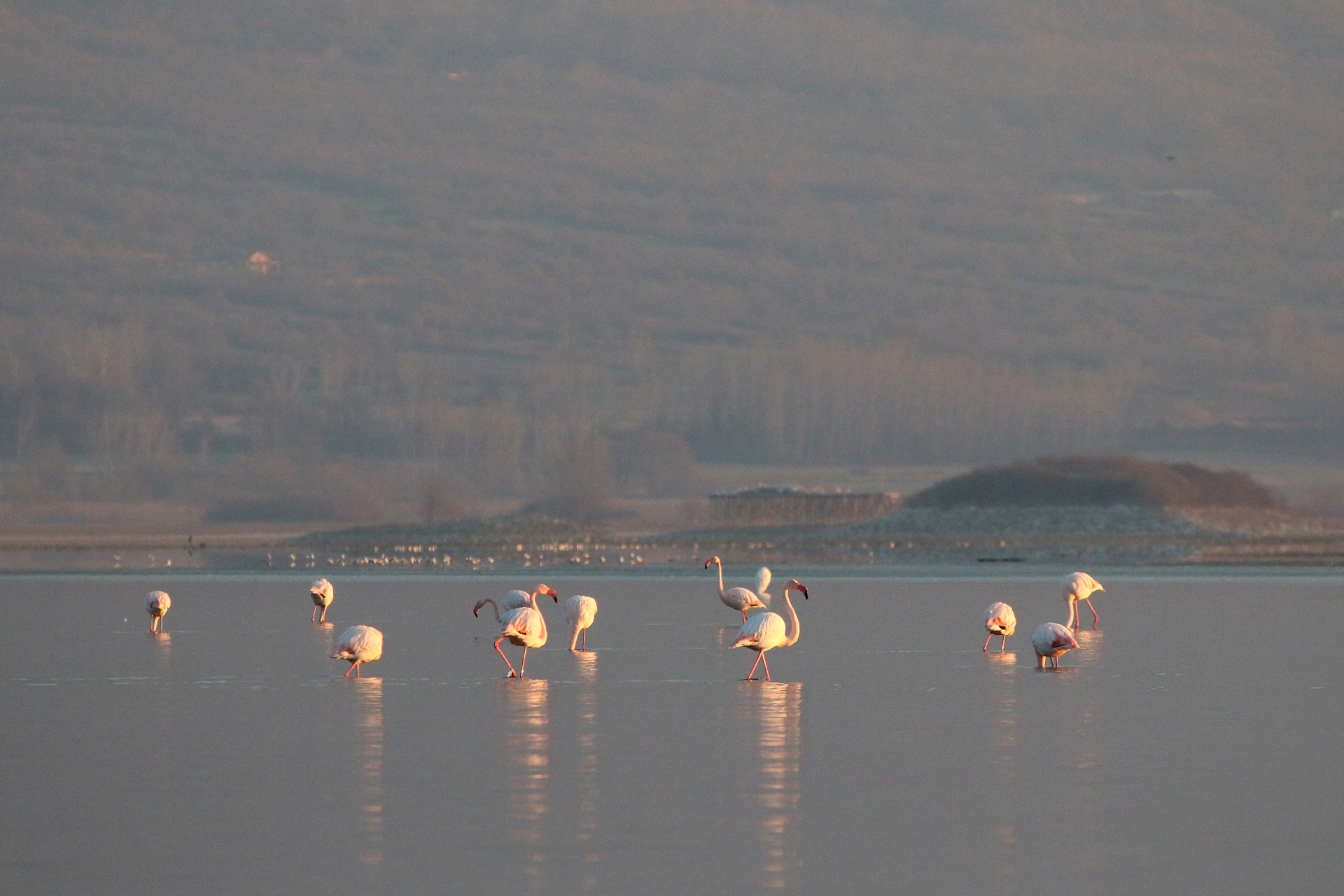
Great Cormorants. Photo by Gabriella Motta.
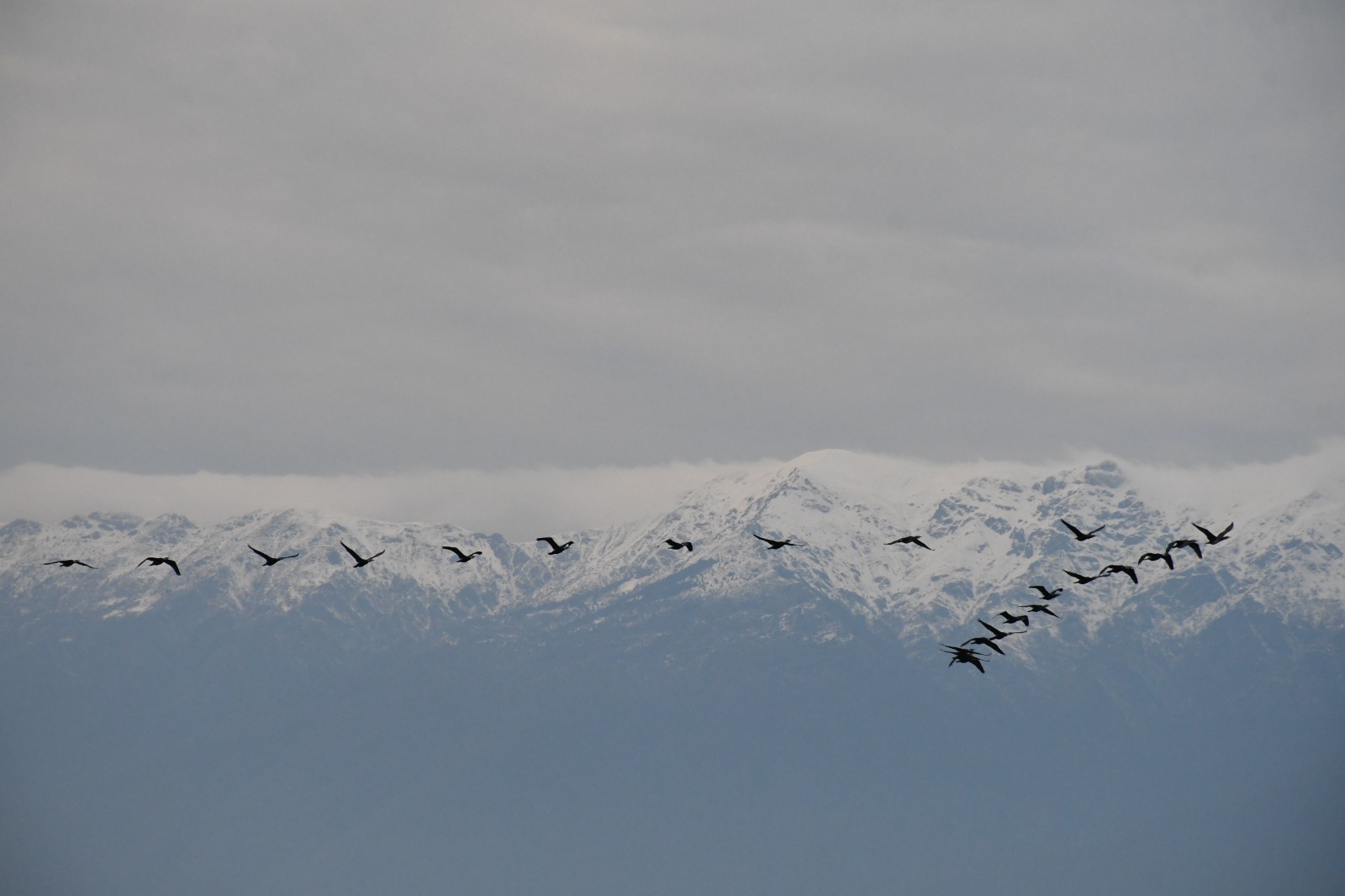
Great Egrets. Photo by Valerio Russo.
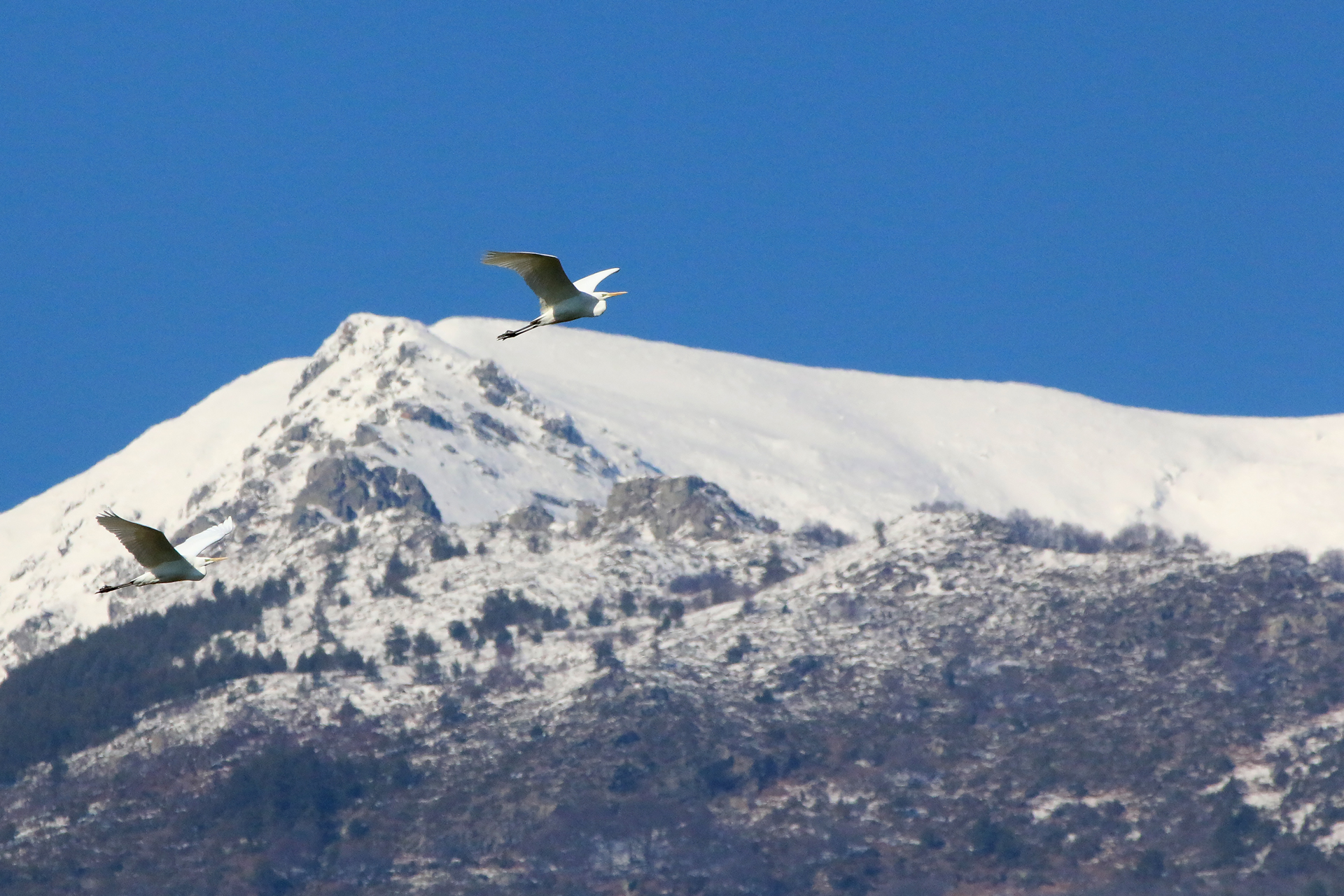
More than satisfied with the beginning of the day we return to the port, sighting among the many species present, several individuals of the Pigmy Cormorant (Mycrocarbus pygmaeus). Once landed, near the shore we see a group of about 20 resting individuals of Common Pochard (Aythia ferina),
We don’t stay too long to observe them, we know that we will encounter this species again in much higher concentrations. Now the priority is to go back to the structure to “defrost” and fill up on energy with one of our favorite breakfasts.
Pigmy Cormorant. Photo by Valerio Russo.
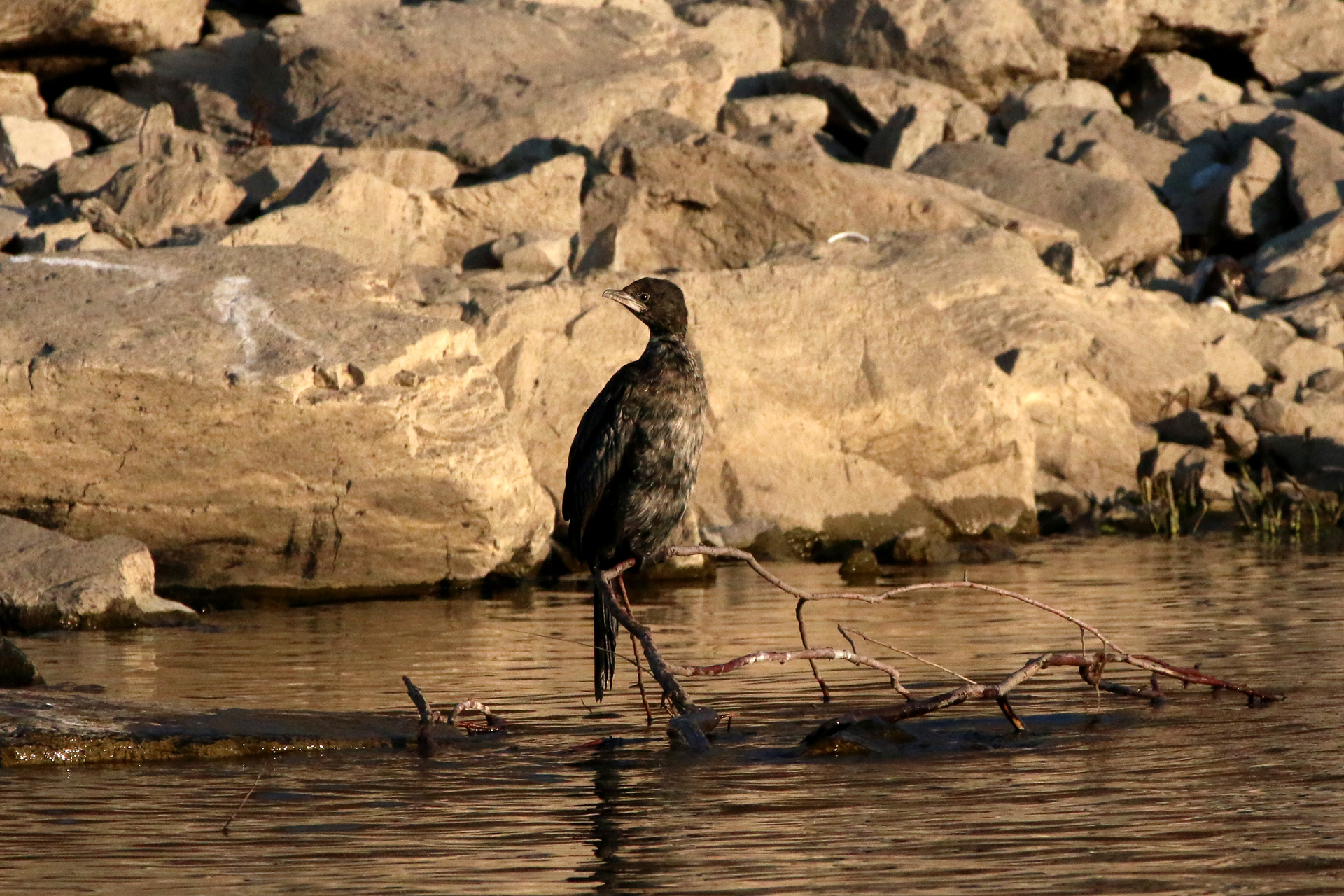
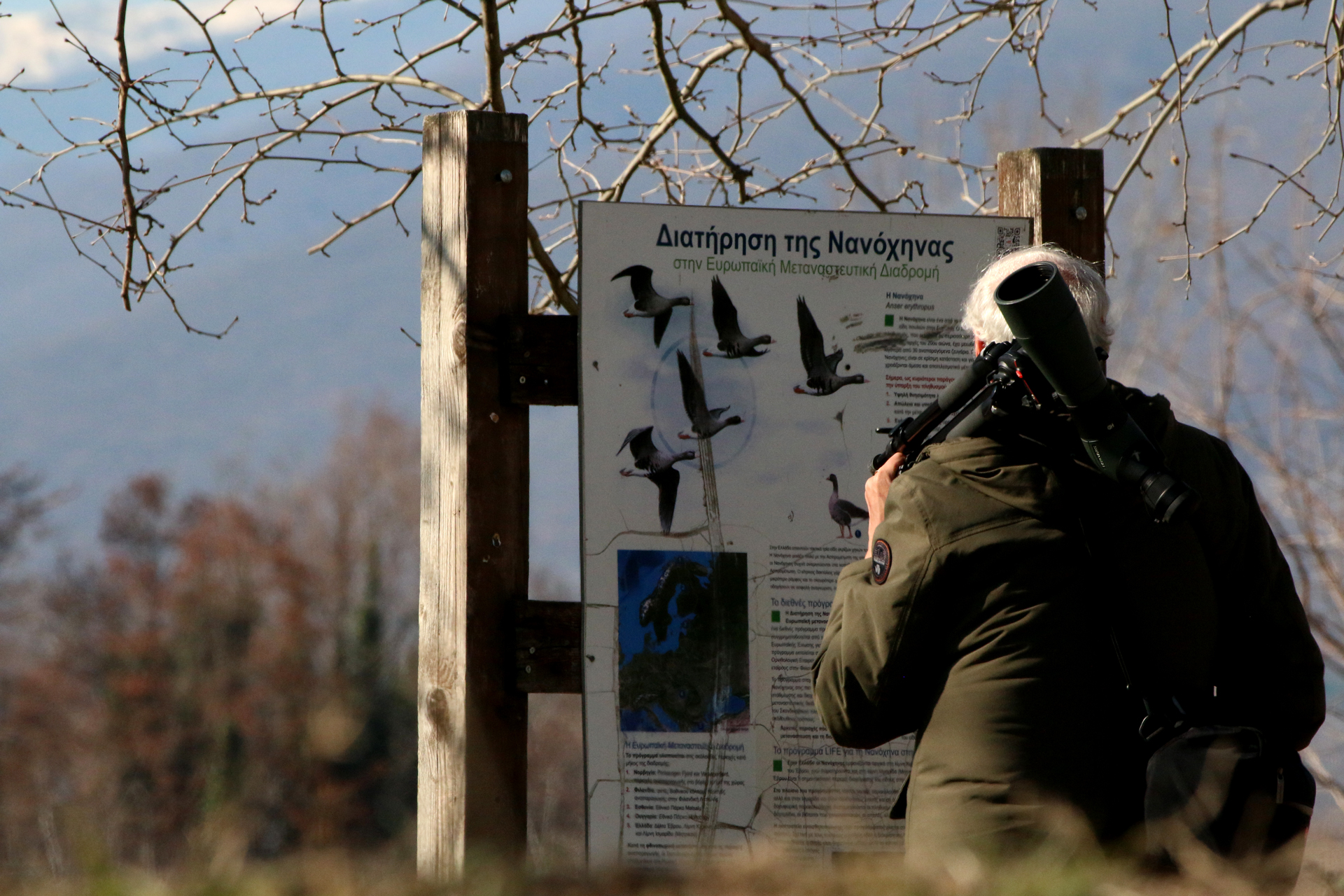
However, asking a group of 10 nature lovers to hurry up in one of the European paradises of biodiversity is pure utopia.
First we are “forced” to stop because Andrea spots a Grey-headed Woodpecker (Picus canus) as one of the ornithological gems that this territory has to offer. Later we slow down further because we find ourselves in a flock of thousands (but probably more) of Common Starlings (Sturnus vulgaris) that fill the sky and meadows around us giving us a real show.
Enough, let’s go! Vasilia awaits us who has prepared delicious cakes for us, rustic feta cheese, cinnamon desserts, sweet buffalo milk cream (!) and other delicacies.
Common Starlings. Photo by Gabriella Motta.
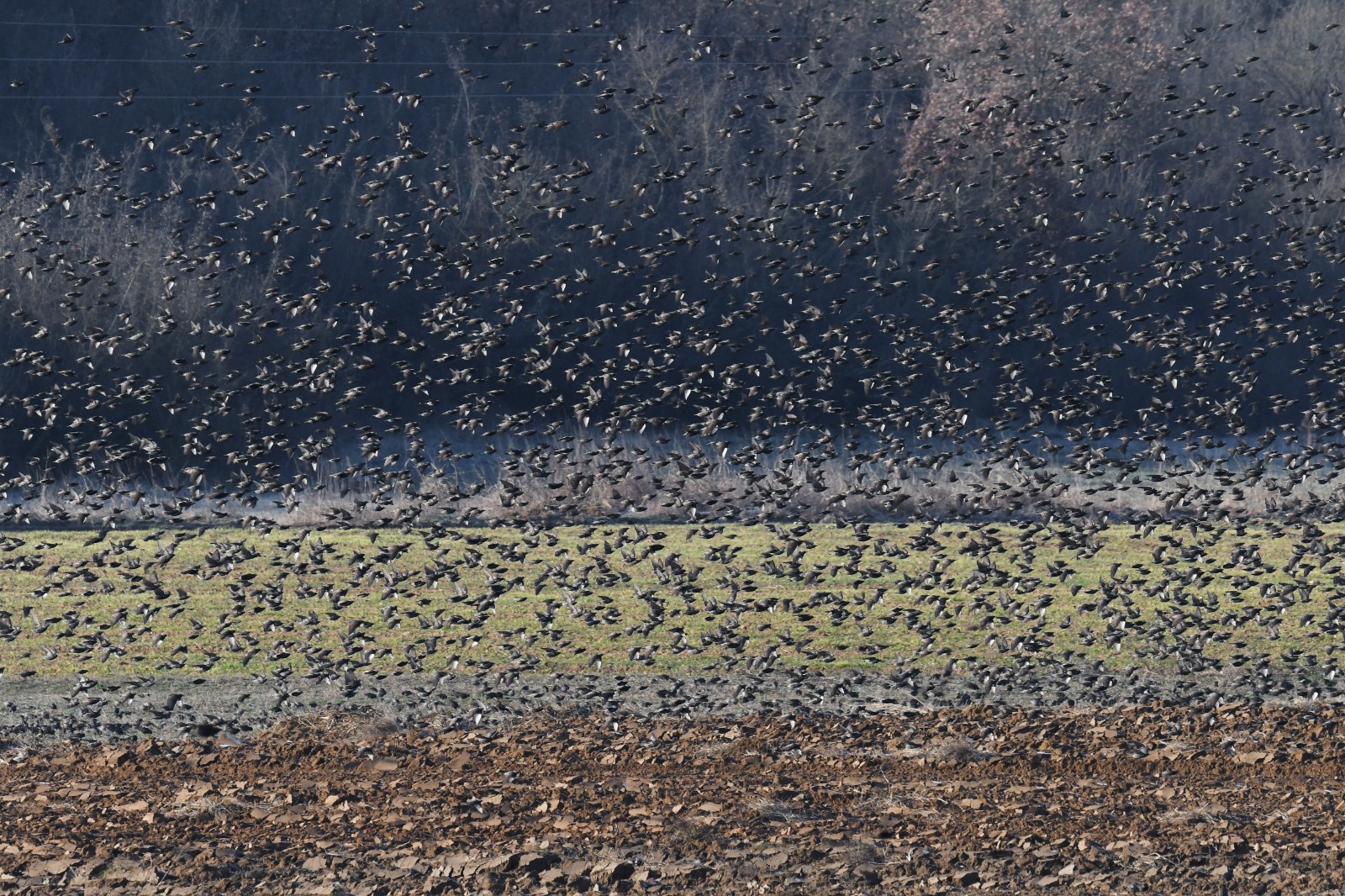
Crested Lark. Photo by Doriano Spinelli.
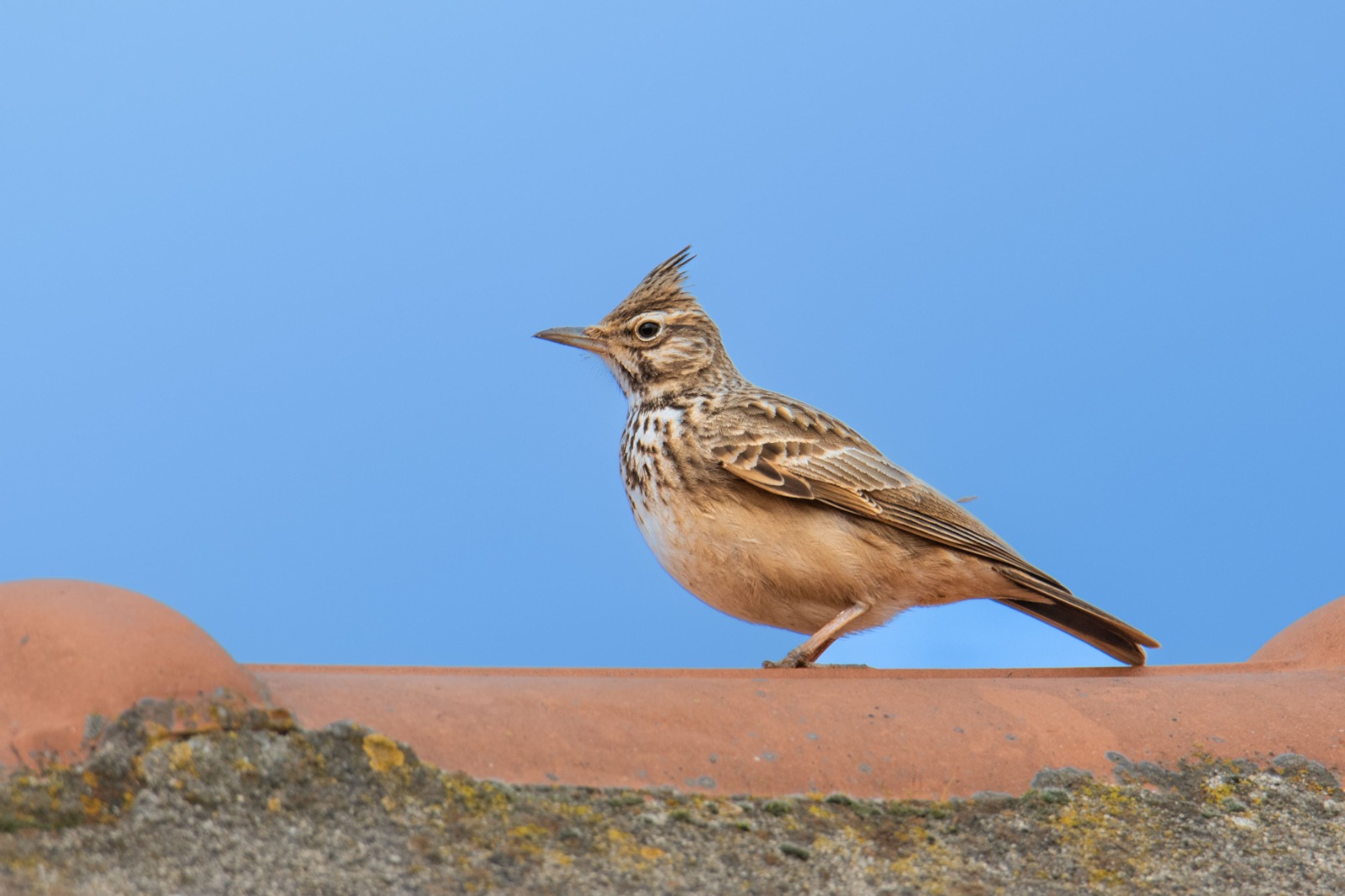
Breakfast with relative calm and we are ready to leave again, the exploration of the west bank of the Kerkini reservoir awaits us. During the journey, in which we alternate observations by car and observations on foot, we contact several dozen of species including ducks, waders (an interesting wintering individual of Black-winged Stilt, Himantopus himantopus), passerines and birds of prey. The latter are also excellently represented by a splendid male Hen Harrier (Circus cyaneus) spotted by Marta near a reed bed.
We therefore decide to move to the hills to the northeast, to radically change the type of environment in order to maximize the number of potentially observable species, also in this case we are further slowed down.
As we are about to split up to dedicate a few more minutes of exploration to that sector of the lake, Valerio sees an imposing silhouette arriving from the snow-capped peaks. No hesitation, it’s an Eagle. Everyone manages to hold the binoculars and the various hypotheses begin to be evaluated. Luckily, the animal flies in our direction, giving us the possibility of being able to easily reach recognition, despite the considerable distance. It is a truly magnificent Greater Spotted Eagle (Clanga clanga).
Greater Spotted Eagle. Photo by Gabriella Motta.
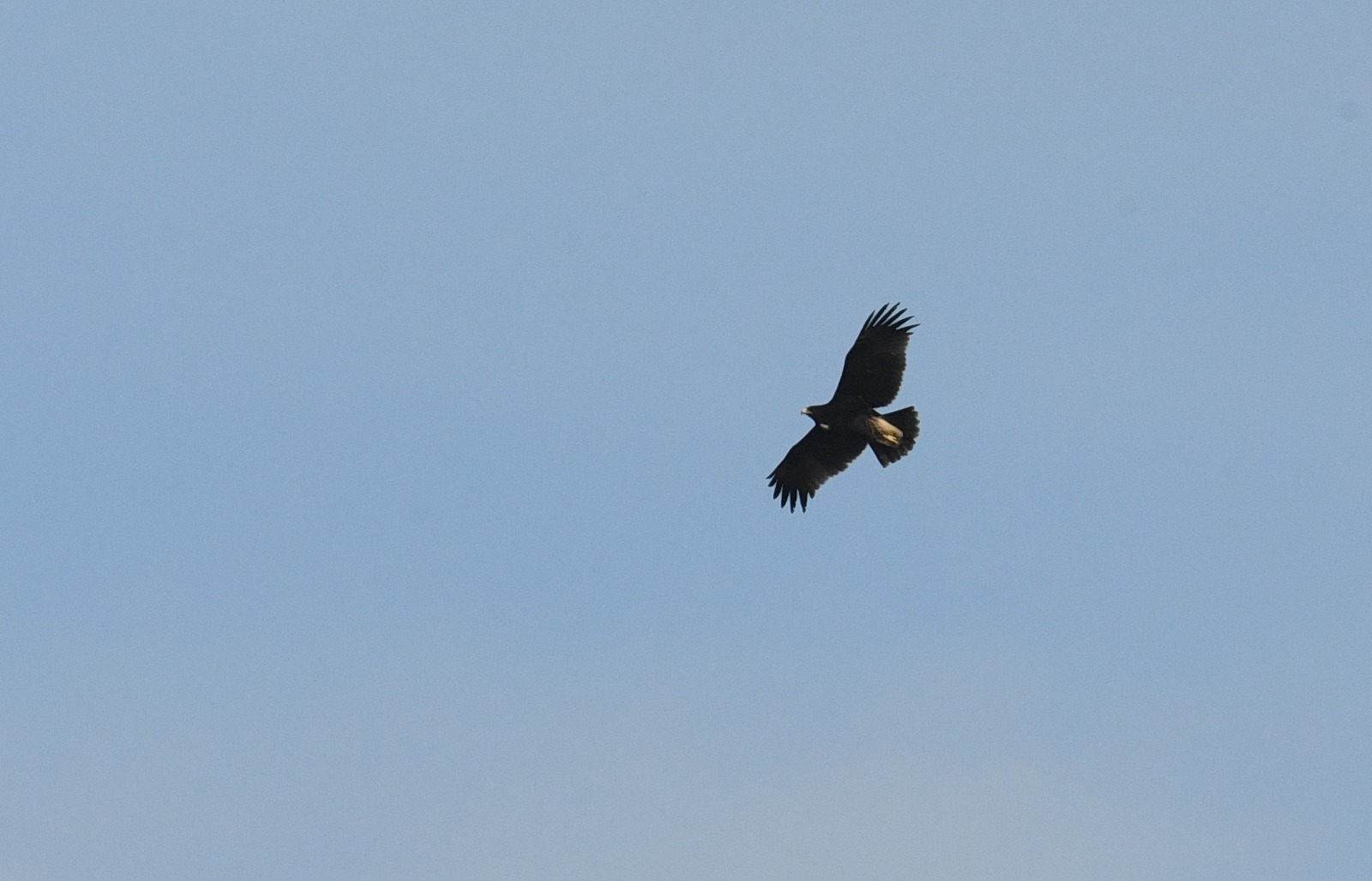
Linnet. Photo by Doriano Spinelli.
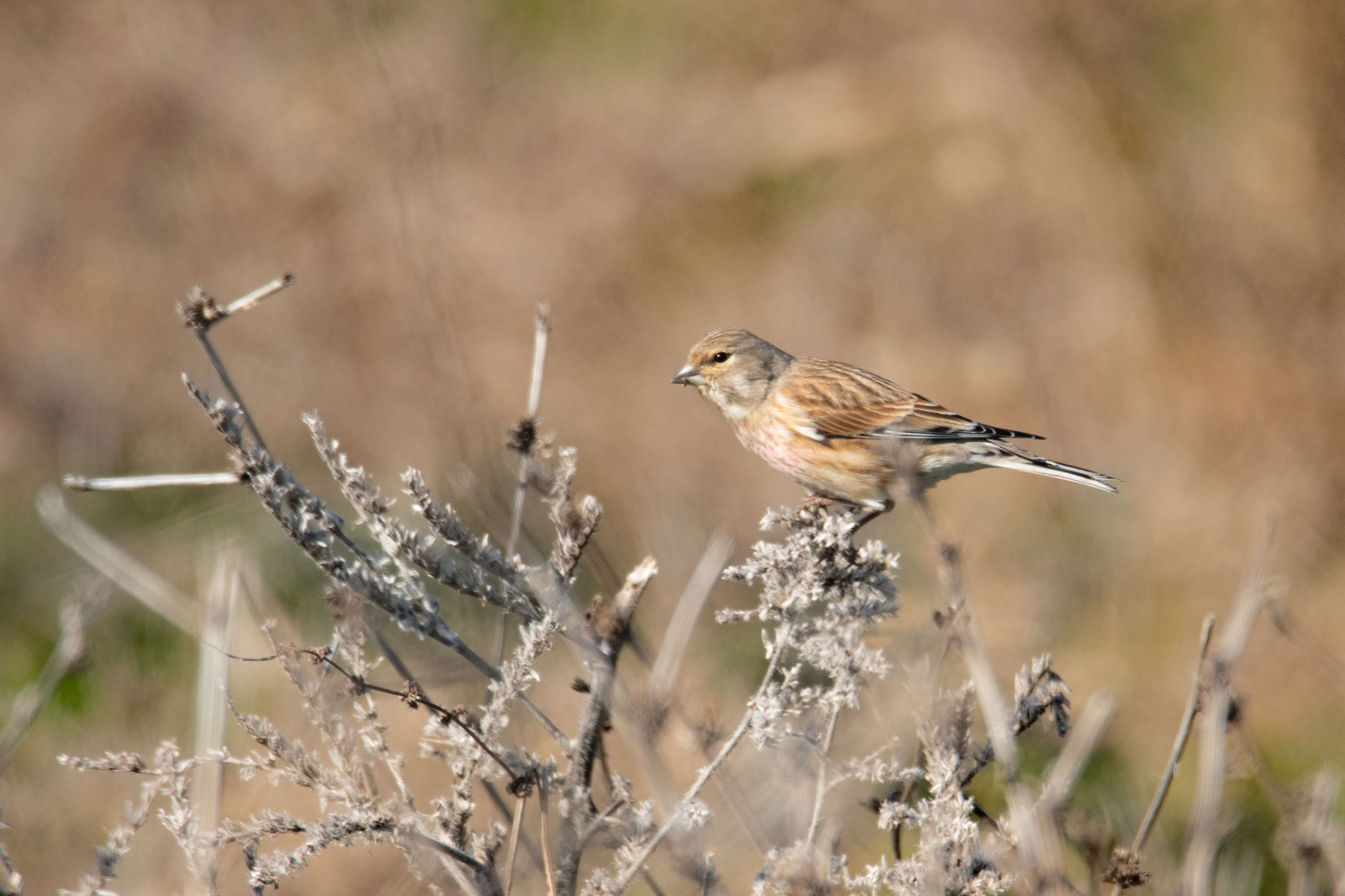
We eat a very quick snack with Tommaso who, despite the still very cold temperatures, trusts that the warm sun can bring some reptiles to wake up.
Whoever lasts wins, here is a young European Green Lizard (Lacerta viridis) which lazily, and apparently without particular success, tries to thermoregulate itself. Not particularly interested by our presence, a Spotted Redshank (Tringa erythropus) and a Common Greenshank (Tringa nebularia) land in the muddy puddle next to us to start frantically looking for food.
European Green Lizard. Photo by Valerio Russo.
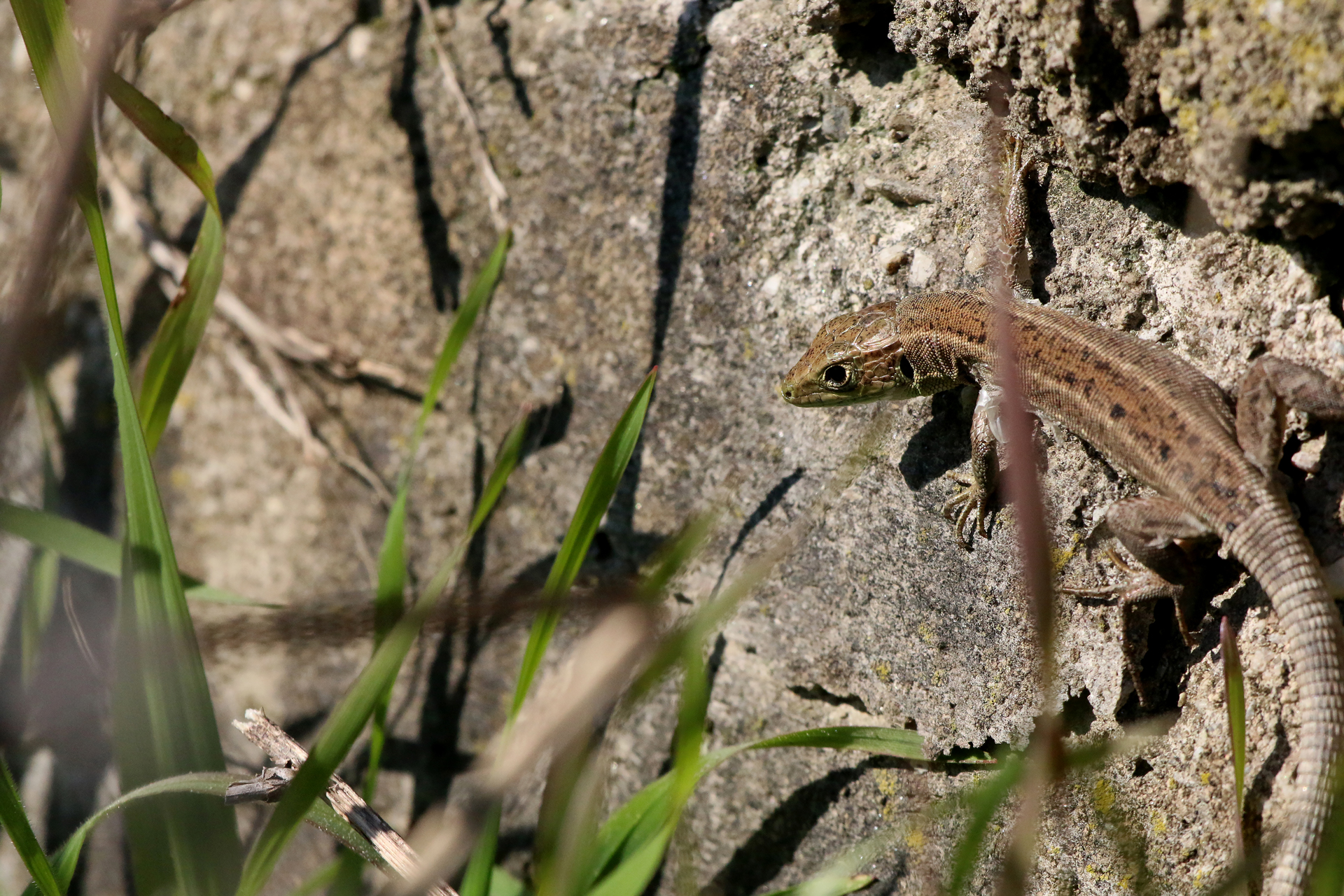
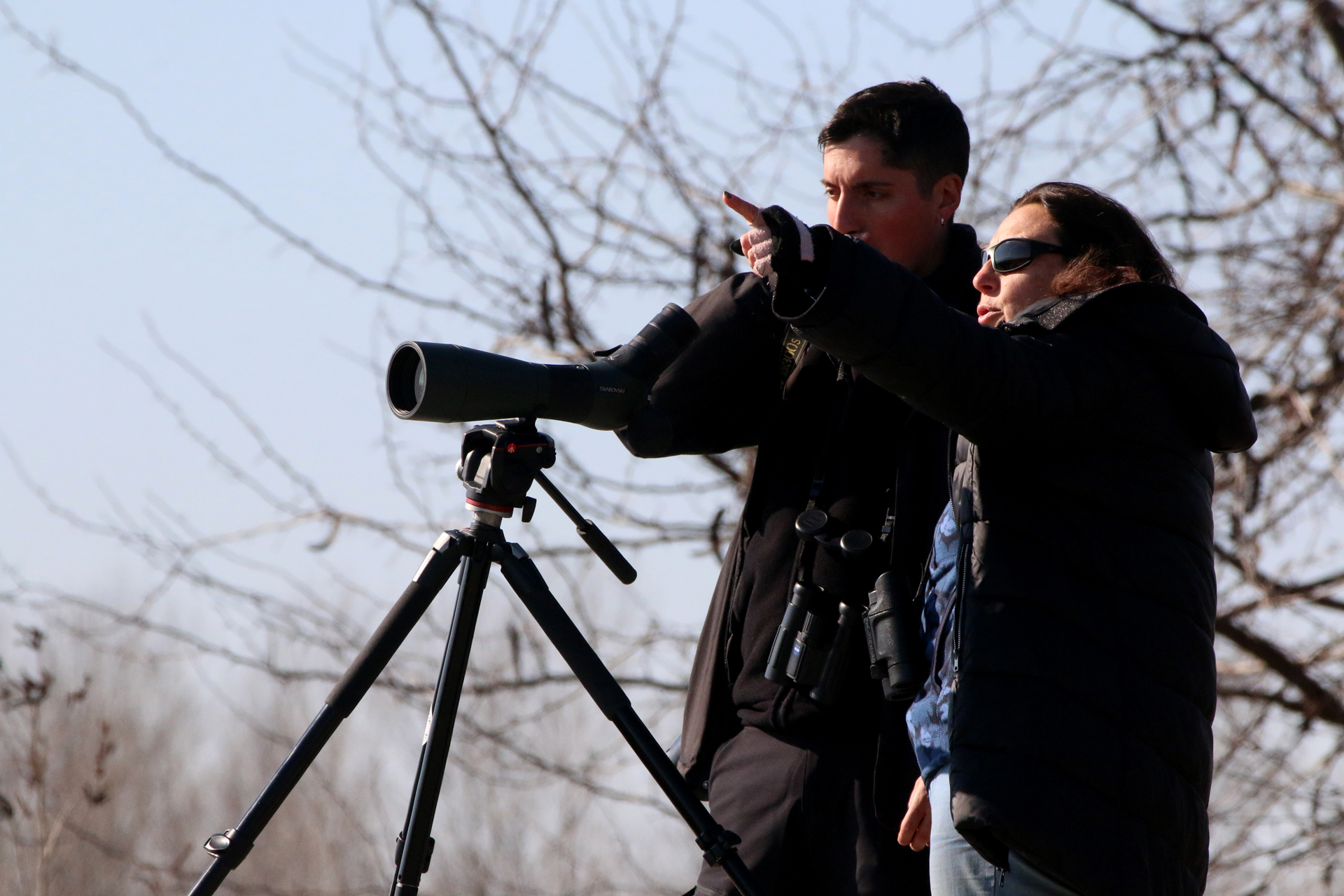
We get back in the car and set off again, during a stop at the petrol station (which we try in vain to involve in our enthusiasm), with the imposing mountains in the background which form the border with Bulgaria, two Black Storks (Ciconia nigra) take off in thermals, allowing themselves to be observed a few minutes.
We reach Sidirokastro to explore an area characterized by calcarenite rocky outcrops dominated by pine forests of conceivable native origin. We hope to contact the Western Rock Nuthatch, a species we have been chasing for years. On the sunny rock face we notice something moving impatiently from one rock outcrop to another. Will it be him!?
No way, it’s a delightful Little Owl (Athene noctua) which alternates a little basking in the sun with very short reconnaissance flights
Black Stork. Photo by Doriano Spinelli.
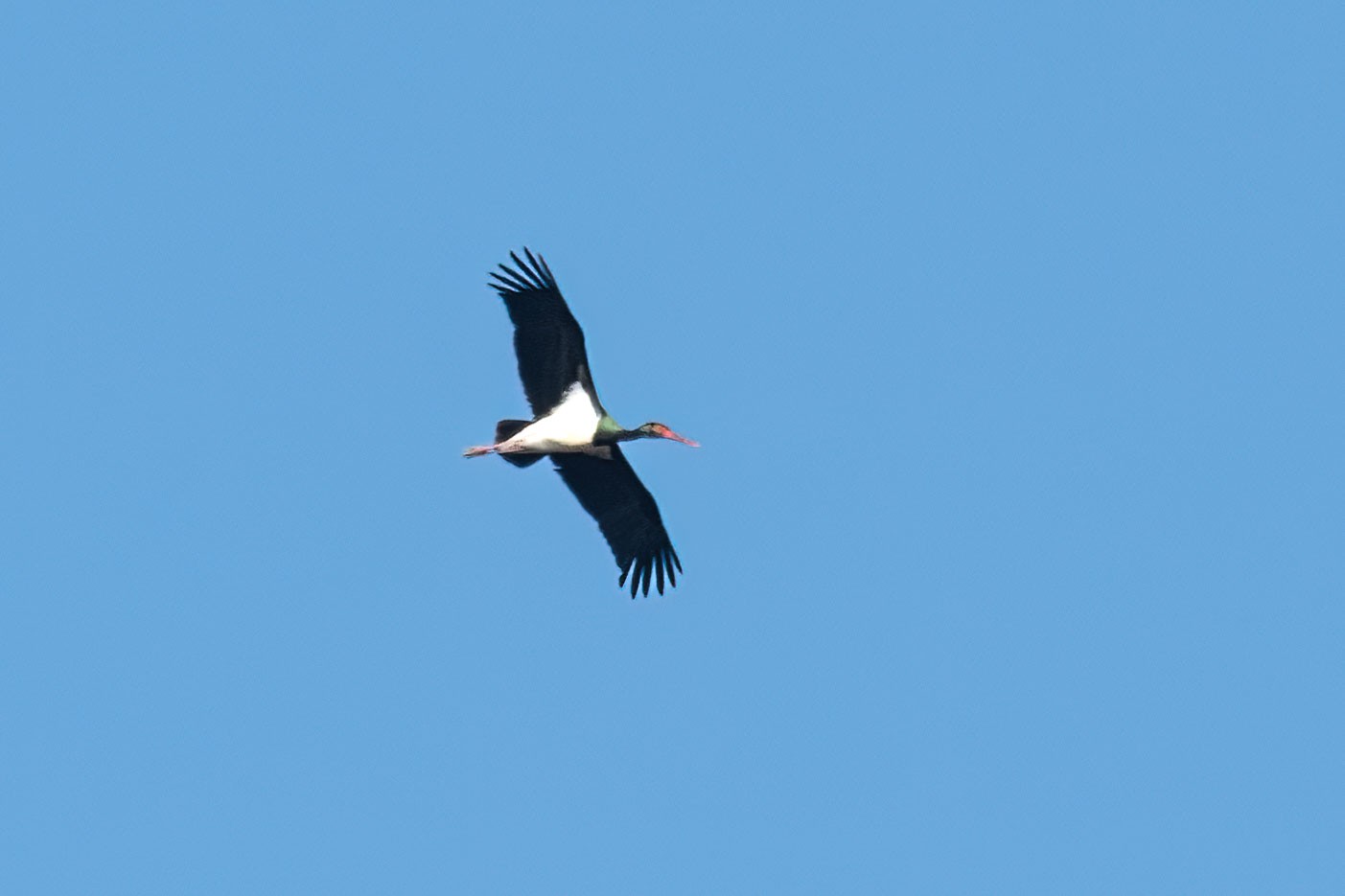
Sidirokastro. Photo by Valerio Russo.
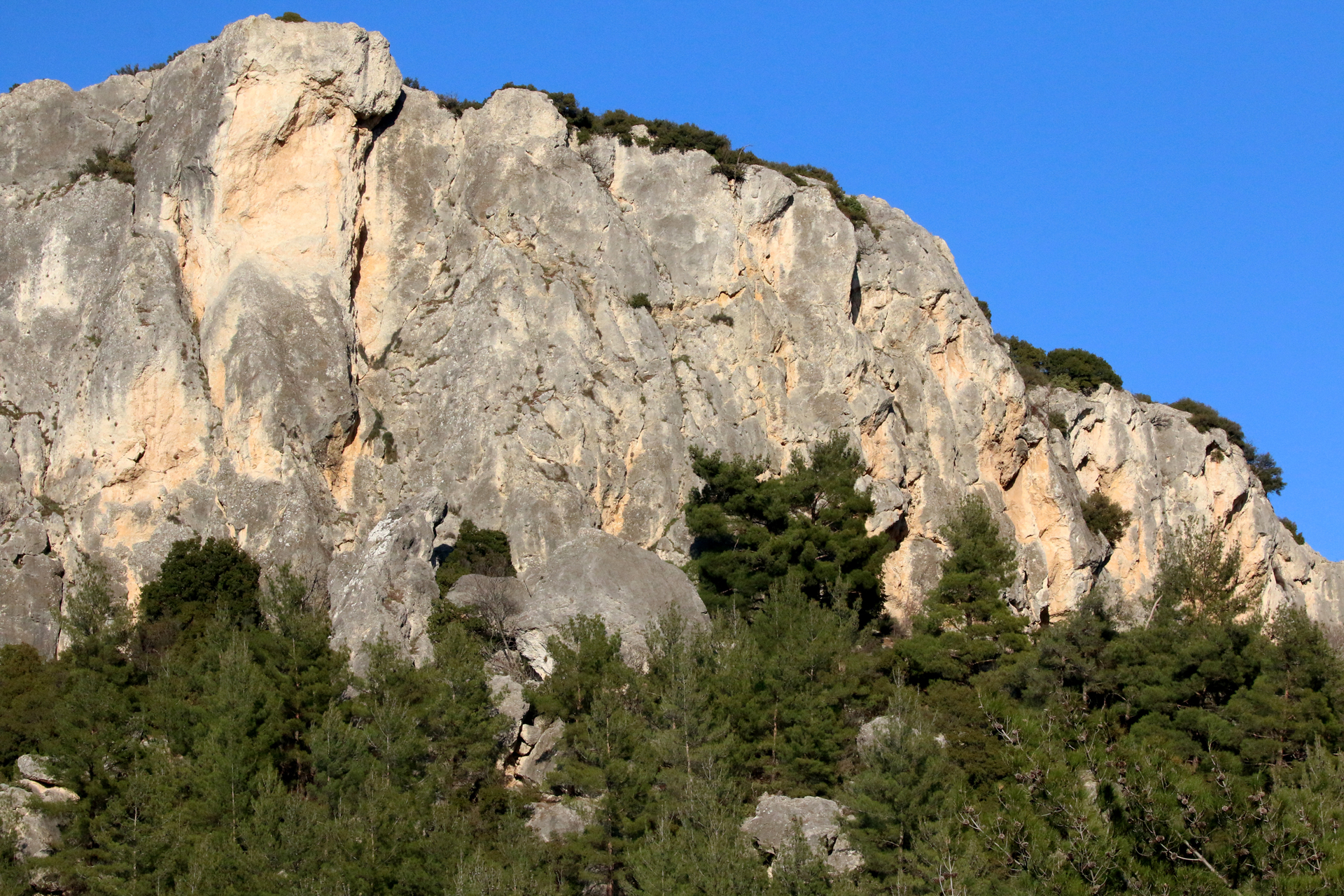
Sidirokastro. Photo by Andrea Senese.
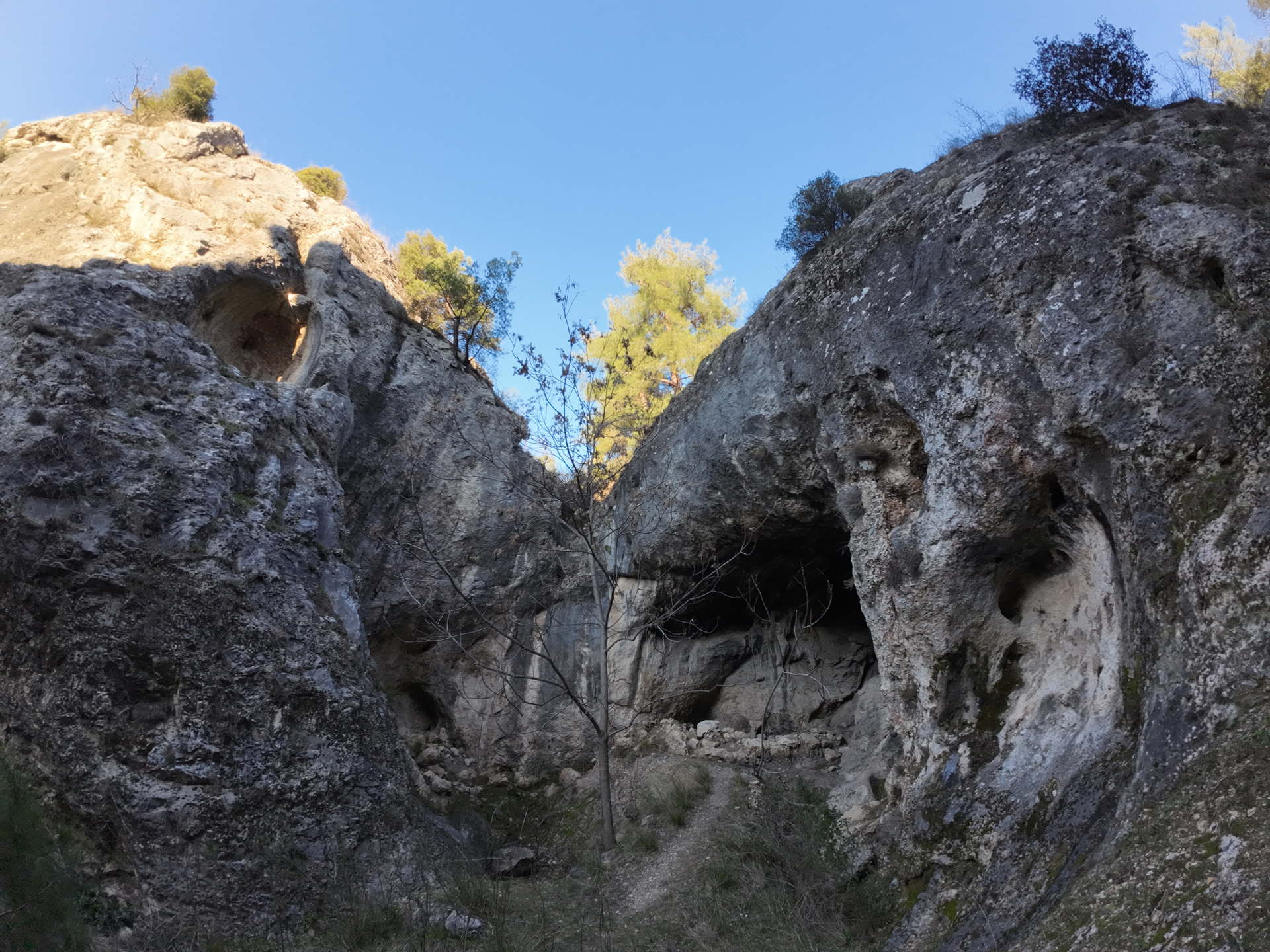
The Rock Nuthatch continues to elude us but the detour was still interesting. Just as interesting was the discovery of many signs of wolf’s presence. Before dinner we enjoy the last moments of light walking along the riparian forest in the Vironia area, where the Belles mountains are reflected in the placid Strymónas river.
Time to have dinner, stomachs growl. Our friend Lefteris is waiting for us; his characteristic restaurant has been a regular stop on our expeditions for years. We are warmly welcomed, as well as by Lefteris and his staff by a huge table of local people who sing and dance all night long traditional songs and then dedicate “Bella ciao” to us, we appreciate.
Dinner is, as always, delicious. Many in the group would have enjoyed carousing with the new local company, but the alarm clock will get us out of bed at 05.30, a good night’s rest is a must.
European Green Woodpecker. Photo by Doriano Spinelli.
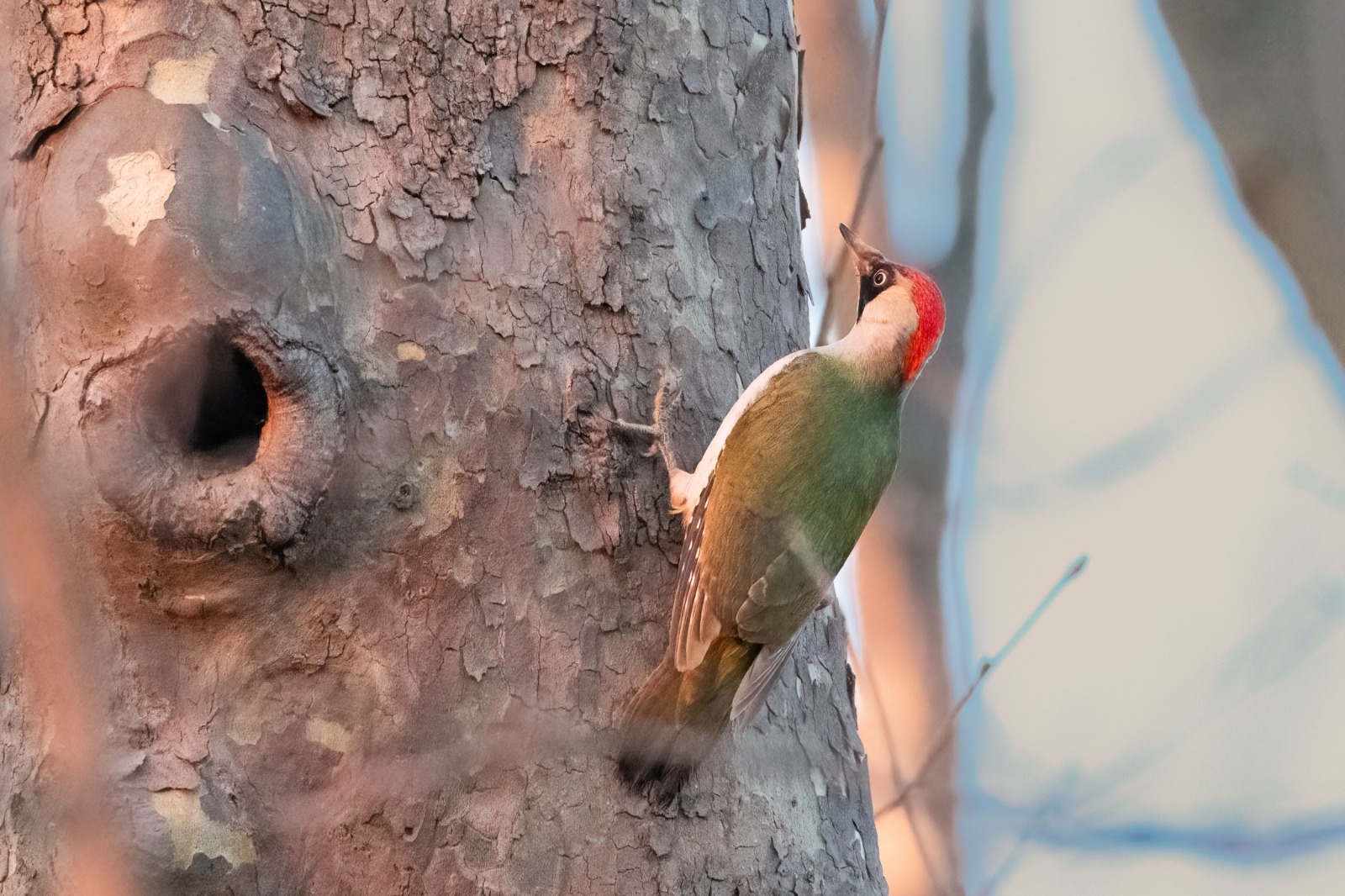
Kerkini Lake. Photo by Andrea Senese.
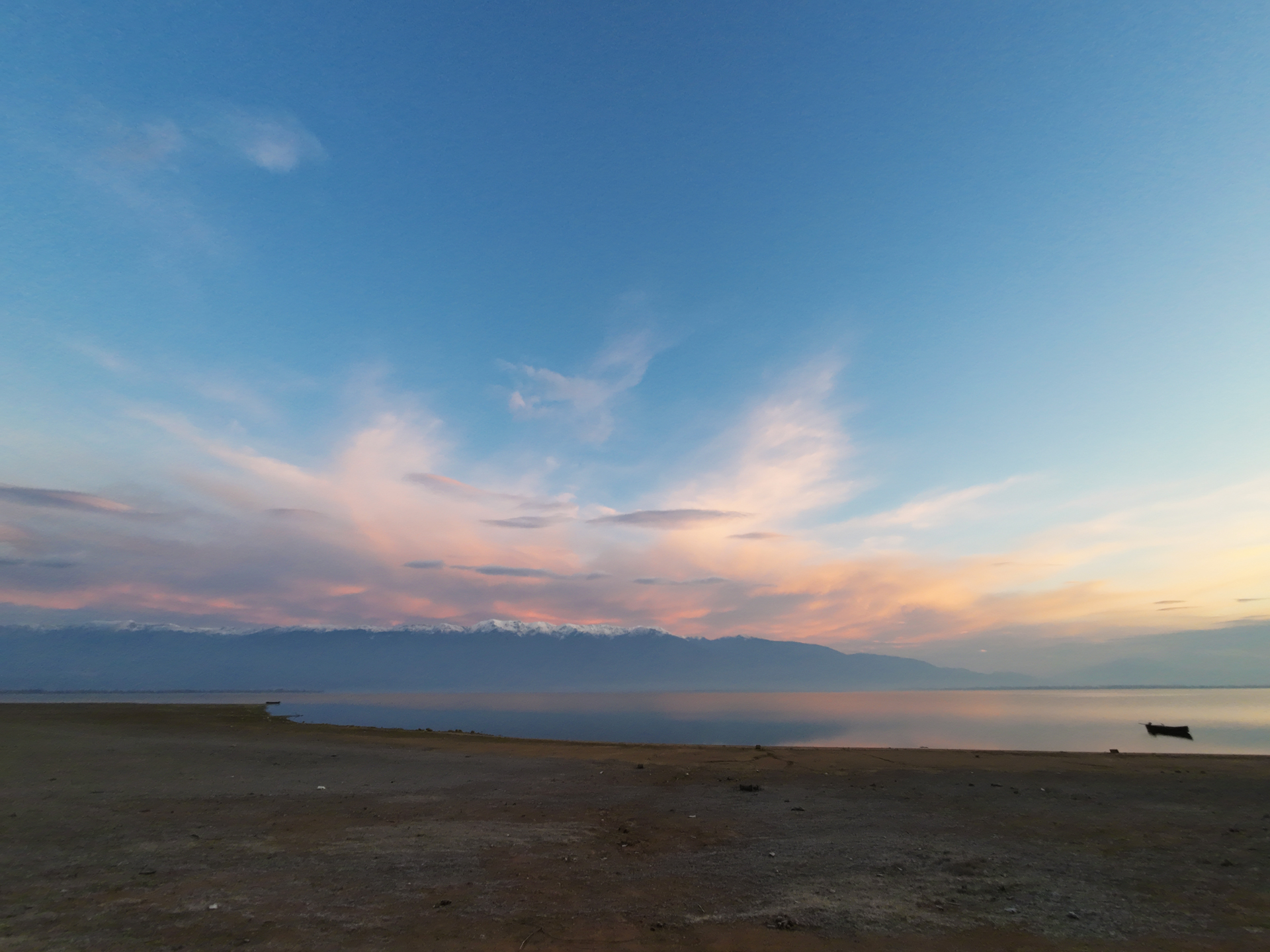
DAY 3
The sun has not yet risen and we are already on the western shores of the lake. We slowly approach the shore crowded by water birds including the first Great White Pelicans (Pelecanus onocrotalus). We set the spotting scope and immediately confirm an impression we had had by observing with the binoculars: among the many different species present there are also the beautiful Common Goldeneyes (Bucephala clangula).
Kerkini Lake inhabitants. Photo by Gabriella Motta.
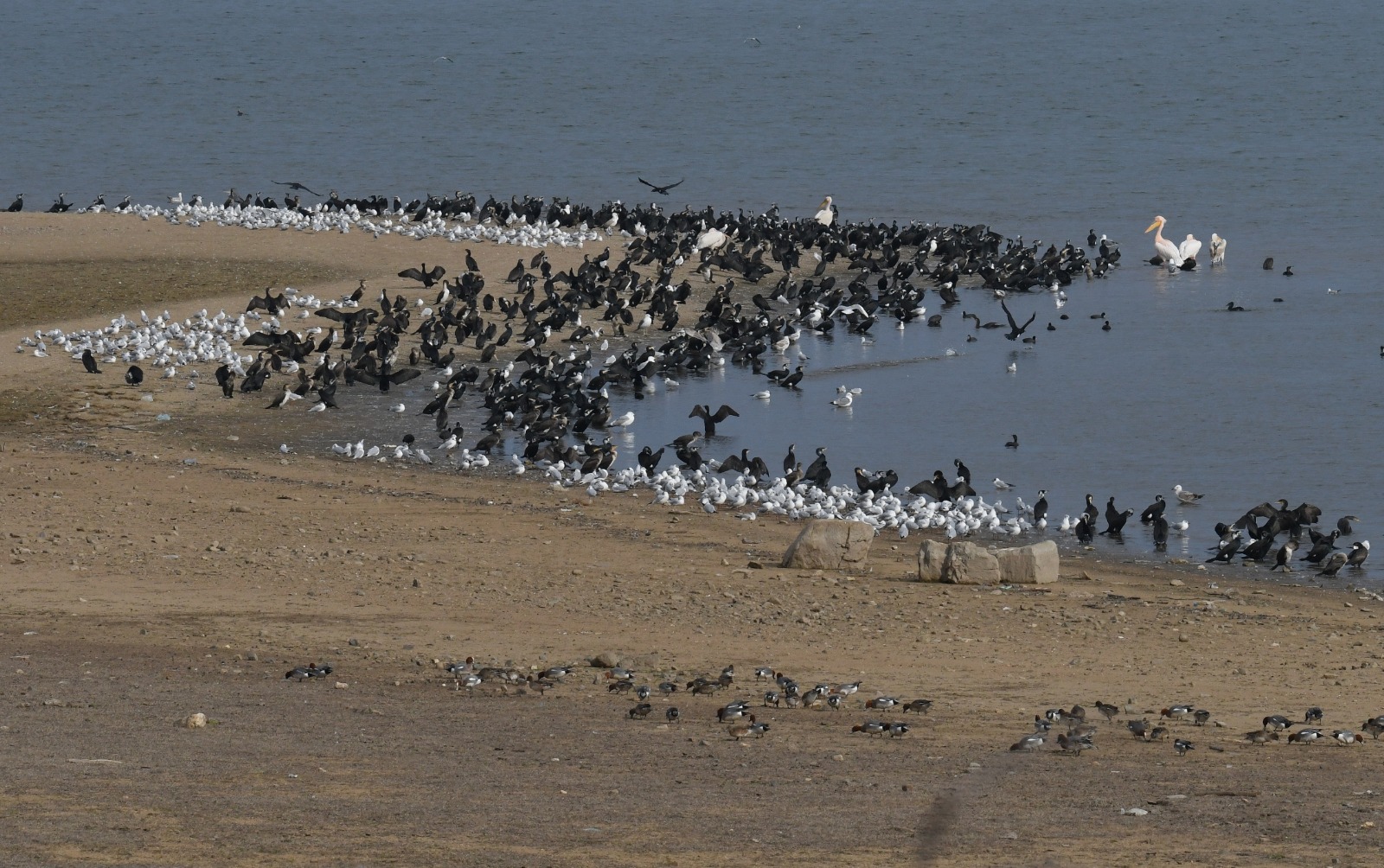
Common Goldeneyes. Photo by Doriano Spinelli.
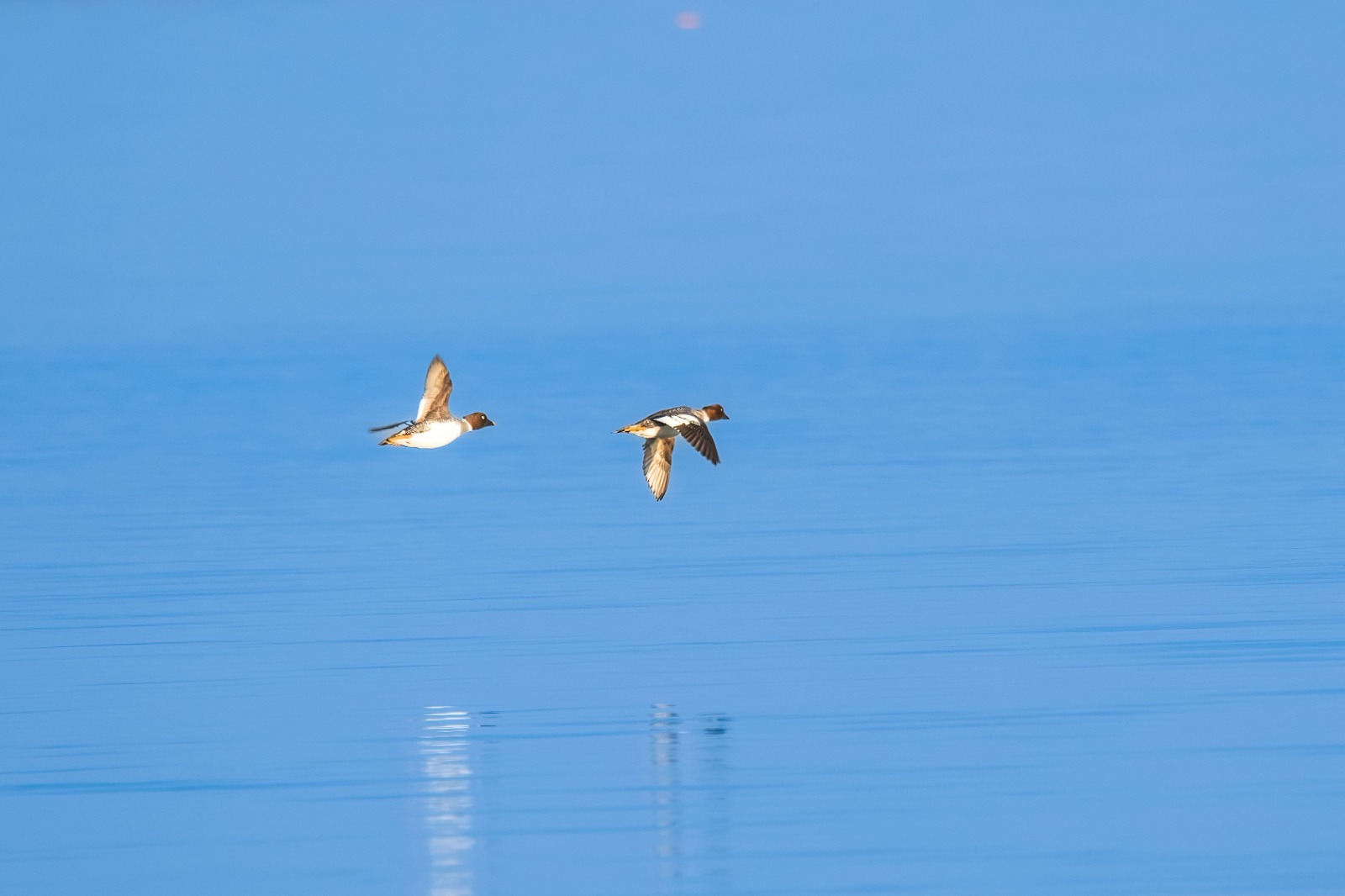
The mud on the shore betrays, through hundreds of footprints, a large coming and going of animals. There is also a very clear track that seems absolutely compatible with wolf. The observations that follow are all very interesting; the Water Pipits (Anthus spinoletta) stroll on the bank and, behind them, a group of waders turns out to be composed of numerous Little Stints (Calidris minuta) and a Grey Plover (Pluvialis apricaria).
Finally, in a group of Black-headed Gulls further down we notice a Common Gull (Larus canus), a species that we come across for the first time on Lake Kerkini. Finally, Gabriella sees a group of 15 Stock Doves (Columba oenas) flying over the nearby woods.
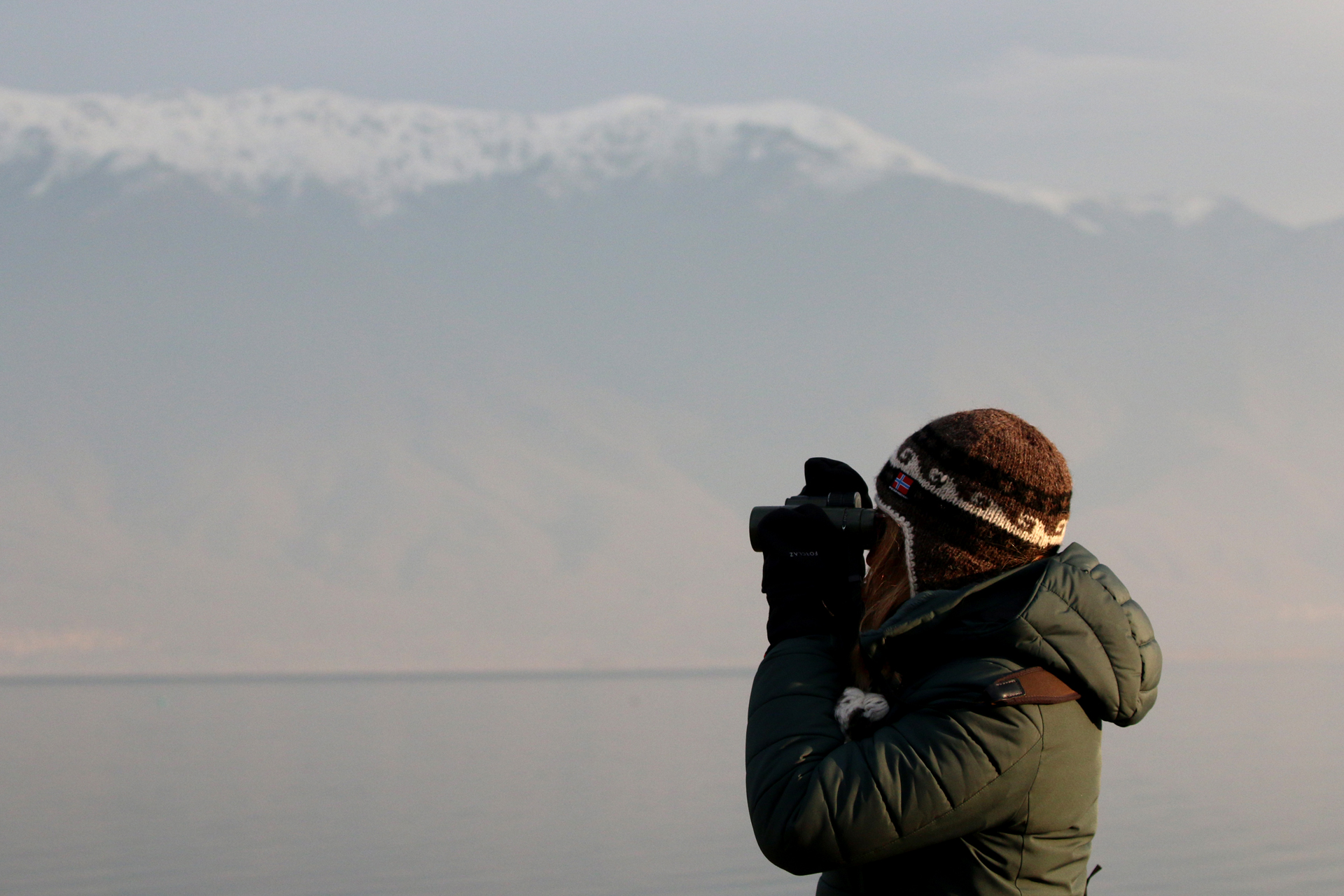
Great White Pelican. Photo by Valerio Russo.
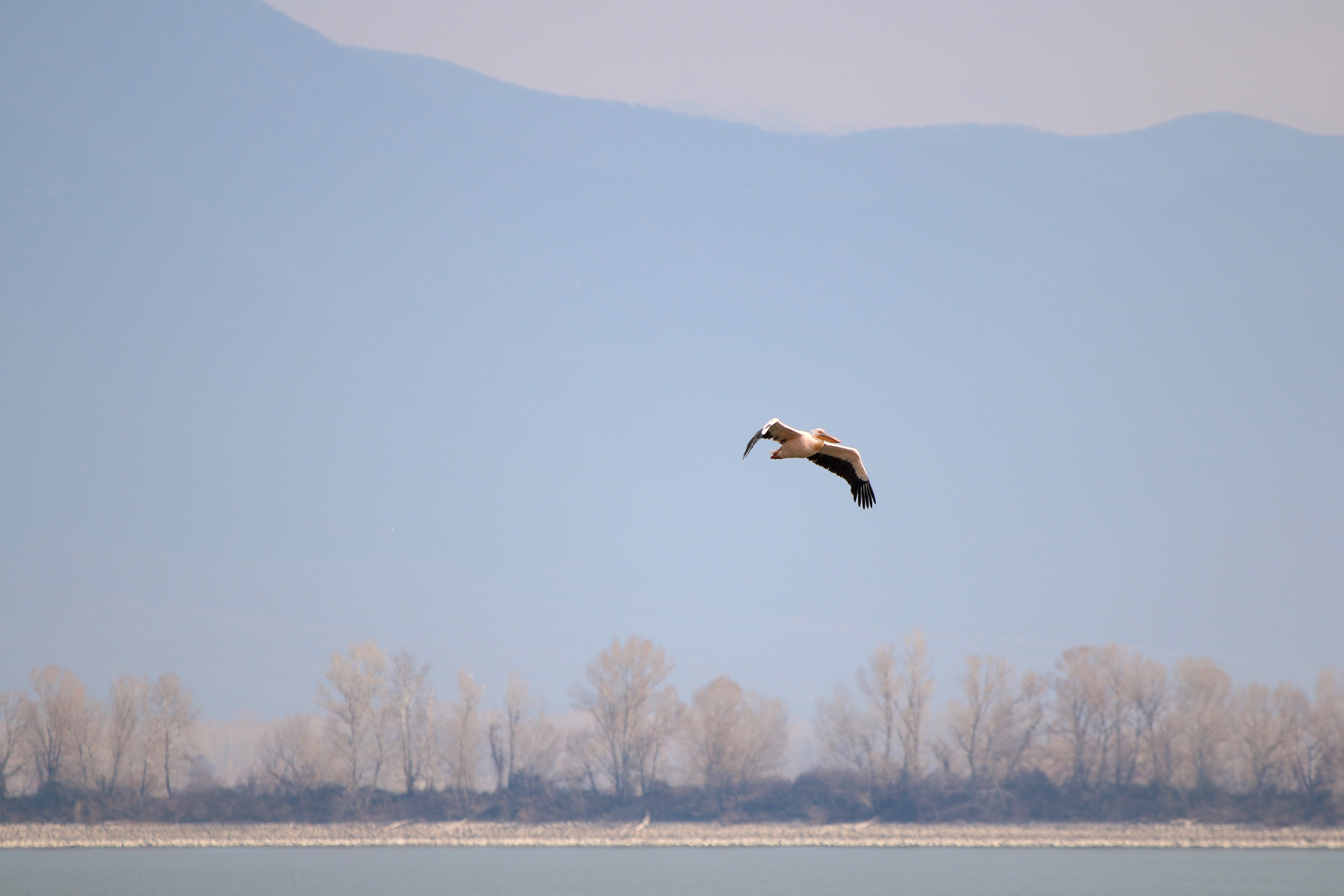
Even today the start of the day was more than satisfactory. Even today we deserve to enjoy a delicious breakfast in the warmth of our guesthouse!
After breakfast we are eager to continue with the observations. We head towards the eastern area of the reservoir. Crossing the sporadic residential areas we have the opportunity to take more and more photos of the Tree Sparrow (Passer montanus) which in these areas seem to us to be better distributed and more common than here in Italy.
Tree Sparrow. Photo by Doriano Spinelli.
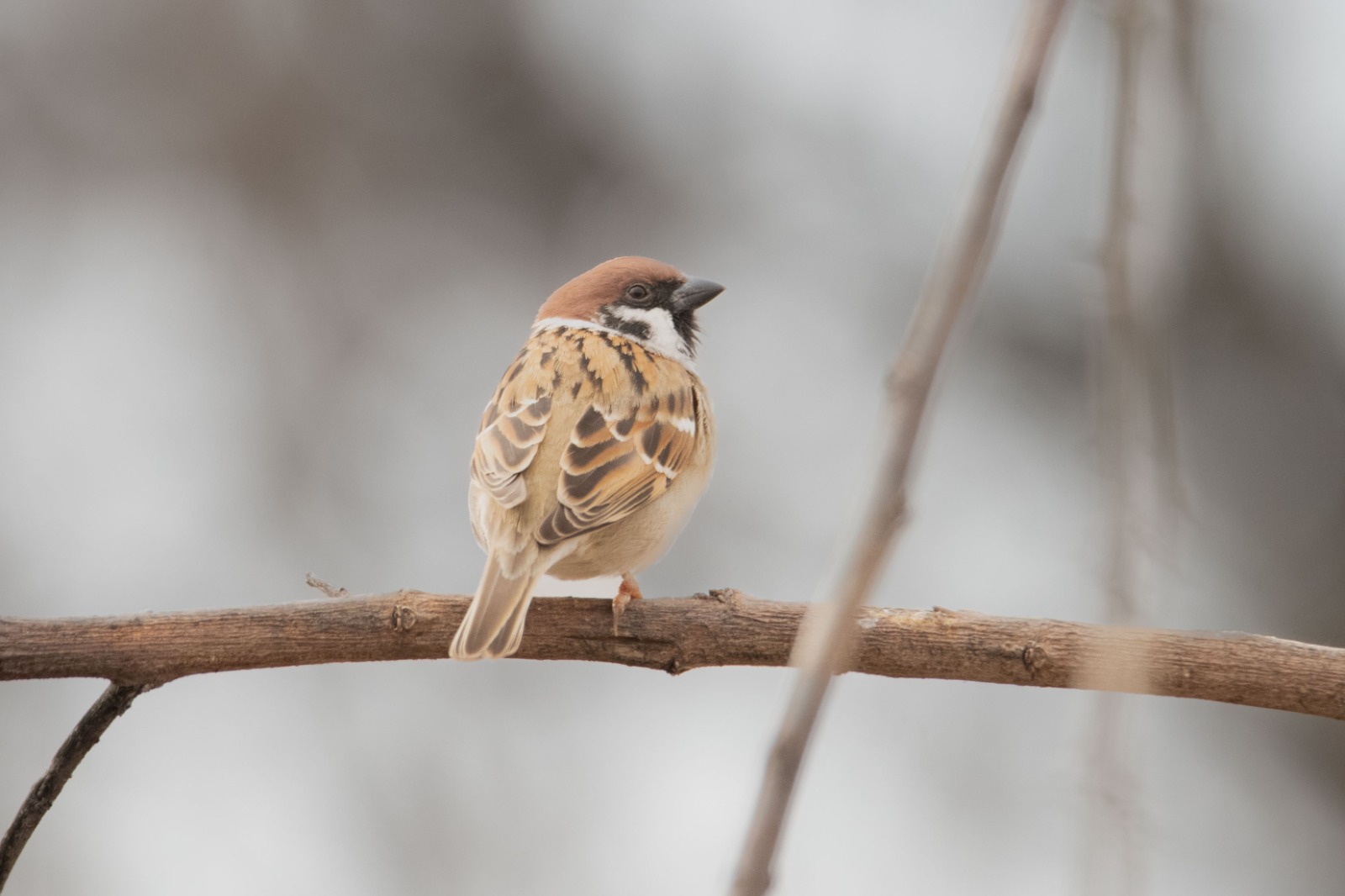
Tree and House Sparrow. Photo by Valerio Russo.
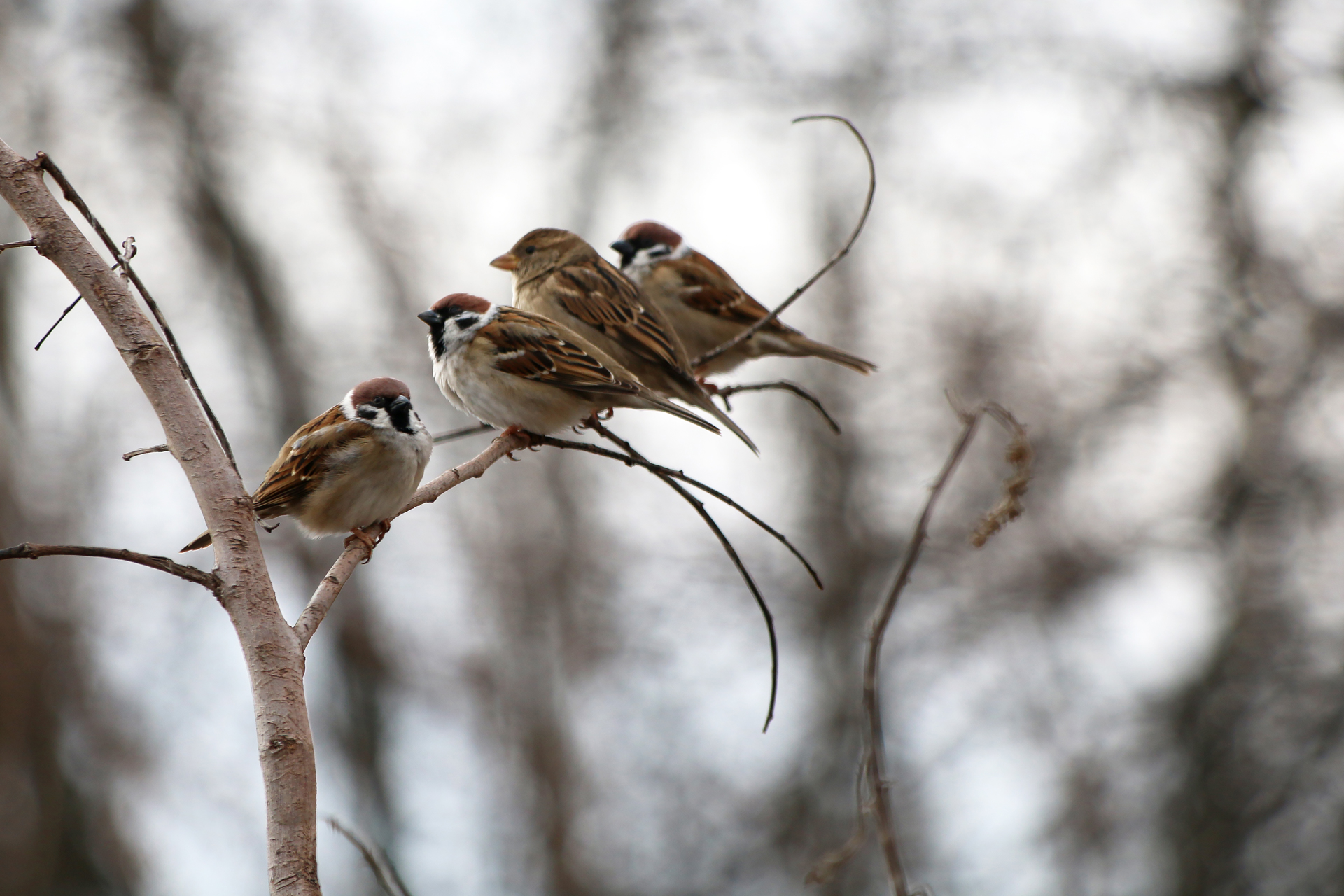
Heading north we observe Grey Herons, Great Egrets, Spoonbills in the fields and, along a canal, a solitary Little Egret (Egretta garzetta), paradoxically the only one we will see throughout the days spent in Kerkini.
Still along a canal, or rather, to be more precise, along its burnt-out banks, Andrea manages to spot a Common Snipe (Gallinago gallinago) trying to blend in. The contrast between the color of the plumage and the charred vegetation is very interesting and Doriano manages to capture it masterfully.
The waters of the lake are crowded with hundreds, indeed thousands of Pochards, a breathtaking spectacle that is now increasingly rare to admire in our wetlands.
Common Snipe. Photo by Doriano Spinelli.
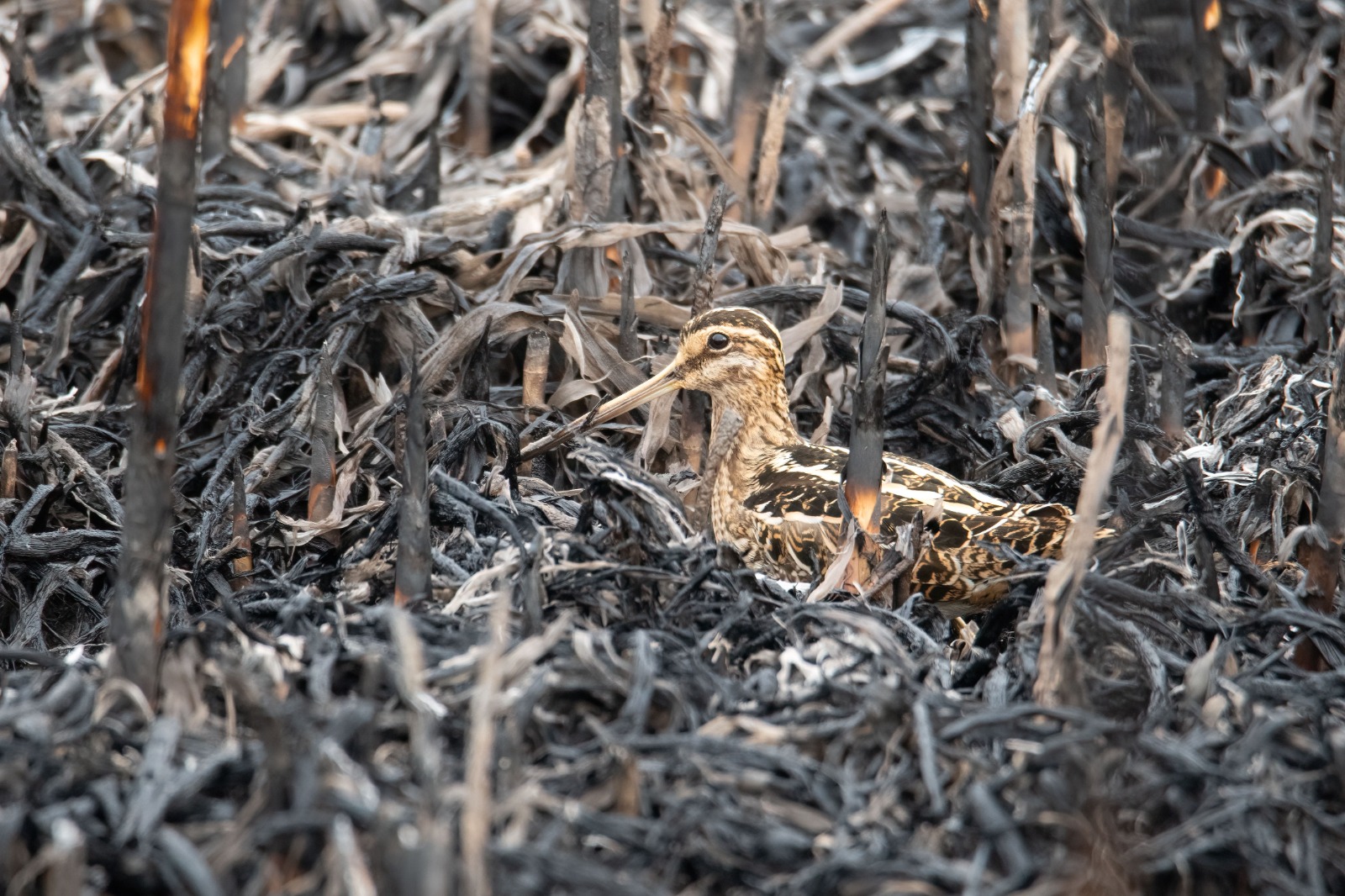
Common Pochards. Photo by Valerio Russo.
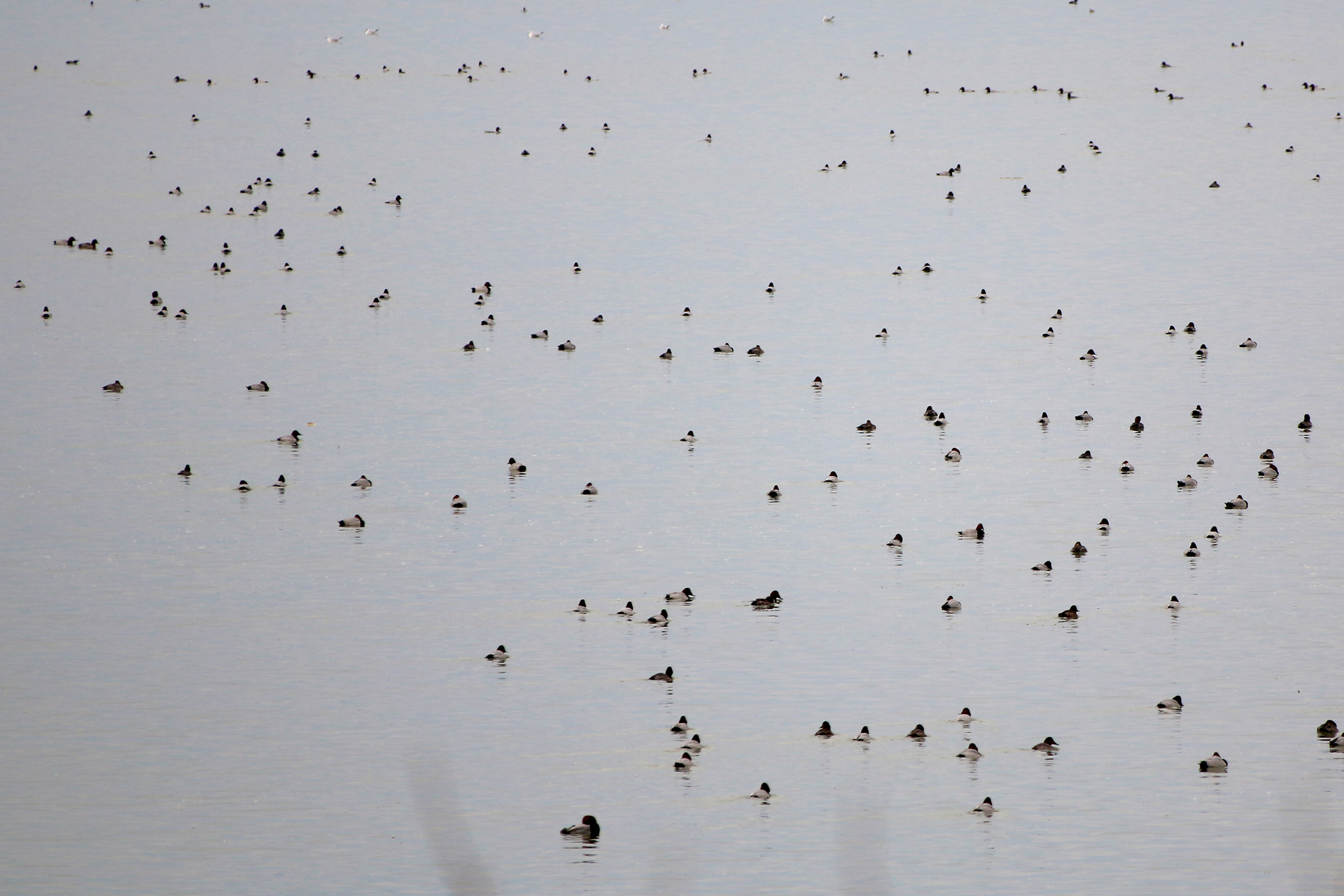
We then move to the shallower water areas north of the lake. And here the two hours begin, probably the most exciting of the entire expedition.
In the water a beautiful Black Stork rests; behind him, together with dozens of Greater White-fronted Geese, Gaudenzio and Paola see a group of Bewick’s Swans (Cygnus columbianus bewickii) and in the middle, perched on the ground, a majestic Greater Spotted Eagle looks around, probably undecided on which prey to focus on among the myriad of possible options.
How many target species all together!
Black Stork. Photo by Doriano Spinelli.
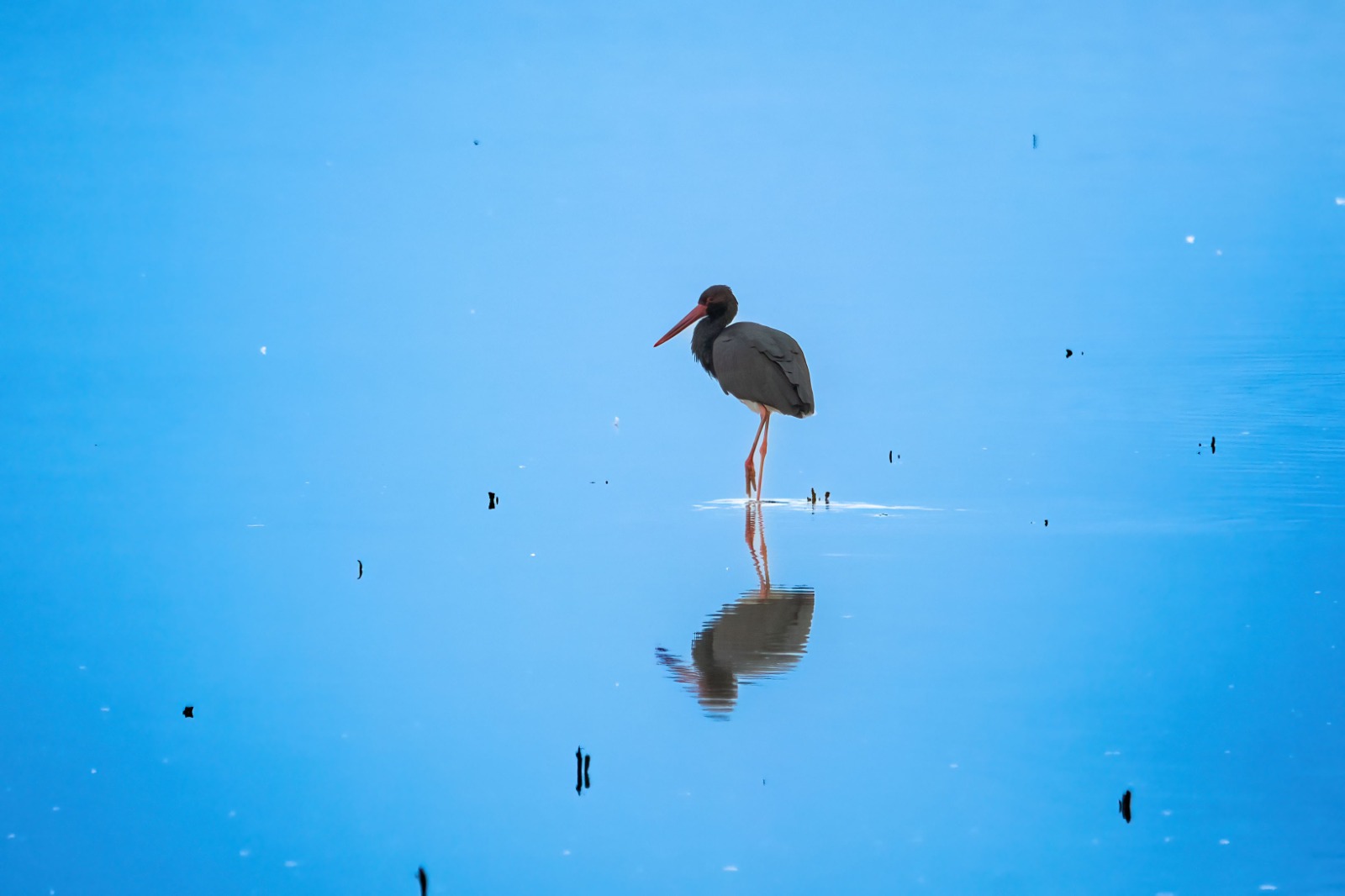
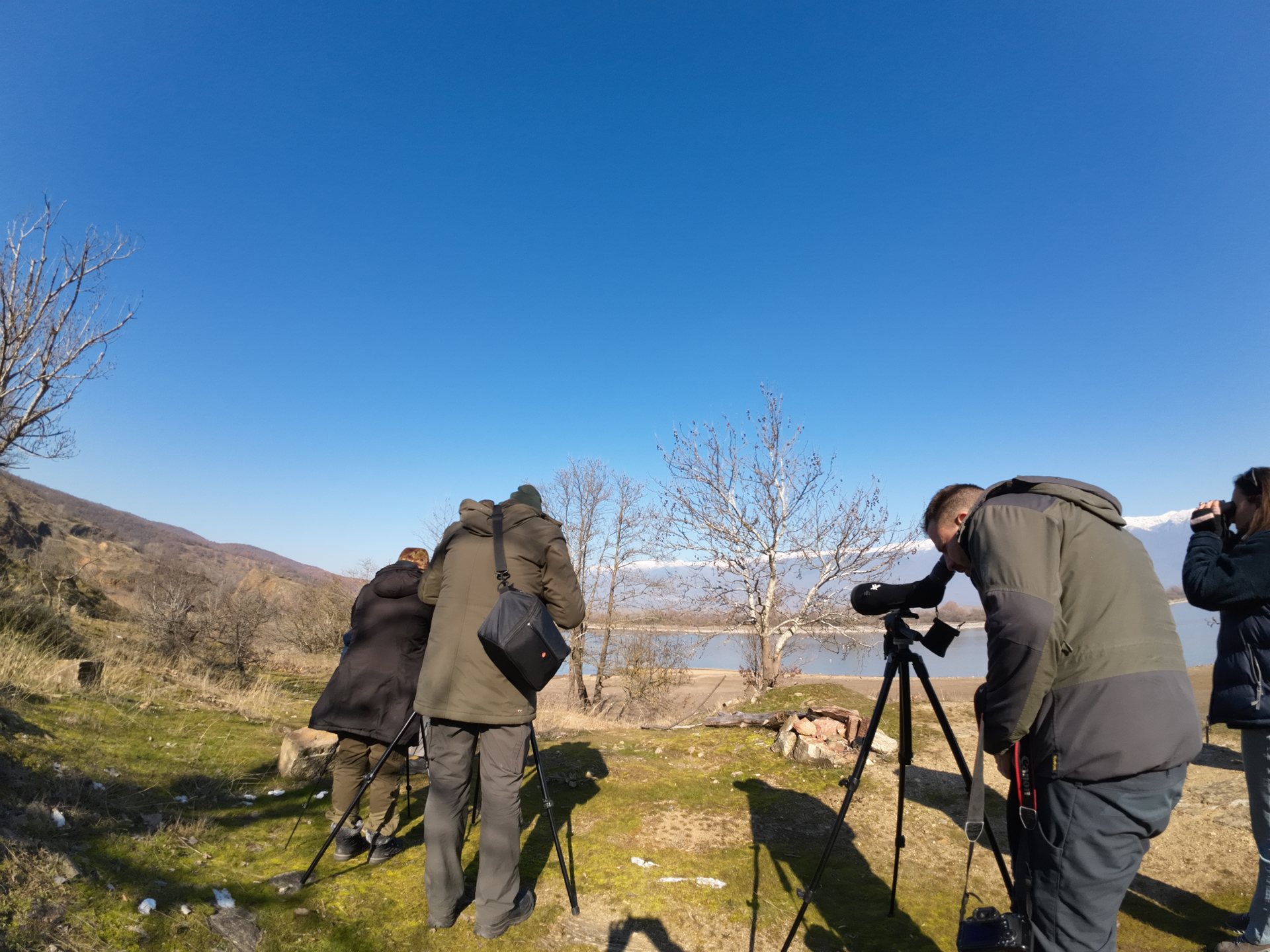
But the emotions have only just begun. A few hundred meters away we notice that Antonio is photographing something in the middle of the road, the silhouette is recognizable even from a distance, it is a Wildcat!
As we approach the action the cat, seemingly uninterested in our presence, slowly but surely walks away. When we arrive he has already left.
So lucky!! If an observation of Wildcat (or rather two if we also consider the one of a few years ago always in Kerkini) is an extraordinarily auspicious event, two observations in less than 48h are to leave us speechless, above all because it is a species which, even if well distributed – much more than was believed in the past – it is particularly difficult to spot.
What luck, of course, but also what frustration! We almost couldn’t get close with the full group. Patience, we are all enthusiastic anyway.
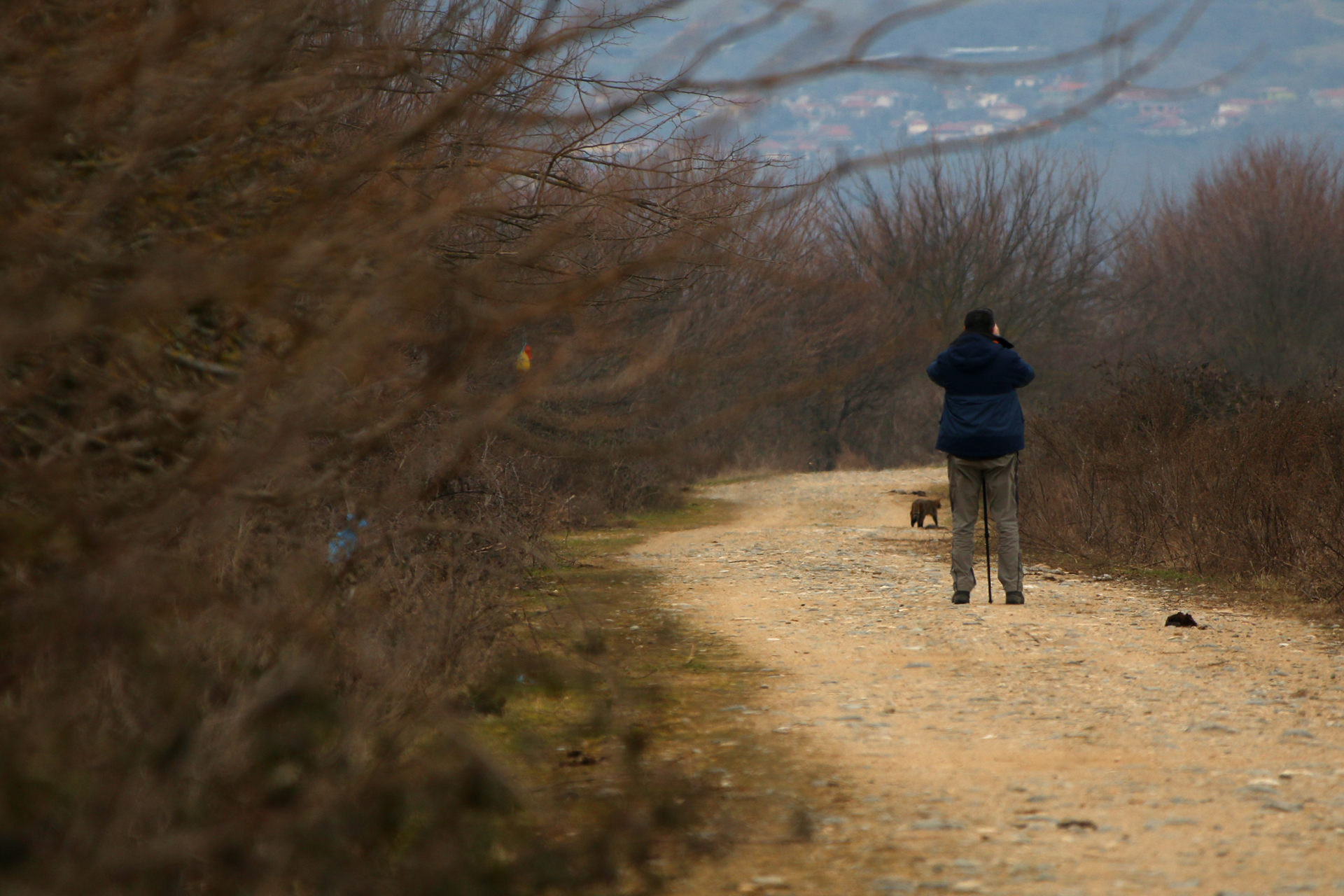
We quickly have a packed lunch, the day is still long. However, we risk letting the bite go sideways. Antonio exclaims “the cat is back!”.
Finally all the members of the group manage to enjoy this magical moment: under the incredulous gaze of all of us, the proud cat does not seem to care about our presence and lets itself be admired from about 3 meters away for more than 25 minutes! It stretches in the sun like the most docile house cat and then, after patiently waiting for a possible prey, it disappears among the thick grassy vegetation.
European Wildcat. Photo by Valerio Russo.
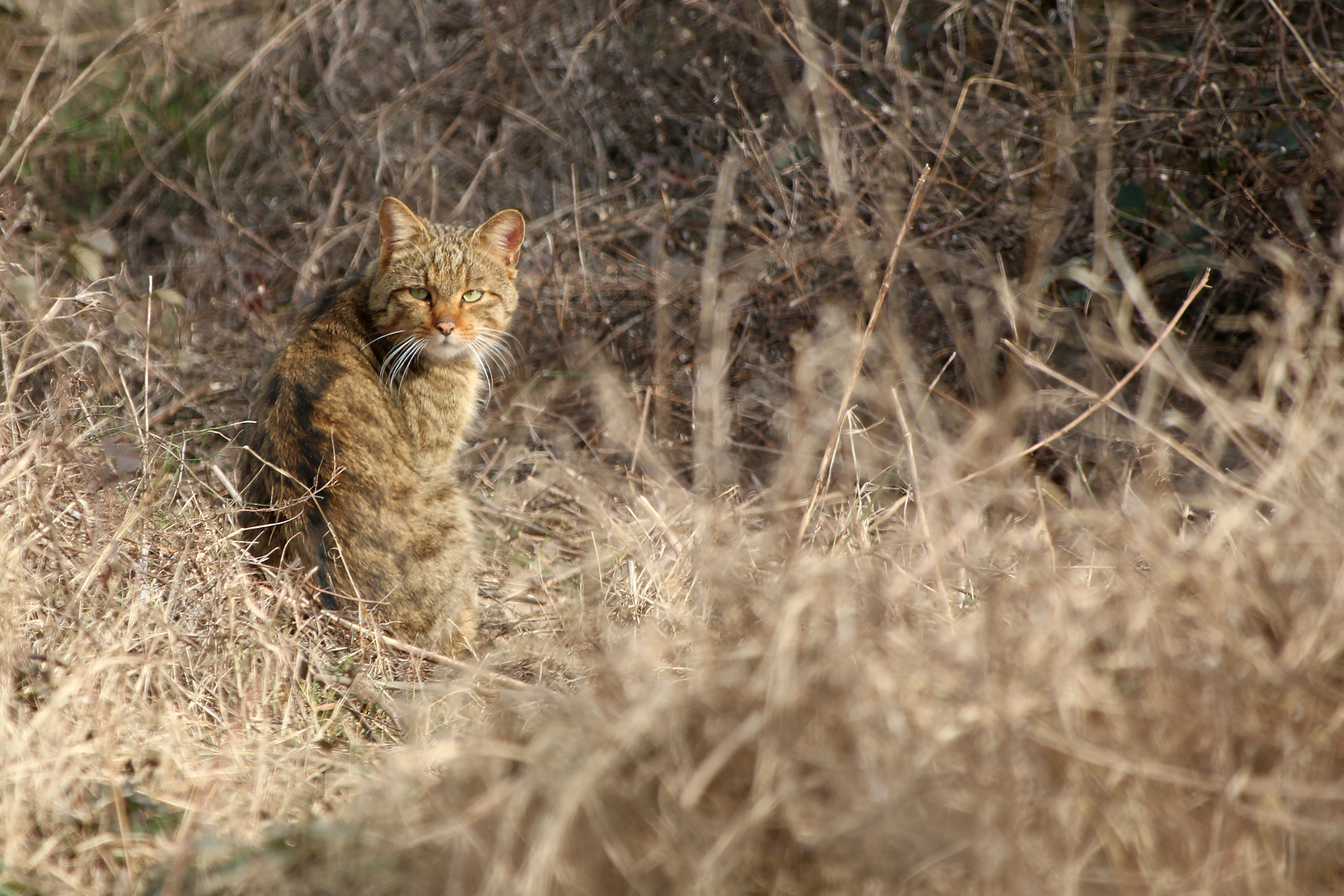
European Wildcat. Photo by Andrea Senese.
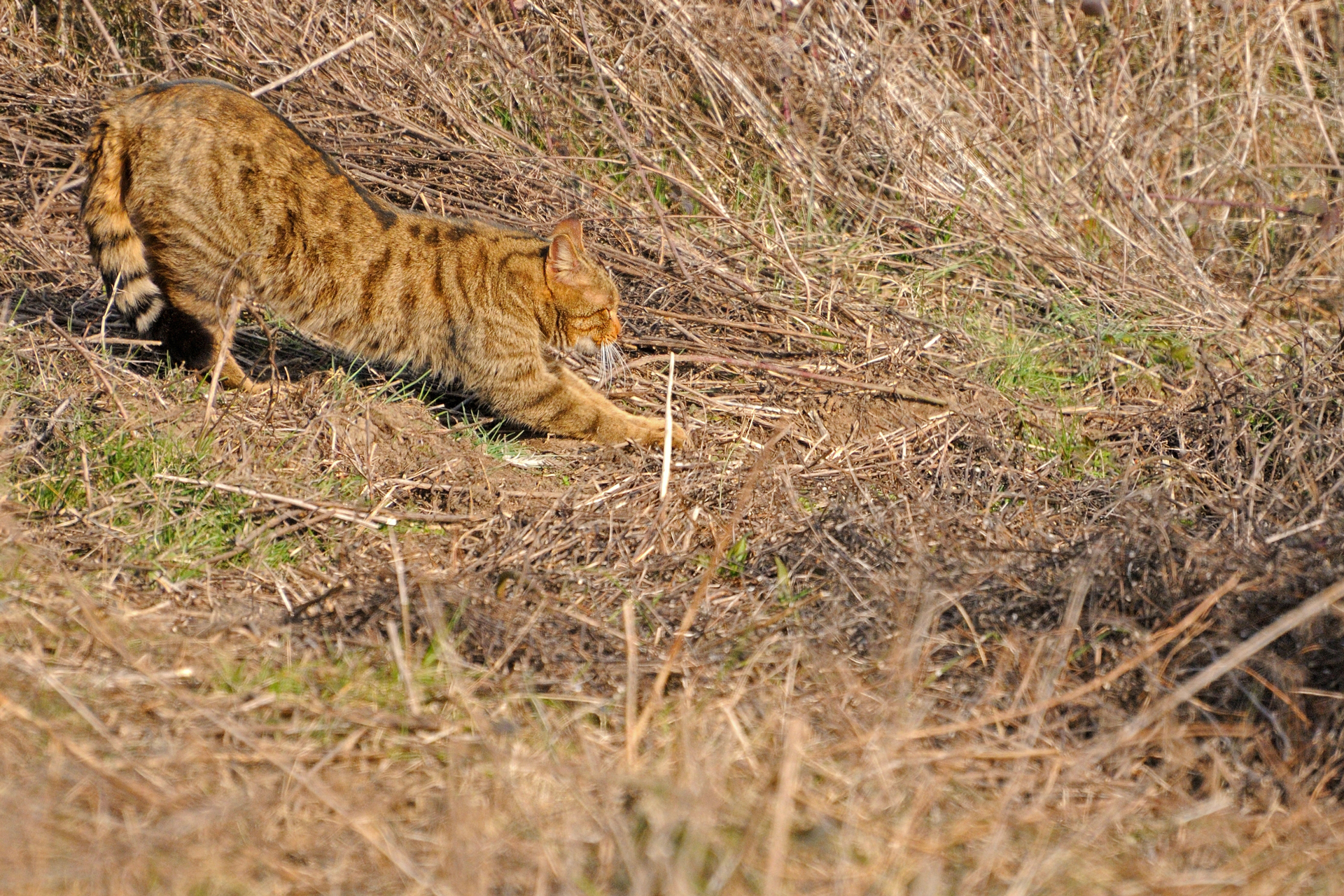
Still stunned by the lucky encounter, we continue the exploration of the eastern shore of the lake and were not long in lacking further noteworthy observations. A Merlin (Falco columbarius) follow our cars alighting on the roadside shrubs and, shortly after, we spot two large birds of prey in thermals: another individual of Greater Spotted Eagle circles together with a beautiful White.tailed Eagle (Haliaeetus albicilla), the mighty dimensions of the latter almost disfigure the other bird of prey!
Strymónas. Photo by Valerio Russo.
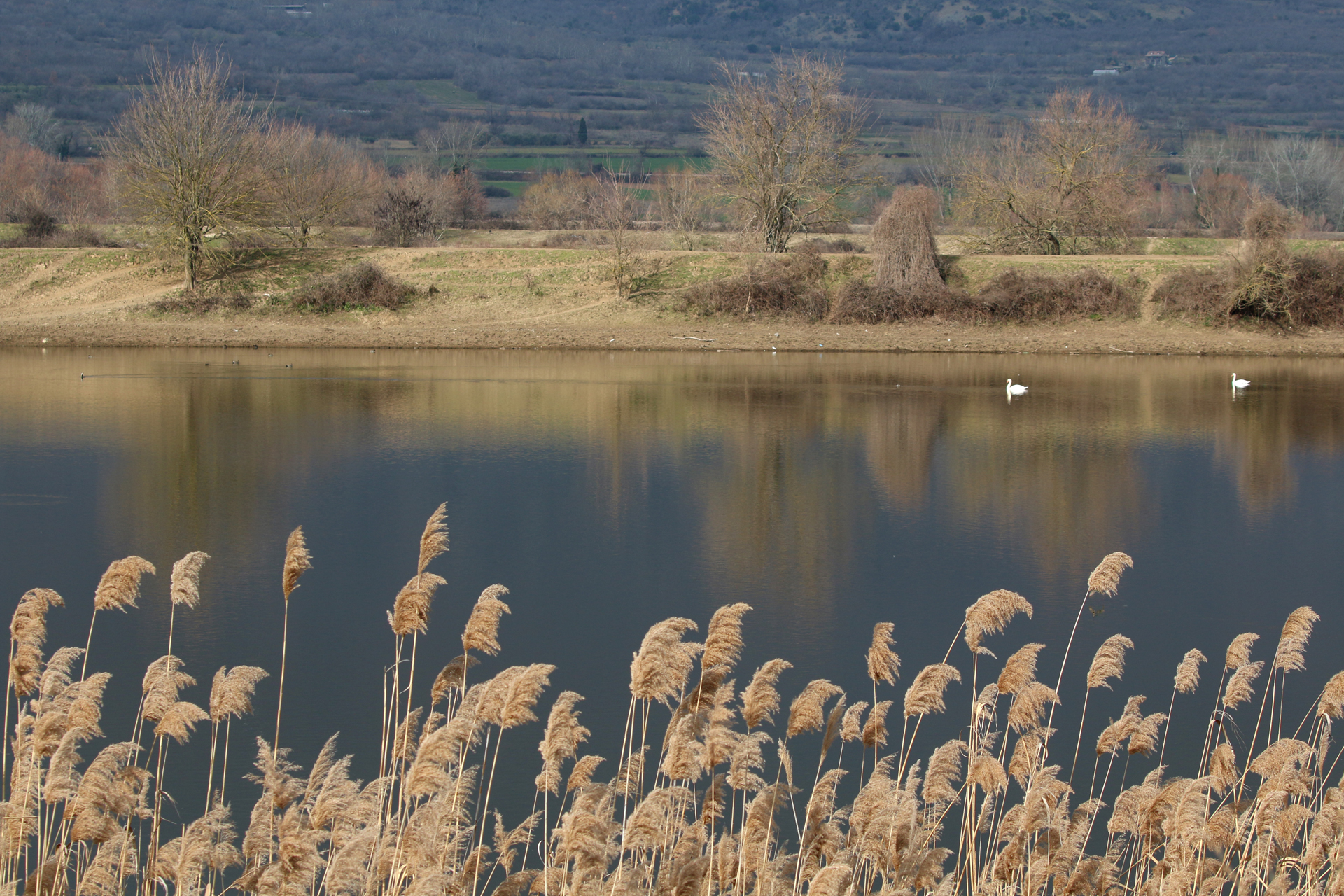
We linger a little longer along the northeastern banks, where the Strymónas river flows into the lake basin. The coves are as always crowded by many species of aquatic birds, while the nearby fields are carefully patrolled by a Hen Harrier.
It’s time to change area, another boat ride awaits us: this time in the company of Niko we explore the southern shores of the lake. As soon as we leave, we are escorted by some Dalmatian Pelicans and some individuals of Great Cormorant with showy breeding plumage, we therefore approach a platform used as a winter roost site by both species of pelican.
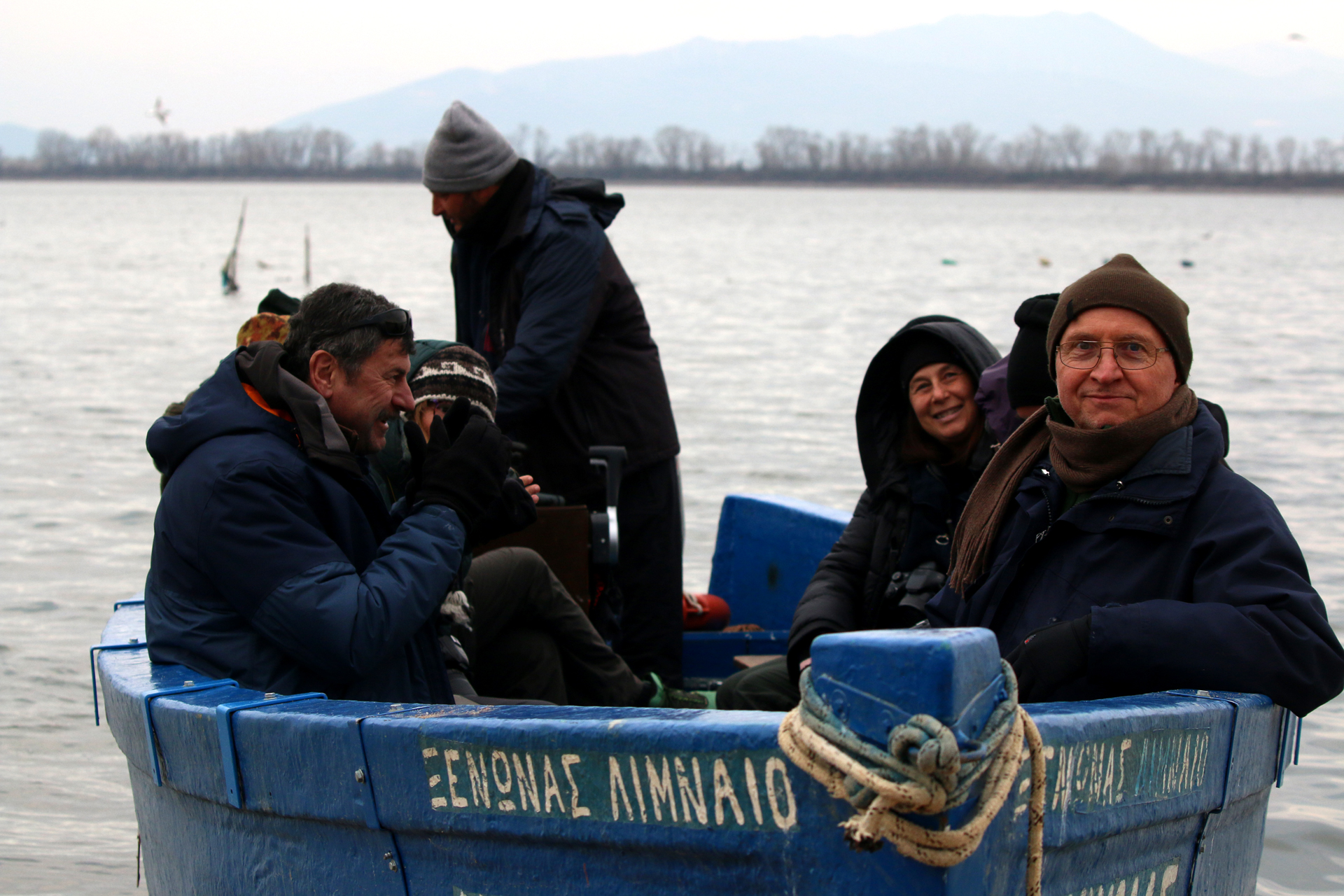
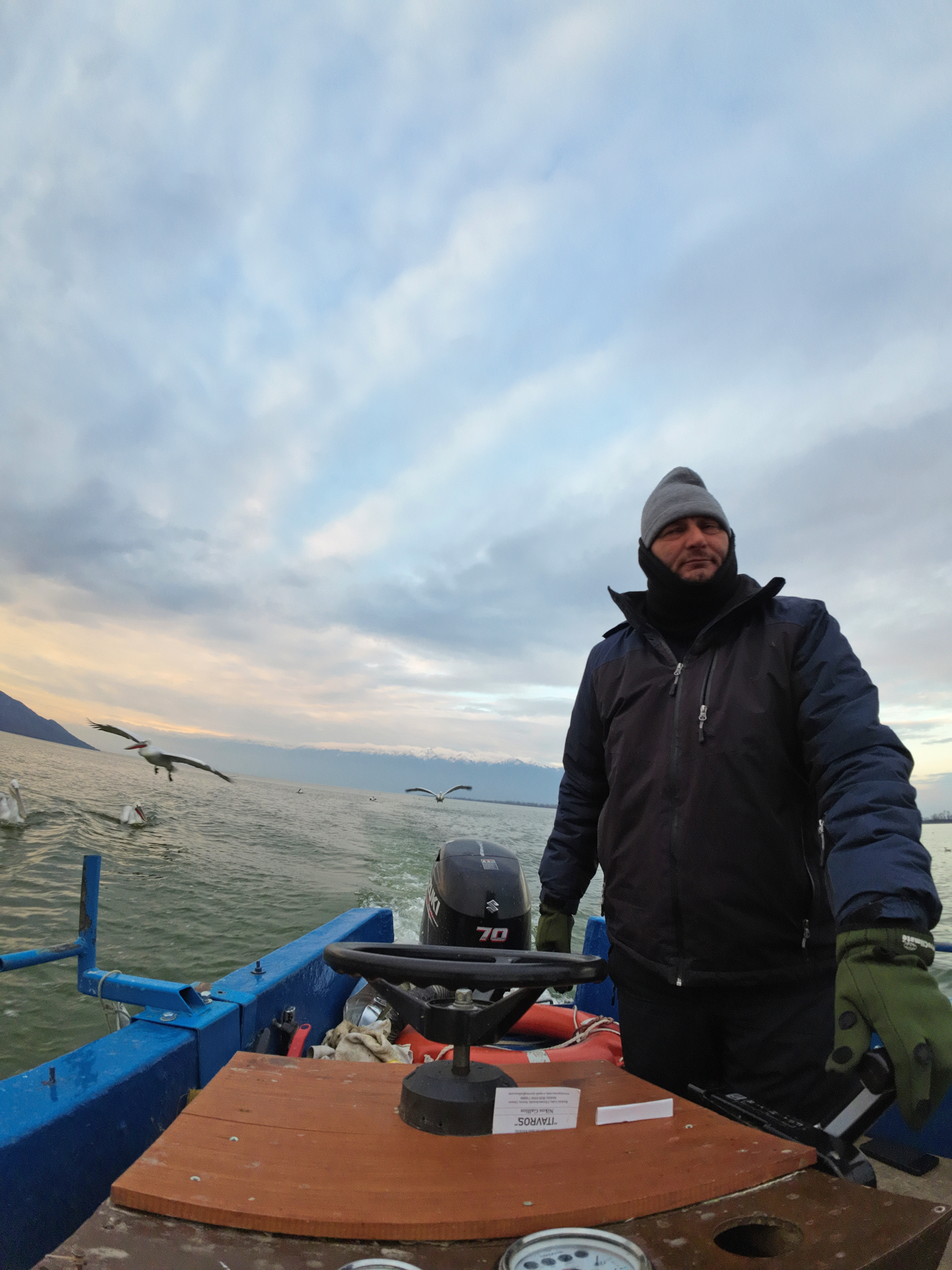
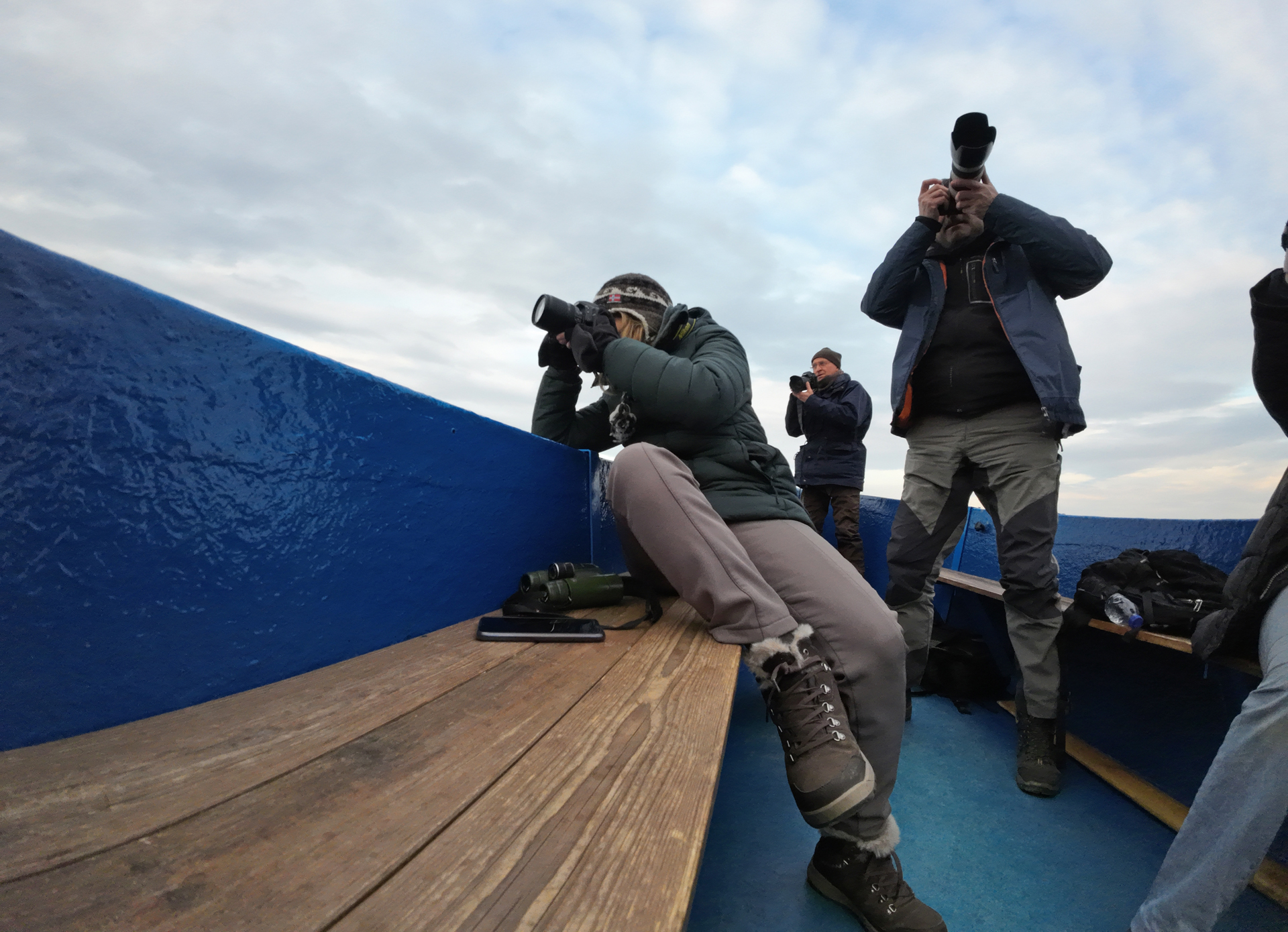
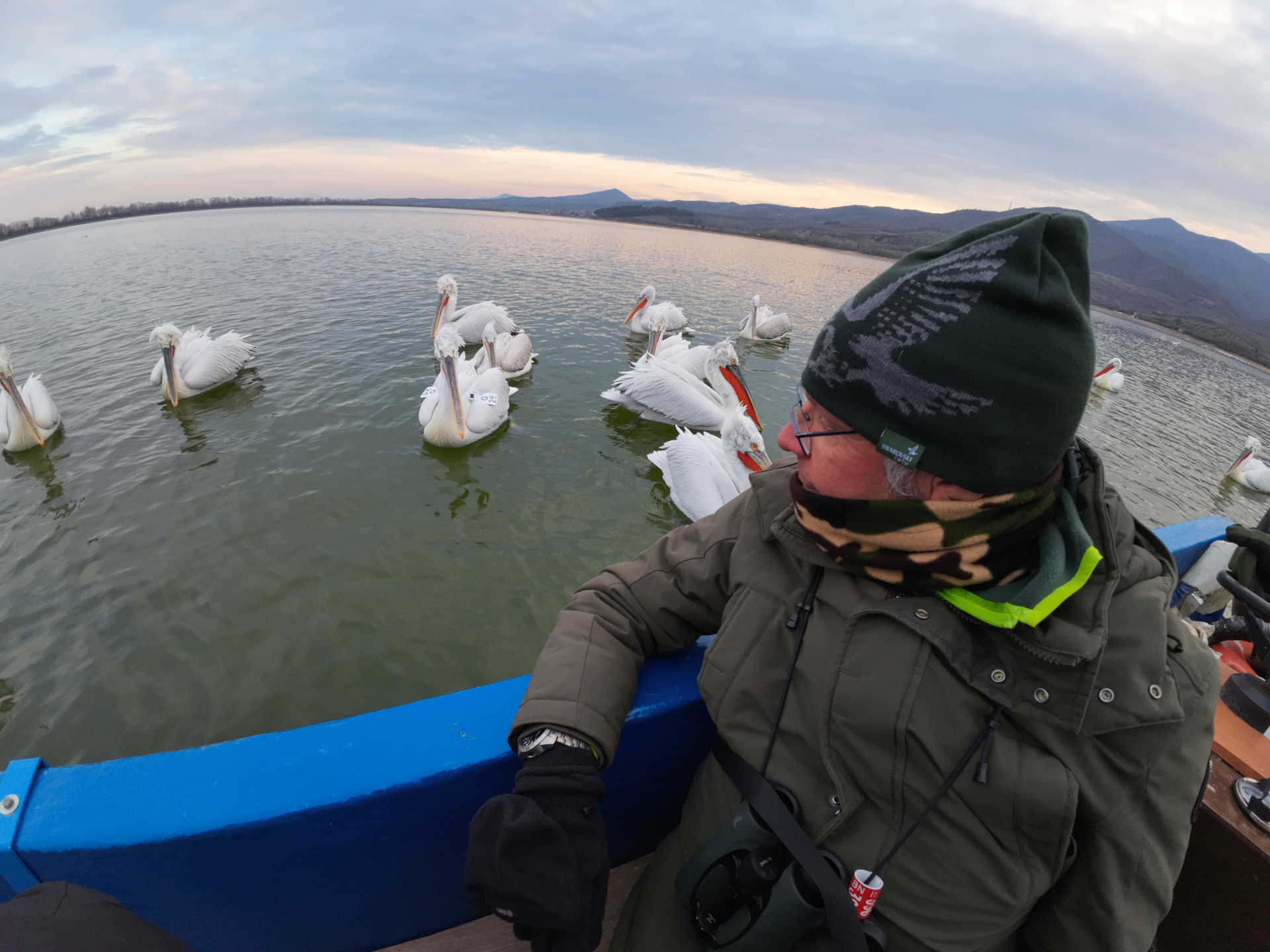
Great Cormorant. Photo by Doriano Spinelli.
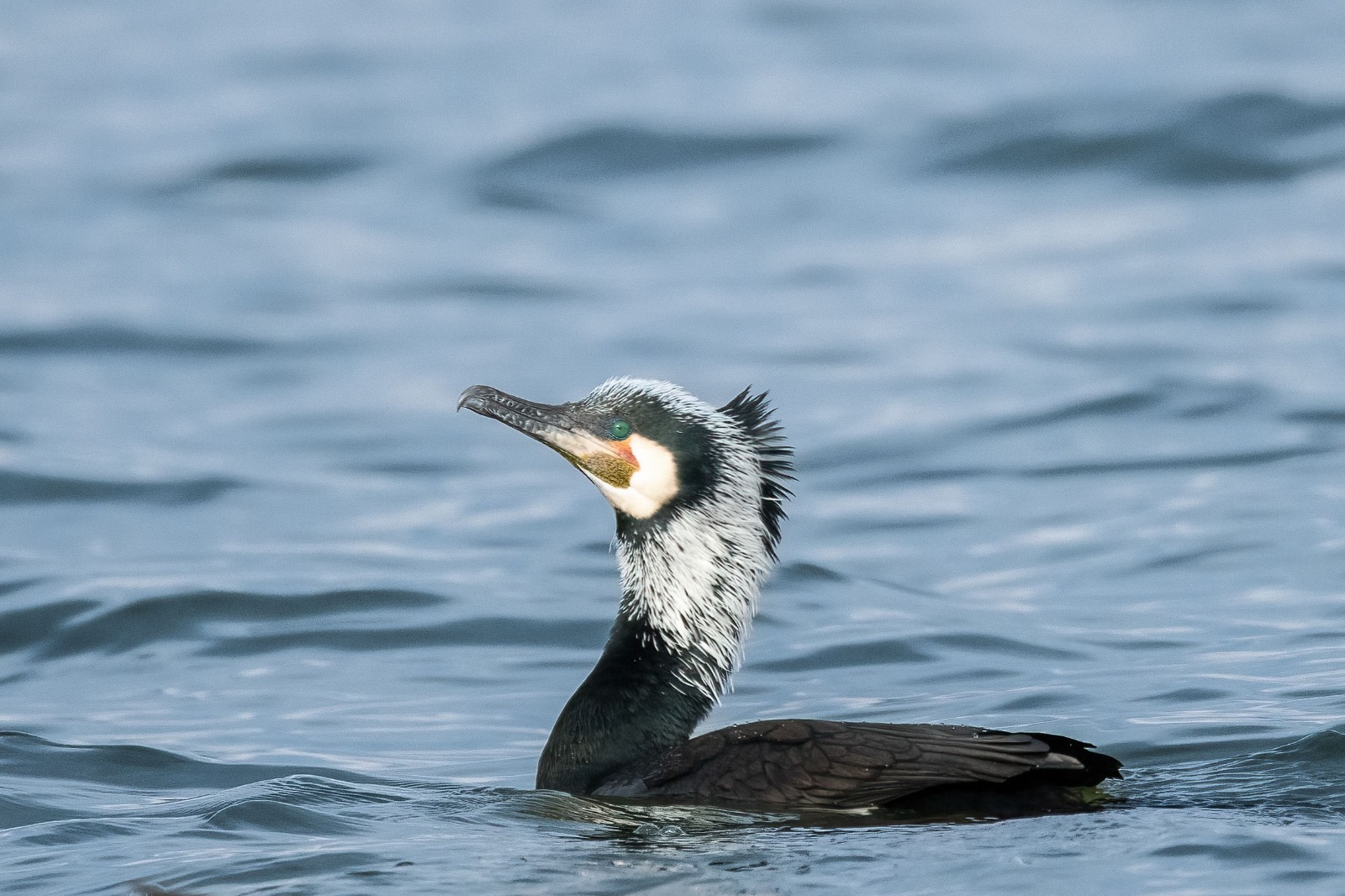
Here we have the opportunity to fully appreciate the differences between the Dalmatian and the White Pelican, a species that winters in Kerkini in increasing numbers in recent years, as well as immortalize the interactions between the different individuals present and their territorial disputes to grab the best places in the inside the platform.
Niko, a local expert in ecotourism and biodiversity, illustrates some critical issues that have recently affected the population of Dalmatian Pelican in Greece, first of all the avian flu which has mainly affected the reproductive pairs of the Prespa National Park, where resides the largest colony of the species in the world.
Details. Photo by Gaudenzio Conti.
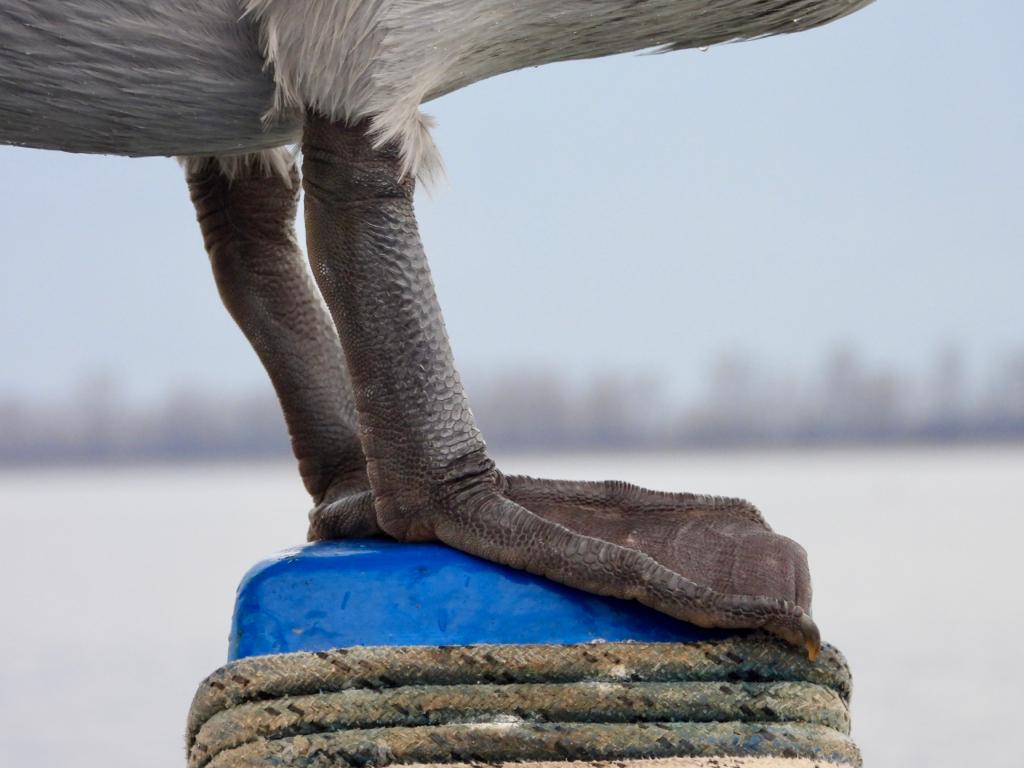
Great White Pelican. Photo by Andrea Senese.
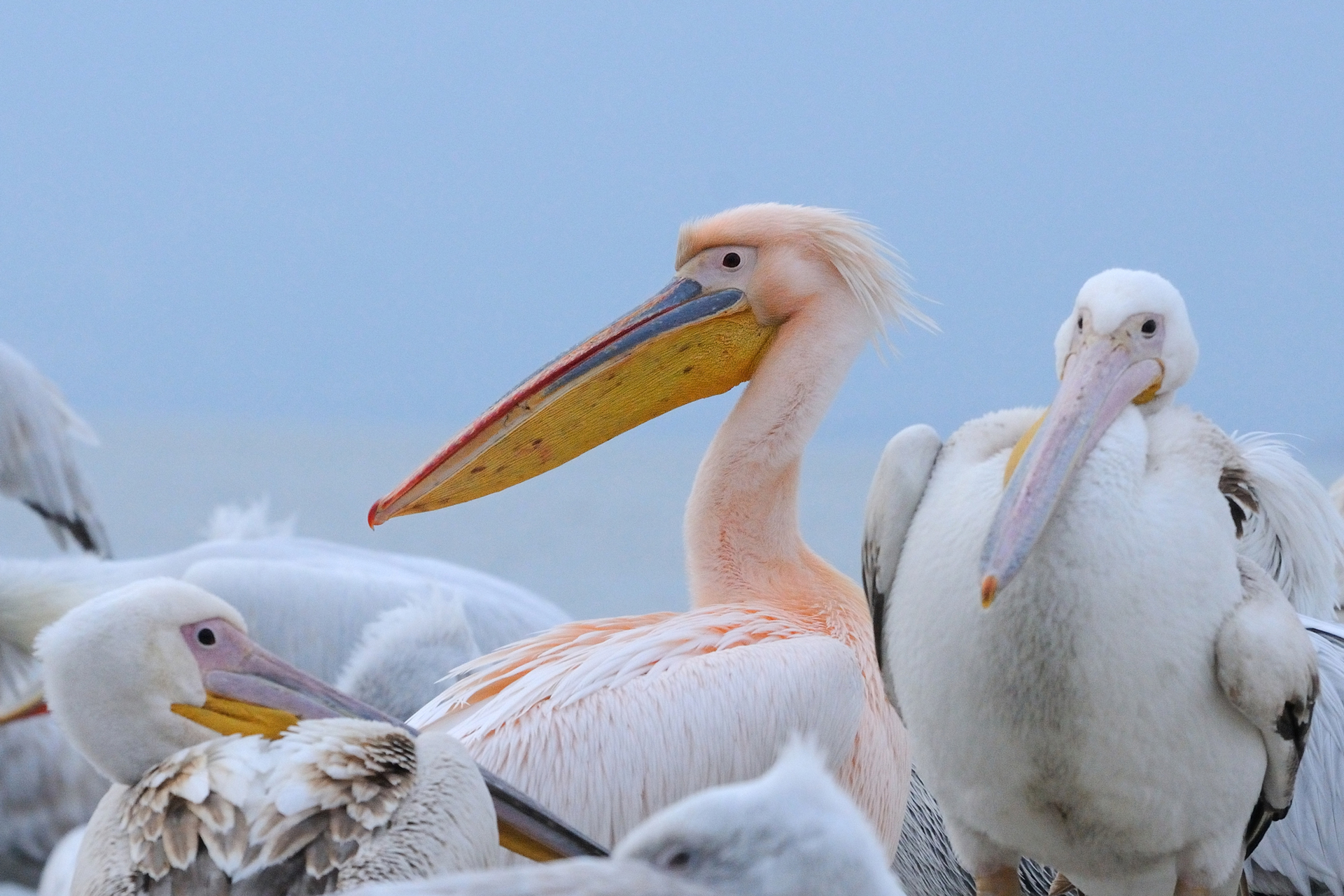
Compared cousins. Photo by Andrea Senese.
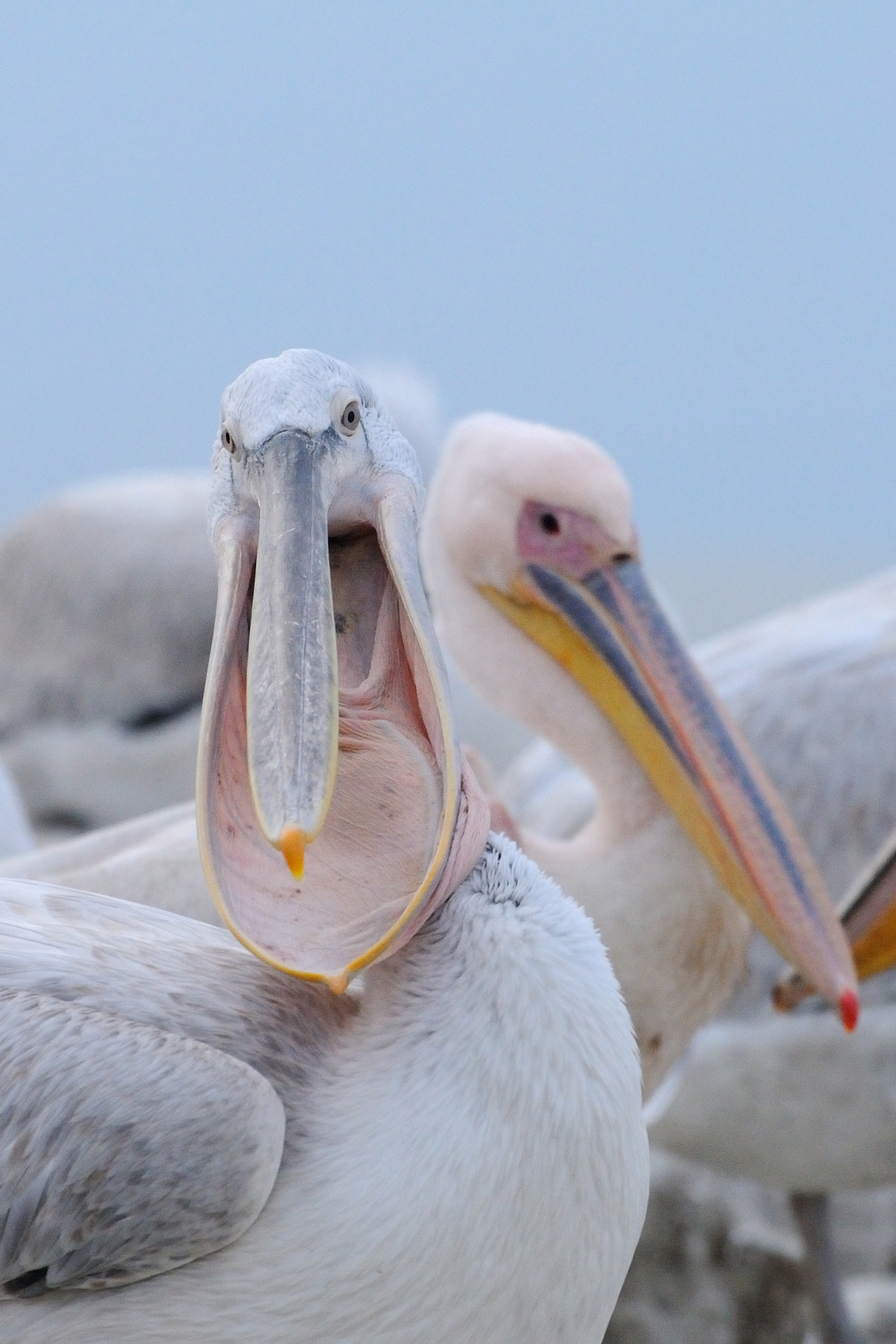
Dalmatian Pelican. Photo by Andrea Senese.
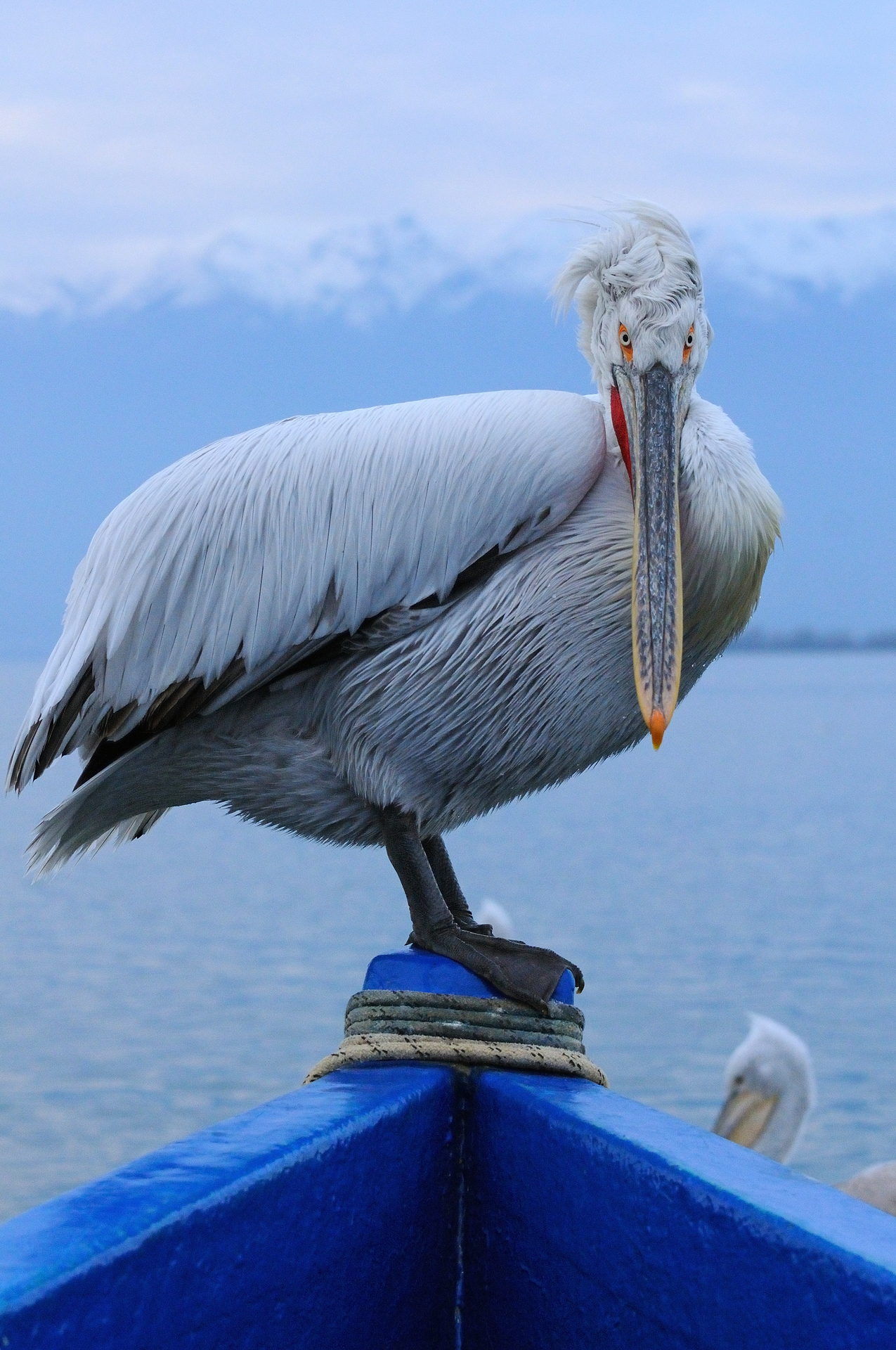
Dalmatian Pelicans. Photo by Antonio Bonini.
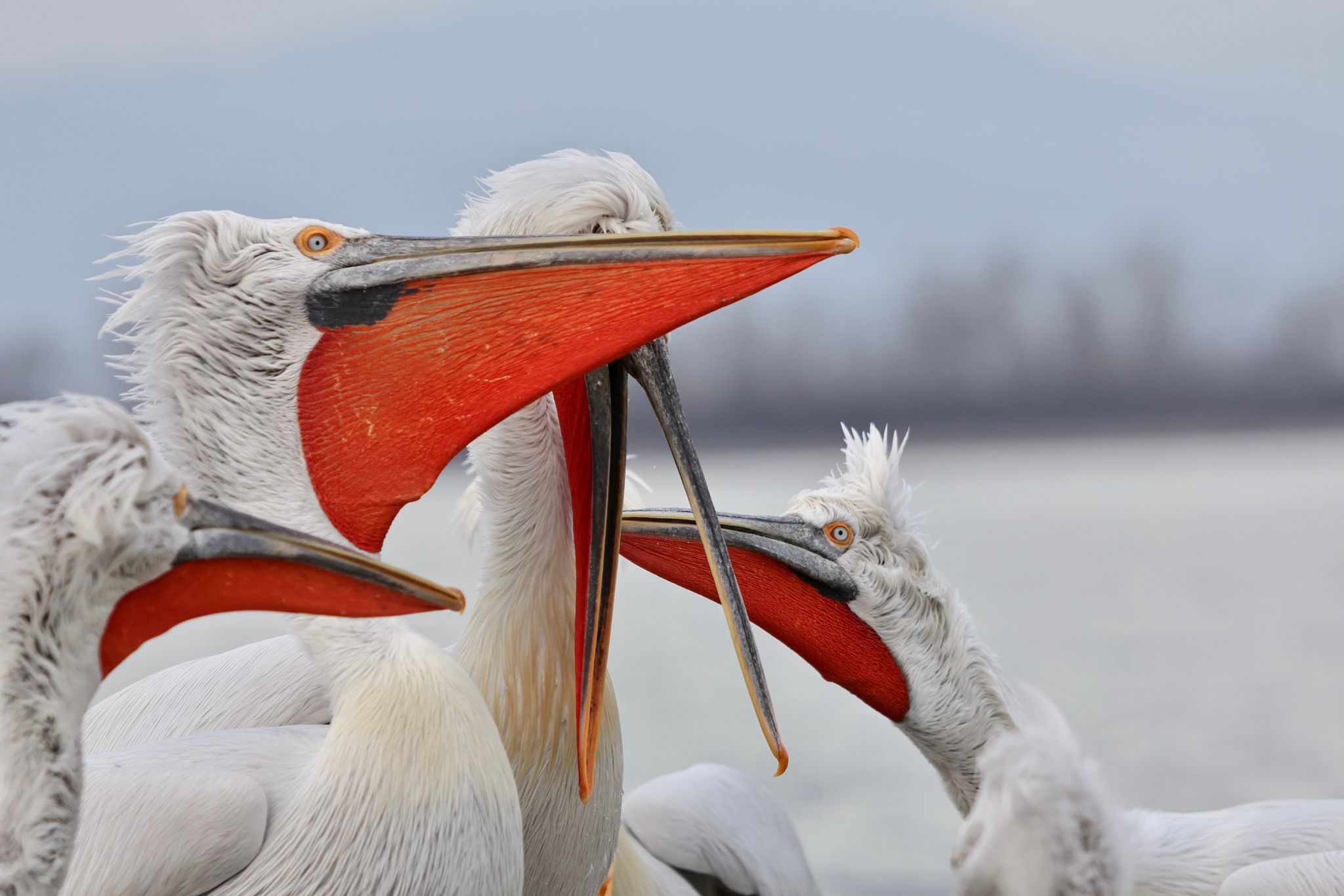
Back on land, before ending this long day with our last dinner based on Hellenic specialties, we immortalize some rather confident Great Egrets in the last light of sunset.
Great Egret. Photo by Valerio Russo.
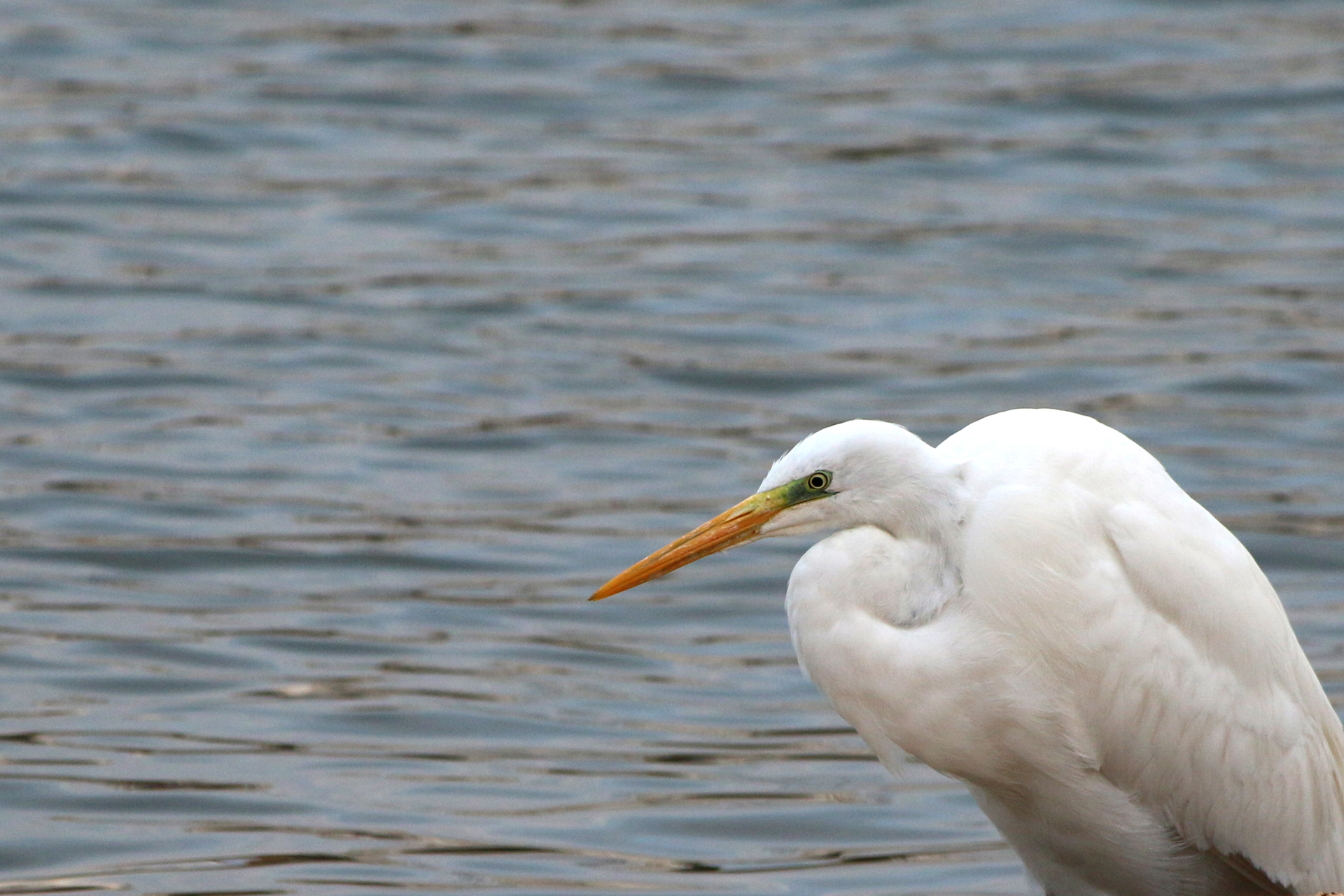
Great Egret. Photo by Valerio Russo.
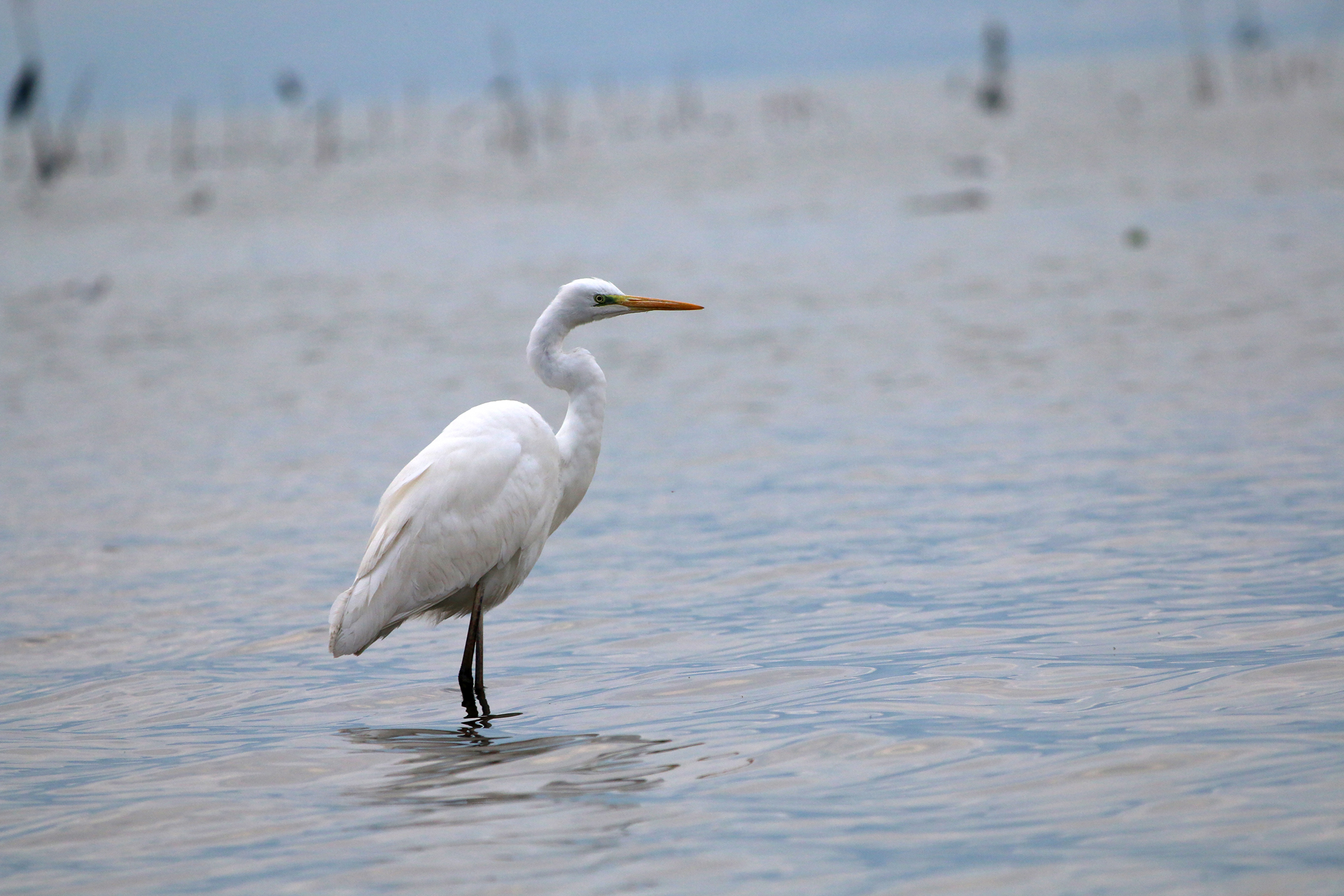
DAY 4
Morning of the fourth day, after a hearty breakfast it is sadly time to say goodbye to the Kerkini Lake National Park but still not satisfied with what has been observed so far we reach the last destination of the tour. In fact, we head south, a few kilometers from Thessaloniki, to explore the eastern area of the Axios Delta National Park in the last hours at our disposal, one of the largest and most important wetlands in the country, so as to investigate further environments and try to add the latest species to our checklist.
Spanish Sparrow. Photo by Doriano Spinelli.
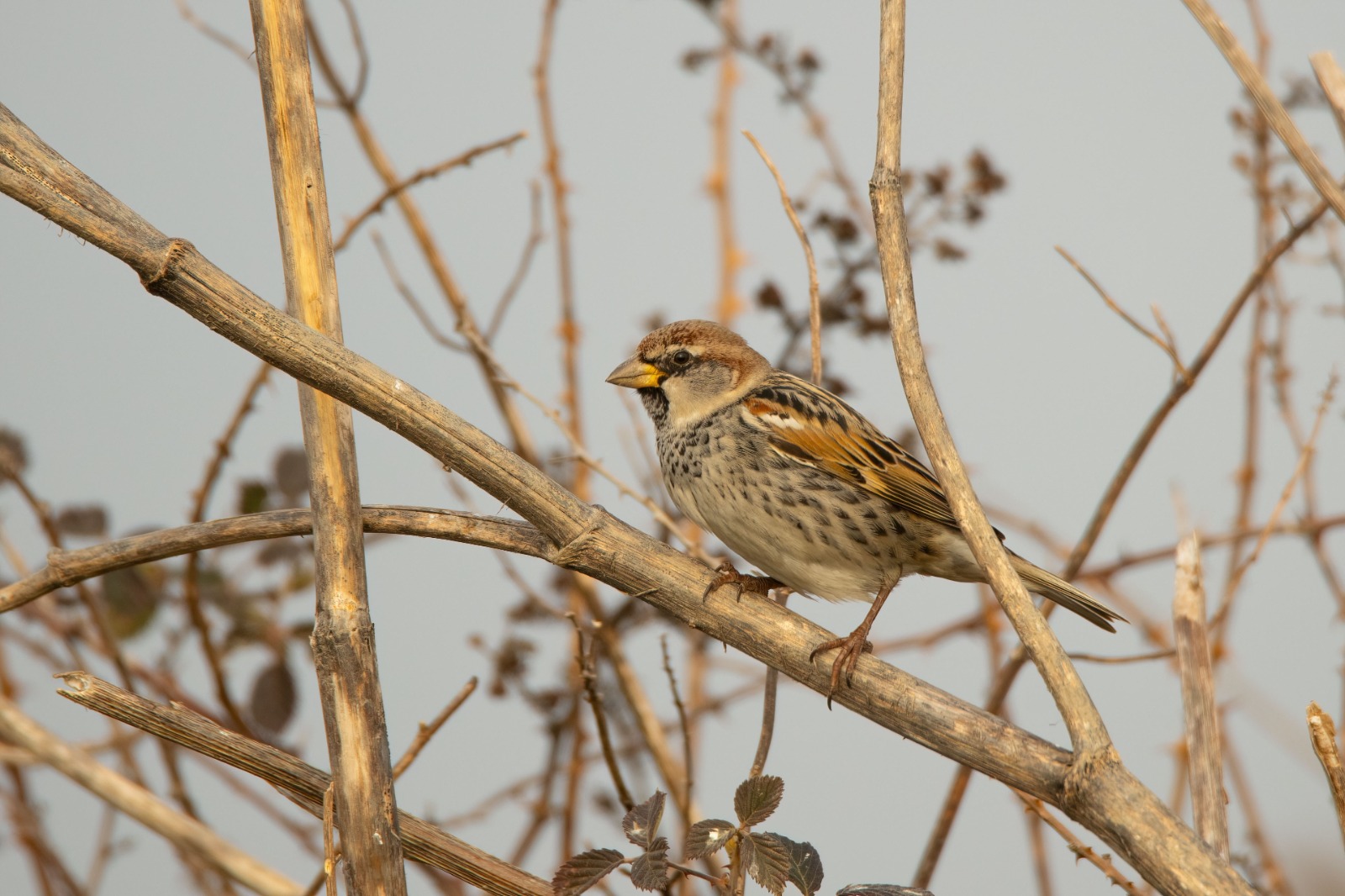
Spanish Sparrow. Photo by Gabriella Motta.
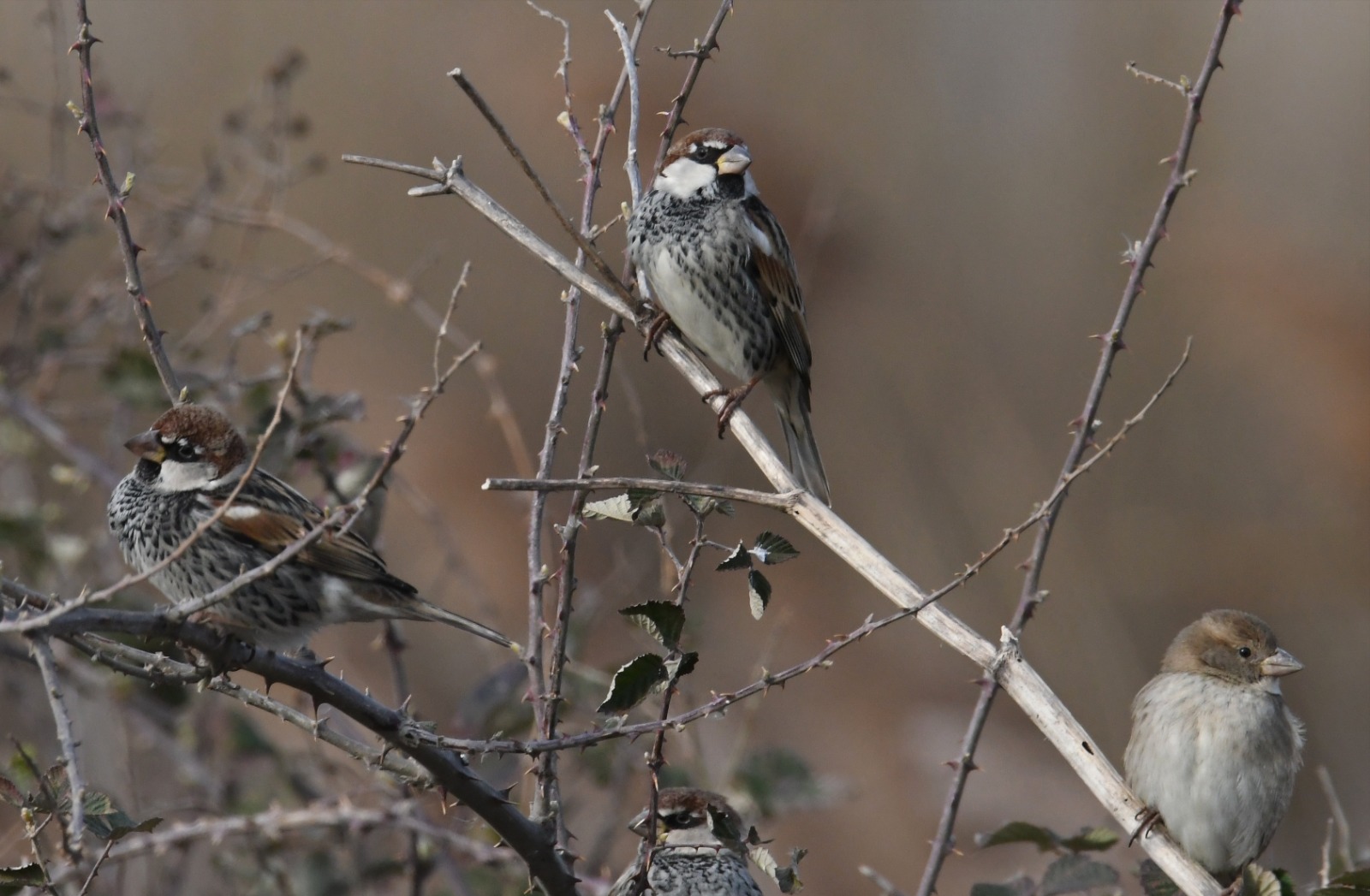
As soon as we arrive we are greeted by huge flocks of Spanish Sparrows (Passer hispaniolensis), more than 400 specimens crowd the rugged bushes and trellises that border the dusty streets of the Park, never seen such a concentration! Here a Sparrowhawk tries to take advantage of this abundance of prey, trying to hurl itself into a shrub and unleashing a general boisterous coming and going.
Along the stretches of water the warm colors of the glasswort contrast those of the Flamingos and Shelducks, creating a truly pleasant optical effect.
Greater Flamingos. Photo by Valerio Russo.
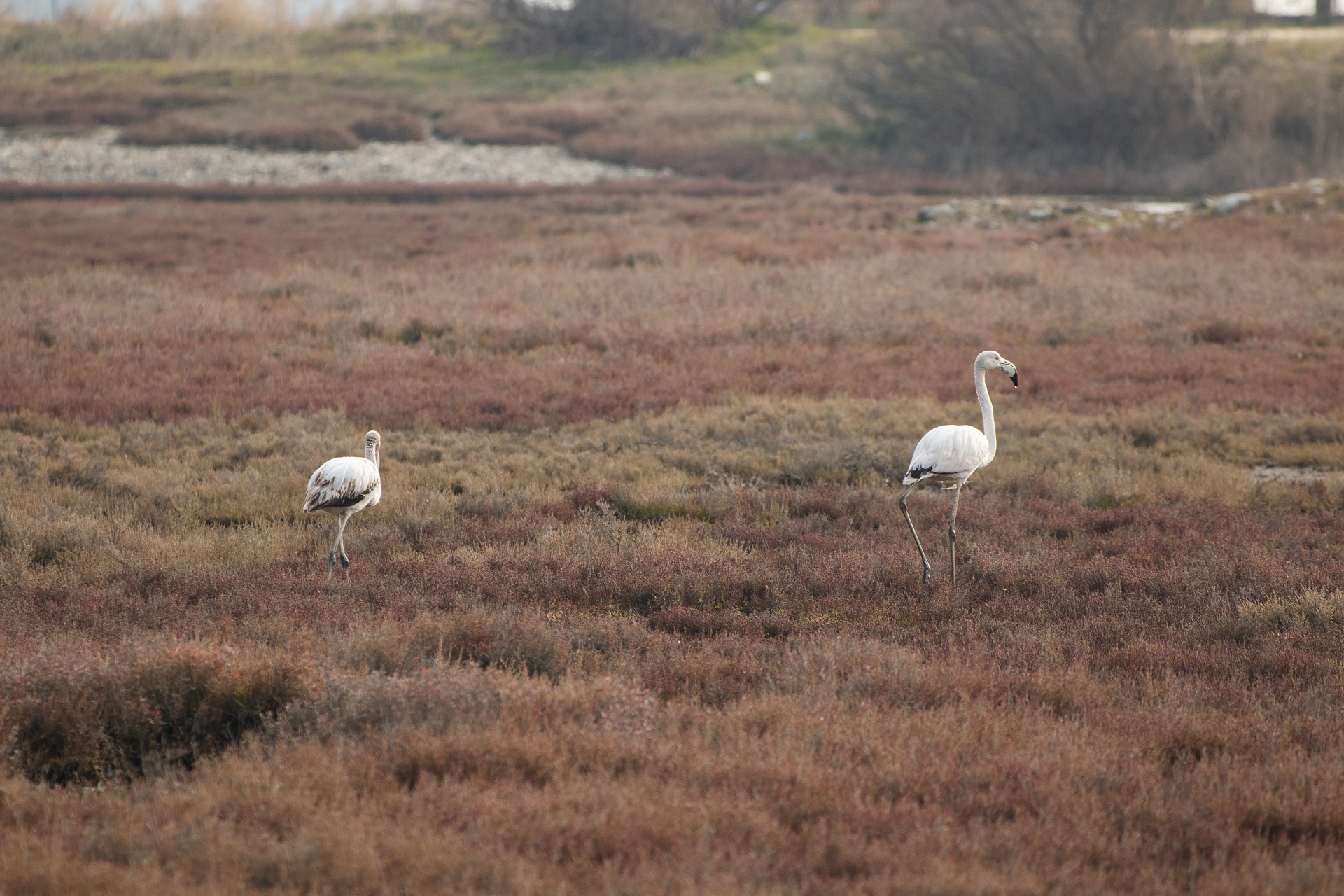
We therefore approach the coast line in search of new species: in addition to a small group of Pigmy Cormorants that rest on the typical wooden platforms used by local fishermen, we observe a Black-throated Loon (Gavia arctica), a species that regularly winters along the Thermaic Gulf.
Continuing to scour the muddy banks of the delta, we contact numerous species of waders looking for small invertebrates, including Green Sandpiper (Tringa ochropus) and Eurasian Curlew (Numenius arquata), while Common Redshanks (Tringa totanus) and Oystercatchers (Haematopus ostralegus) prefer to stop on stakes close to the sea.
Piro piro culbianco. Foto di Doriano Spinelli.
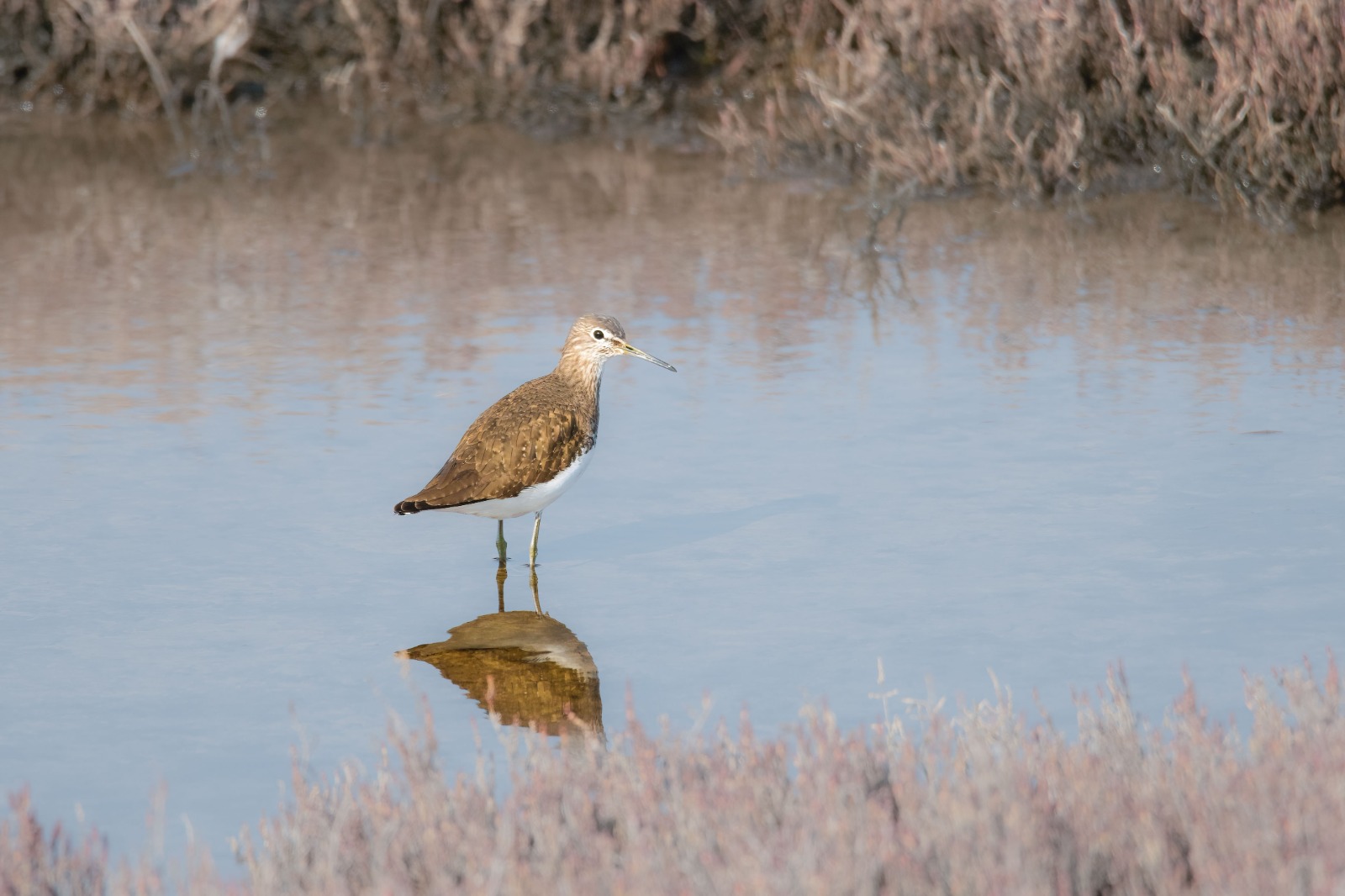
Chiurlo maggiore. Foto di Valerio Russo.

Along one of the canals that border the river mouth, a colorful Common Kingfisher (Alcedo atthis), too busy catching small fishes, is portrayed by the skilled hands of Cinzia, Doriano and Antonio.
Our winter tour in the Hellenic peninsula comes to an end, with a total of 105 species of birds (AND TWO WILDCATS) we say goodbye to the Axios Delta and its many inhabitants.
Extremely satisfied and happy to have enjoyed these intense days and to have shared endless emotions together with a very close-knit group, we head towards Thessaloniki for the final goodbyes.
Common Kingfisher. Photo by Doriano Spinelli.
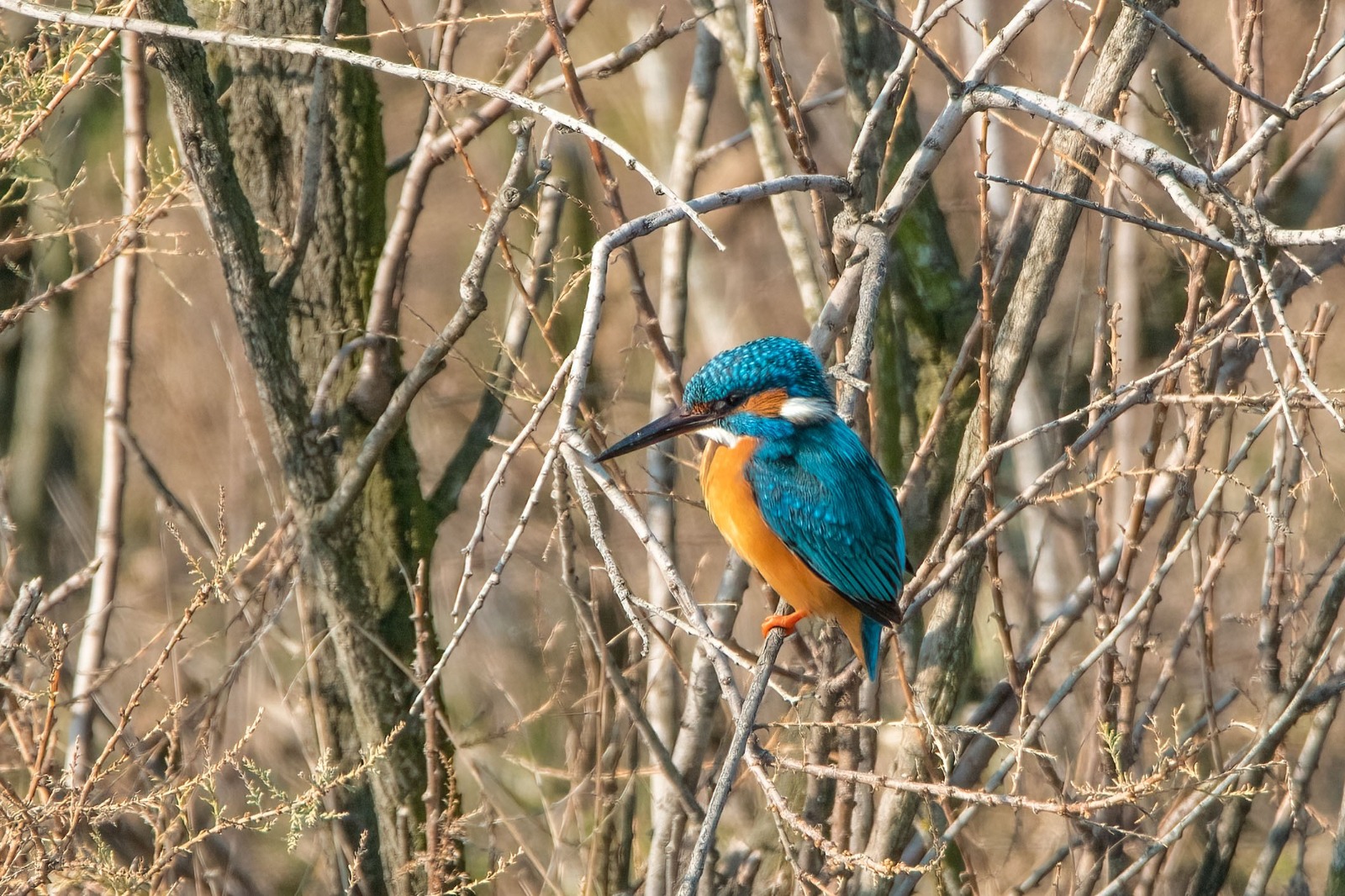
Crested Lark. Photo by Valerio Russo.
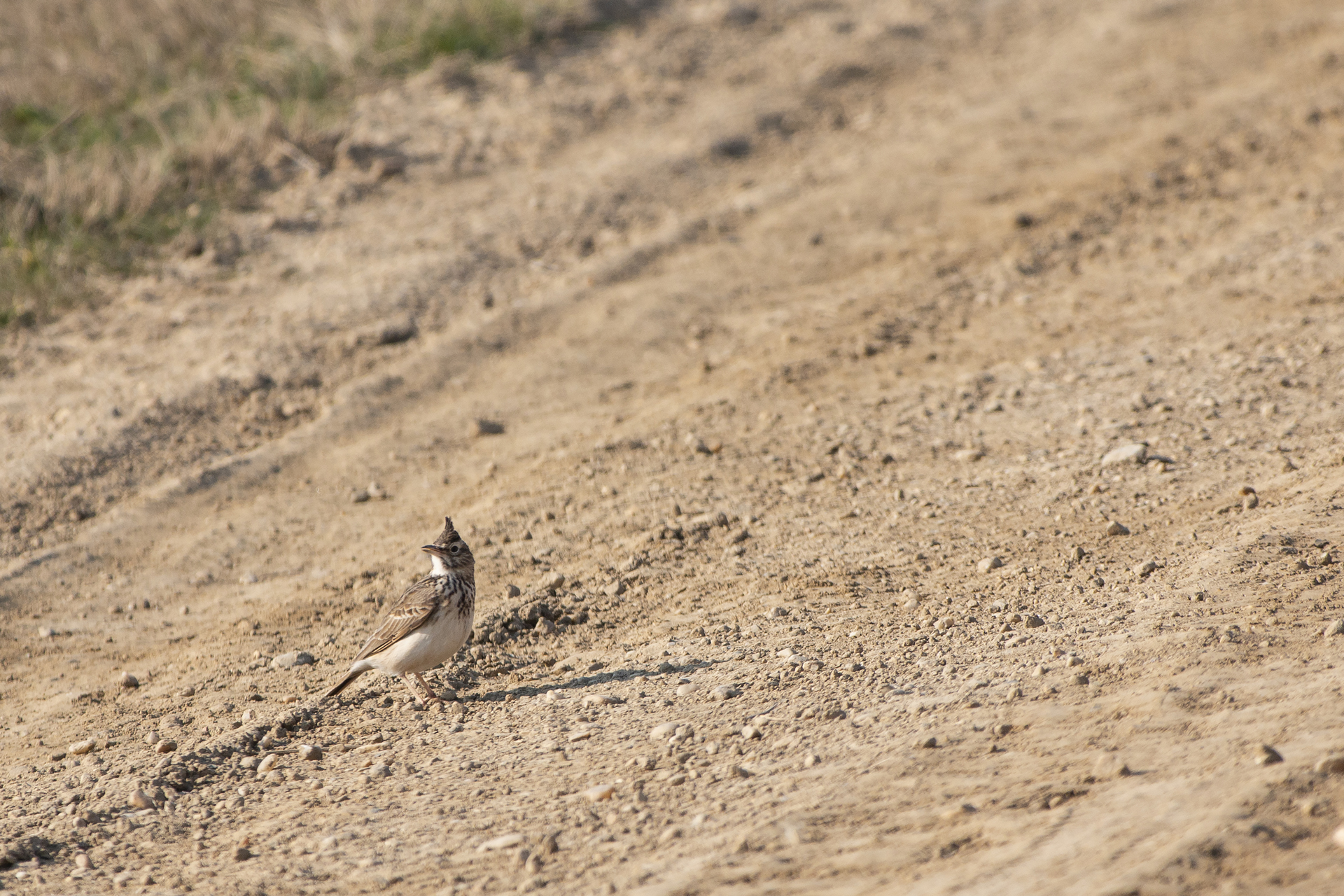
Once again, northeastern Greece is confirmed as one of the most interesting destinations in Europe for wildlife watching and nature photography lovers. We can’t wait to go back!
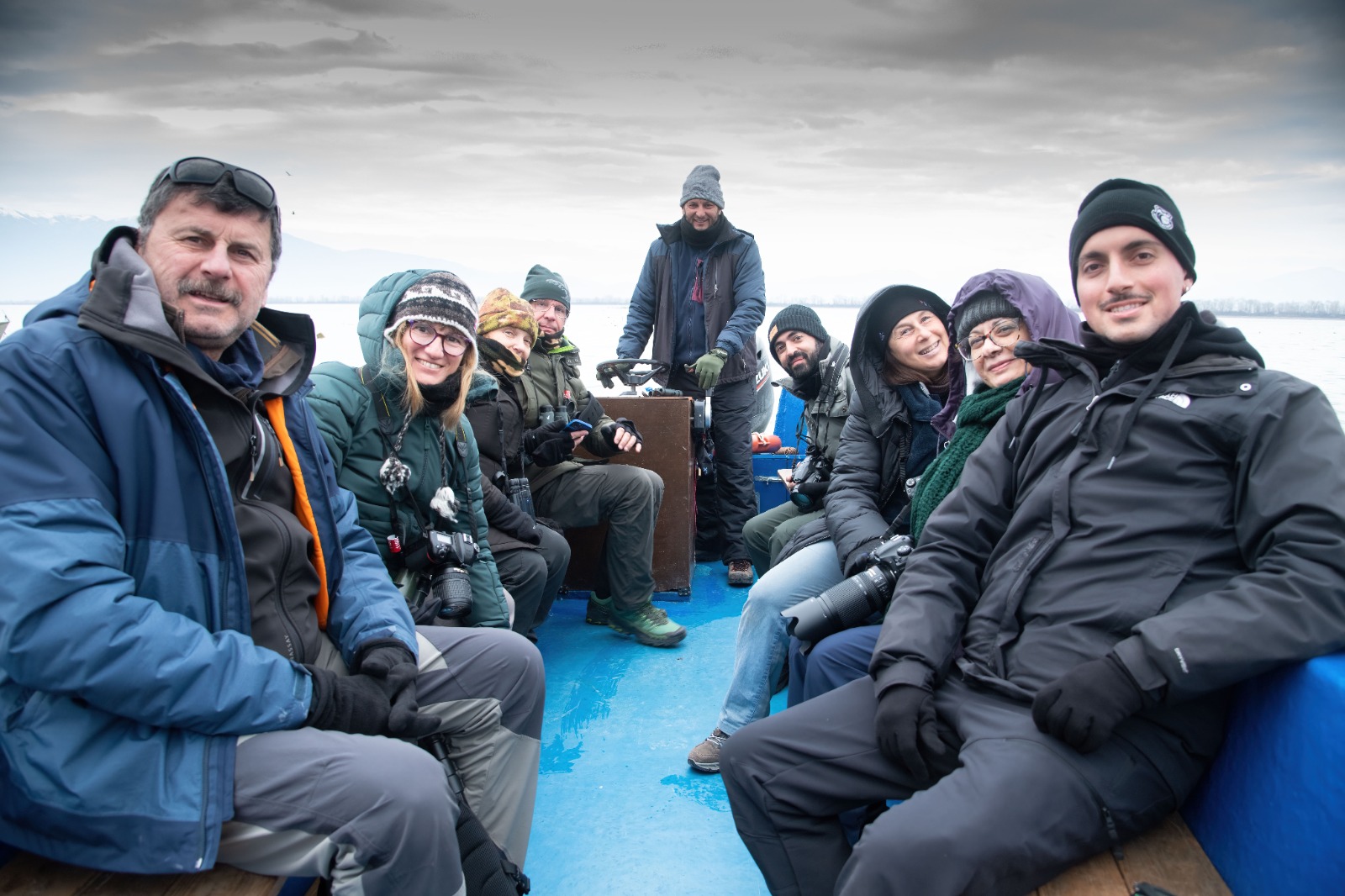
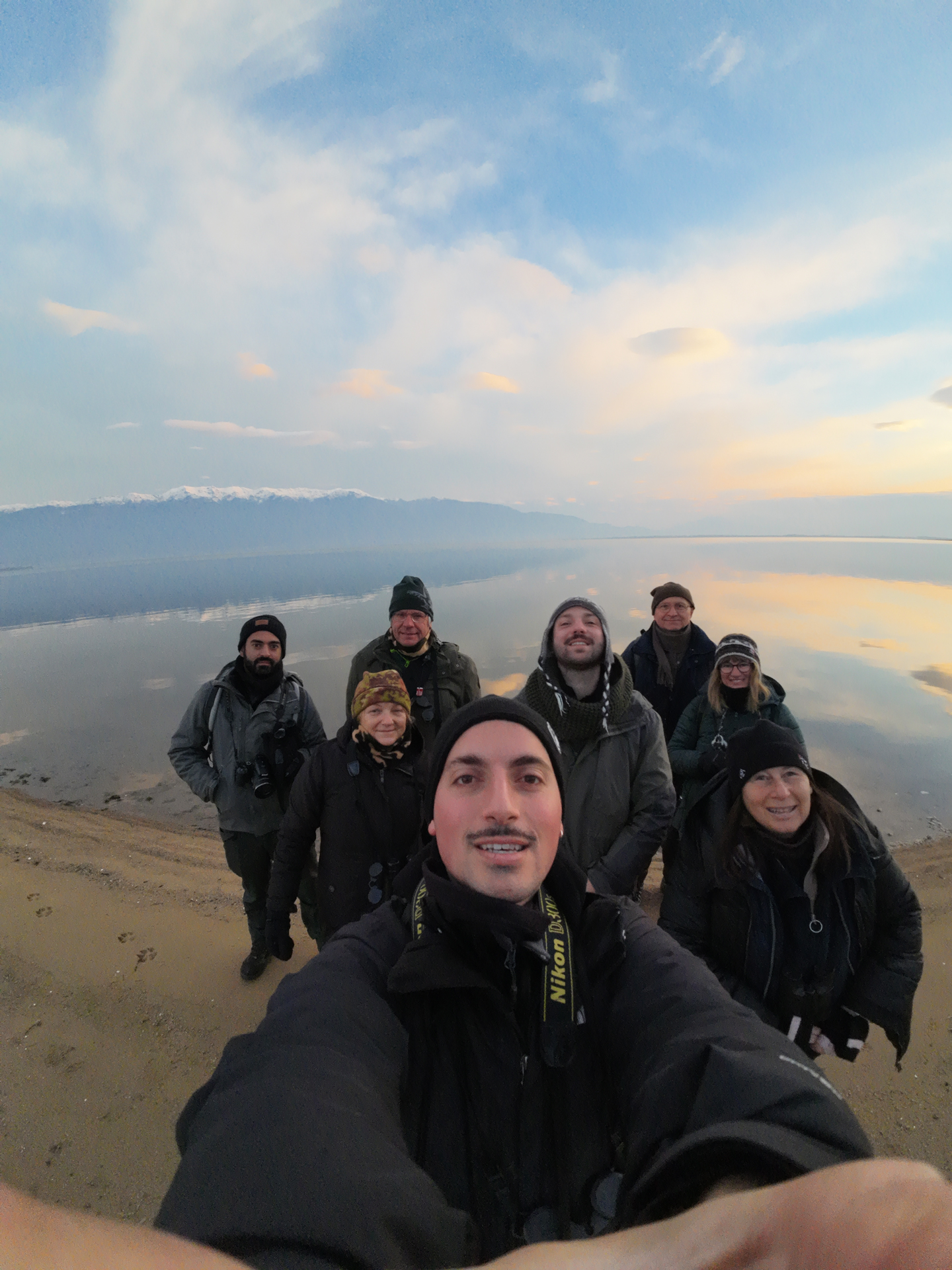
CHECKLIST
BIRDS:
- Mute Swan (Cygnus olor)
- Bewick’s Swan (Cygnus bewickii)
- Greylag Goose (Anser anser)
- Greater White-fronted Goose (Anser erythropus)
- Common Shelduck (Tadorna tadorna)
- Mallard (Anas plathyrhynchos)
- Northern Pintail (Anas acuta)
- Eurasian Teal (Anas crecca)
- Eurasian Wigeon (Mareca penelope)
- Gadwall (Mareca strepera)
- Northern Shoveler (Spatula clypeata)
- Common Pochard (Aythya ferina)
- Common Goldeneye (Bucephala clangula)
- Black-throated Diver (Gavia arctica)
- Little Grebe (Tachybaptus ruficollis)
- Great Crested Grebe (Podiceps cristatus)
- Black-necked Grebe (Podiceps nigricollis)
- Great Cormorant (Phalacrocorax carbo)
- Pigmy Cormorant (Phalacrocorax pygmaeus)
- Great White Pelican (Pelecanus onocrotalus)
- Dalmatian Pelican (Pelecanus crispus)
- Little Egret (Egretta garzetta)
- Great Egret (Ardea alba)
- Grey Heron (Ardea cinerea)
- Black Stork (Ciconia nigra)
- European Spoonbill (Platalea leucorodia)
- Greater Flamingo (Phoenicopterus roseus)
- White-tailed Eagle (Haliaeetus albicilla)
- Greater Spotted Eagle (Clanga clanga)
- Western Marsh Harrier (Circus aeruginosus)
- Hen Harrier (Circus cyaneus)
- Common Buzzard (Buteo buteo)
- Eurasian Sparrowhawk(Accipiter nisus)
- Common Kestrel (Falco tinnunculus)
- Merlin (Falco columbarius)
- Monk Parakeet (Myiopsitta monachus)
- Water Rail (Rallus aquaticus)
- Common Moorhen (Gallinula chloropus)
- Eurasian Coot (Fulica atra)
- Eurasian Oystercatcher (Haematopus ostralegus)
- Black-winged Stilt (Himantopus himantopus)
- Grey Plover (Pluvialis squatarola)
- Northern Lapwing (Vanellus vanellus)
- Little Stint (Calidris minuta)
- Ruff (Calidris pugnax)
- Common Redshank (Tringa totanus)
- Spotted Redshank (Tringa erythropus)
- Common Greenshank (Tringa nebularia)
- Green Sandpiper (Tringa ochropus)
- Common Sandpiper (Actitis hypoleucos)
- Eurasian Curlew (Numenius arquata)
- Common Sniper (Gallinago gallinago)
- Black-headed Gull (Chroicocephalus ridibundus)
- Common Gull (Larus canus)
- Yellow-legged Gull (Larus michahellis)
- Feral Pigeon (Columba livia domestica)
- Wood Pigeon (Columba palumbus)
- Stock Dove (Columba oenas)
- Collared Dove (Streptopelia decaocto)
- Tawny Owl (Strix aluco)
- Little Owl (Athene noctua)
- Common Kingfisher (Alcedo atthis)
- Greater Spotted Woodpecker (Dendrocopos major)
- Lesser Spotted Woodpecker (Dendrocopos minor)
- European Green Woodpecker (Picus viridis)
- Grey-headed Woodpecker (Picus canus)
- Skylark (Alauda arvensis)
- Crested Lark (Galerida cristata)
- Water Pipit (Anthus spinoletta)
- Meadow Pipit (Anthus pratensis)
- White Wagtail (Motacilla alba)
- Grey Wagtail (Motacilla cinerea)
- Dunnock (Prunella modularis)
- European Robin (Erithacus rubecula)
- Black Redstart (Phoenicurus ochruros)
- Common Stonechat (Saxicola torquatus)
- Song Trush (Turdus philomelos)
- Common Blackbird (Turdus merula)
- Sardinian Warbler (Sylvia melanocephala)
- Cetti’s Warbler (Cettia cetti)
- Common Chiffchaff (Phylloscopus collybita)
- Firecrest (Regulus ignicapilla)
- Winter Wren (Troglodytes troglodytes)
- Great Tit (Parus major)
- European Blue Tit (Cyanistes caeruleus)
- Long-tailed Tit (Aegithalos caudatus)
- Eurasian Magpie (Pica pica)
- Eurasian Jay (Garrulus glandarius)
- Western Jackdaw (Corvus monedula)
- Hooded Crow (Corvus cornix)
- Rook (Corvus frugilegus)
- Common Raven (Corvus corax)
- Common Starling (Sturnus vulgaris)
- House Sparrow (Passer domesticus)
- Spanish Sparrow (Passer hispaniolensis)
- Tree Sparrow (Passer montanus)
- Common Chaffinch (Fringilla coelebs)
- Common Linnet (Linaria cannabina)
- European Goldfinch (Carduelis carduelis)
- European Greenfinch (Chloris chloris)
- European Serin (Serinus serinus)
- Eurasian Siskin (Spinus spinus)
- Common Reed Bunting (Emberiza schoeniclus)
- Cirl Bunting (Emberiza cirlus)
- Corn Bunting (Emberiza calandra)
MAMMALS:
- Coypu (Myocastor coypus)
- Wild Boar (Sus scrofa)
- Red Fox (Vulpes vulpes)
- European Wildcat (Felis silvestris)
REPTILES:
- European Green Lizard (Lacerta viridis)
